GURPS Banestorm by Fossilized Rappy
"There are More Things In Heaven and Yrth, Horatio...": An Introduction to GURPS Banestorm
Original SA post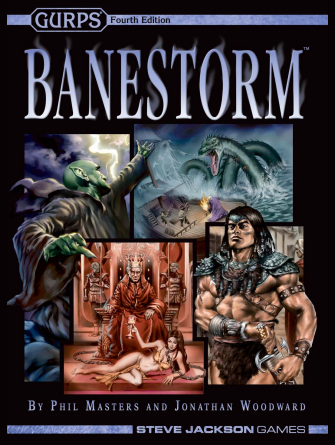
"There are More Things In Heaven and Yrth, Horatio...": An Introduction to GURPS Banestorm
As, yes, the wonderful land of Oerth. Or was that Urth? Erf?
Oh, right, Yrth . That's the one. It's the one that first appeared all the way back in Orcslayer (the second ever book to use the GURPS system), and continued on as the headliner of the GURPS Third Edition book GURPS Fantasy as Steve Jackson Games's answer to the various fantasy worlds of certain other roleplaying games. It also happens to be one of the few things that survived the great restructuring of product goals in GURPS Fourth Edition. As I noted in the final post of GURPS Technomancer, GURPS 4E has all but abandoned the idea of making a profit off of large, print-worthy length books at this point, and out of the few that do come around most of them are big on the Generic part of the Generic Universal Role Playing System moniker. GURPS Fantasy for Fourth Edition is no exception, being a generic guide to fantasy tropes and concepts as applied to GURPs.
There are still very rare exceptions make to have full-length setting books even now, of course. There are the upcoming GURPS Mars Attacks and Discworld titles, the at this point apocryphal GURPS Girl Genius, and the two that are actually tangible and capable of being seen right here and now. One is GURPS Infinite Worlds, which we'll probably talk about eventually beyond its pathetic section on Technomancer that I covered last time, and the other is GURPS Banestorm, which we're here to talk about right now.
GURPS Banestorm is the latest update and expansion of the Yrth setting. Once again it is set in the land of Ytarria, the northern continent of the planet Yrth, an alternate universe that was a generic high fantasy setting until the events of the infamous Banestorm. But that's old history, and it happens to be the history that is covered in the very first chapter of the book, so I guess we'll get right to it.
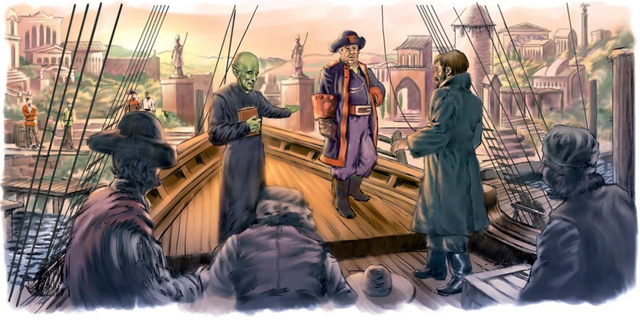
Chapter 1: History
Pre-Human Yrth
Long ago, the world of Yrth had no humans to claim it. The continent of Ytarria was originally home to squabbling tribes of elves and dwarves, both of whom had disdain for each other but an even greater hatred for the nomadic orcs. While these three species became less at odds as they developed civilization and eventually empires, there was always the undercurrent of tension. This tension ended up breaking the peace in the great western forest of Ytarria, where several particularly violent orc tribes hunted the local elves to near-extinction. Giving themselves the name Defenders of the Shaded Woodlands, the survivors become vicious warriors that began to exterminate the orc tribes around their forest in kind. After the killing was over, the racial supremacist beliefs began, and by 400 AD on the human calender the Defender troubadours had managed to work their way into eastern elven society well enough that they convinced the elven nations to go to war with the dwarven empire of Zarak. It did not go well.
Humiliated by the incident with the Zarakun people and seen with suspicion by their own people, the Defenders decided to lay off ever mentioning dwarves again. Instead, they began to focus all of their racist propaganda against the orcs. Of course, an entire species doesn't just lay down and die, and by 1000 AD the Defenders were looking for, and I quote, "a more final solution". Their greatest mages gathered together on the western edge of the great Ytarrian Forest in June of 1050 and performed a ceremony to create a spell to end of the orcs for good. Unfortunately for them, the resulting disastrous arcane force not only failed to target the orcs, it burned the western forests to a crisp, created a massive mana dead zone near the epicenter of the ritual, and introduced erratic storms that heralded dimensional breaches: the Banestorms.
The Banestorm
The Banestorm touched many dimensions and pulled a bevy of new species from various dimensions. Goblins, hobgoblins, kobolds, and reptile men came from the world called Gabrook, centaurs, giants, halflings, and minotaurs appeared from the realm of Loren'dil, merfolk and shark men came from the seas of Olokun, and humans were picked up from Earth. While species such as goblins and minotaurs adapted quickly to their new life and at least some elves were welcoming to their new neighbors, others were not so quick to adjust. The dwarves retreated into their mountain halls, the orcs fought back aggressively against the new invaders, and the mostly Crusades-era Christians and Muslims that formed the human communities had a great amount of difficulty learning how to deal with the existence of magic, monsters, spirits that called themselves gods, and being in close proximity of other opposed human cultures that were formerly distant concerns. And the Defenders themselves were stripped of their pride, their hopes for an elven supremacy, their social status, and even their names. No longer were they seen by the elven lords as the Defenders of the Shaded Woodlands: they were now Dark Elves, the evil Storm-Bringers.
Three major types of human civilization began to emerge in the land of Ytarria. The most powerful were the Christians of Europe, whose growth was fueled by rigid feudalism – kingdoms would pop up, gain a cult of personality, and then swallow weaker kingdoms into larger and larger dominions. While many followers of Islam became nomads once more, Abassid rulers shored up power as well, their scholars and imams keeping great storehouses of knowledge that are some of the most complete human records on Yrth. Third, and perhaps most strangely, powerful pagan clans of Norsemen and Celts took over the icy north and an eclectic mix of Native American and east Asian cultures created an empire known as Sahud in the far west. The disparate elements of these two lands seem to suggest that they were time-displaced as well as dimensionally transferred by the Banestorm, coming from periods before or after the Christian and Muslim Crusaders. In between these nations are scattered settlements and enclaves of Jewish, Slavic, Germanic, Indian, and sub-Saharan African cultures.
The Spread of Humanity
As the 10th Century drew to a close and the Banestorm seemed to finally slow its immigrant-belching to a halt, one human was forming big plans for the future. Simon Menelaus was a scholar, a charmer, and an archmage. With that kind of a resume, why not plan for world domination? And plan that he did, starting with the foundation of the city of Megalos in 1200 AD and the declaration of the Megalan Empire. Megalos swallowed up the goblin kingdom of Yibyorak and forced both their allegiance and their conversion to Christianity, the Knights Hospitaller and their kingdom of New Jerusalem swore fealty when the shrewd warlord Octavius Magnus convinced the Hospitaliers that their shared Christianity meant they had the common goal of spreading the word of God, and the Crusades began anew in 1360. In the end, four Crusades occurred between that year and 1525, but the victories in both land and converts were not as grand as any of the Megalan emperors might have liked. Indeed, the pressures of invasion caused the scattered Islamic kingdoms to forge themselves into three empires: the Sunni al-Wazif, Shi'ite al-Haz, and nondenominational al-Kard. While al-Kard fell to the Megalan Crusaders and was rechristened as Cardiel, the other Muslim nations stood strong and eventually forced Megalos to cut its losses and call a truce.
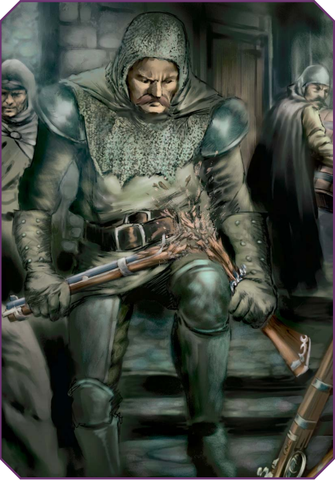
New Challenges
The seemingly invincible Megalos, like Rome before it, soon ended up falling foul of its own success. The death of childless Emperor Diophrates V in 1551 lead to a power vacuum that quickly snowballed from internal squabbles to a civil war, at which point al-Haz and al-Wazif both broke the truce and struck back at the empire who menaced them in centuries prior. Even worse, the Banestorm acted up again, dumping thousands of new humans onto the Araterre Isles. These new humans spoke of a new Christianity called Protestantism and its fight against the Catholic church, and held in their hands powerful weapons they called blackpowder rifles. Both of these things ended up causing the Megalan orthodoxy to have a collective "aw, hell no" moment, with its religious leaders fearing a schism, political leaders worrying what the presence of the Protestants would do to the entire concept of Megalos as the One True Christian Empire, and its battle mages being terrified of the idea that guns might level the playing field against them.
The Megalan Empire swiftly declared that gunpowder was a tool created through fraternization with Satan and that the Protestants were heretics. Just to make sure, the Megalan Navy was also dispatched to crush the spirit of Araterre, with Protestant inventors and priests being either mindwiped or murdered and a puppet government established over the islands. Those Protestants that escaped the purges mostly live in the tolerant reaches of Cardiel or locations far away from Megalos, practicing their science and religion in secret. The average citizen of Megalos has knowledge of firearms and gunpowder that only extends to it being Satanic and that you should contact your local representative of the Ministry of Serendipity if some dissident claiming they know how to make or use it happens to show up.
The acquisition of the Araterre Isles were the last piece of fortune the great empire would have, however. An attempt to annex the dwarves of the Whitehood Mountains in 1585 both failed and triggered trade sanctions by the dwarven empire of Zarak, Norse and Celtic raids in 1590 chipped away at northern Megalan holdings and forced the building of a great wall to prevent even further losses, Cardiel declared independence in 1788 after fighting back both Imperial and al-Hazi forces that both sought to claim it, and the county of Caithness was founded in former orc territory in 1822 only to rebel and declare its independence a mere four years later.
The Last Hundred Years
The passing of the 20th Century has only created more strife in the nations of Ytarria. There's been another war between al-Wazif and Megalos from 1924 to 1928, orcs have attempted to take back Caithness and conquer Zarak in more and more frequent raids, the Dark Elves have reappeared and begun to weave sinister and mysterious magics right under the nose of the Megalan Empire, al-Wazis and Megalos went to war again from 1991 to 1995, and Caithness has been locked in a civil war since 1999. It's now 2005 AD, and things aren't much better for nations other than Caithness. Piracy has risen in the south, the Northmen seem prepared to once again strike at northern Megalos, al-Wazif is thinking about having yet another Wazifi-Megalan war, and al-Haz is suffering from loads of internal strife.
Next Time in GURPS Banestorm: The people of Yrth, and some stuff on society.
Chapter 2: Life in Ytarria
Original SA post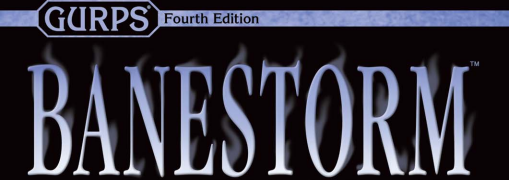
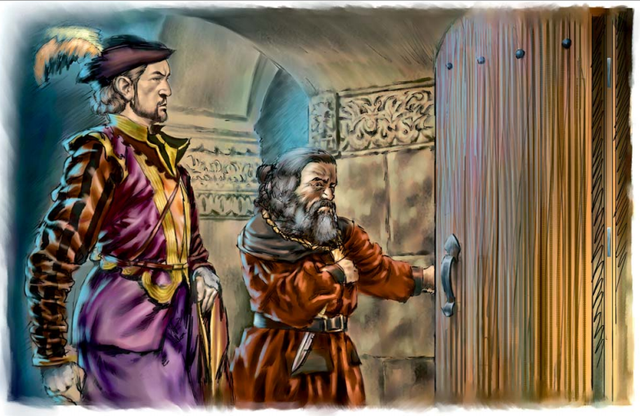
Chapter 2: Life in Ytarria
The People of Yrth
An introduction to a lot of the species "of renown" (some apparently less important beings like insect people and extremely 80s dolphins get covered in a later chapter) that are already native to Yrth or came through the Banestorm. While their stats and a bit more information attached to said stats are technically segregated from their descriptions here, being instead placed in the fifth chapter of the game, I'll discuss the two as if they were joined because screw orthodoxy when it actively hinders discussing things in a logical manner. I'll also of course be only listing attribute scores and secondary characteristic scores directly and paraphrasing most everything else, since copying stat blocks word for word is verboten by the GURPS rules even for reviews. That and it's less letter-consuming.
Dwarf
The people of the mountains, dwarves are stocky and slightly shorter than humans, not unlike the Neanderthals of Earth. They are best known as craftsmen and miners, as well as larger than life in their personalities: a dwarf's emotions are big , almost to the point of caricature, with personality traits such as a cheerful/violent temper, politeness/vulgarity, and grudges being worn on their sleeves. And boy, do the dwarven people ever hold some grudges. The unprovoked attacks the Dark Elves forced against them in the distant past, the annexation attempts by Megalos, wars with dragons over mining rights, and a long history of orc raids have all those species' on the dwarves' collective shit list. Most dwarves live in their nation of Zarak or the icy Whitehood Mountains to the north. They have all but abandoned some of their old strongholds in Megalos, and the once revered mountain known as the Fence of God was taken by al-Haz early on in the Banestorm immigrations when nomads found a perfect replica of the Earth's Kaaba deep in the mountains under the stewardship of an old Sufi mystic.
Dwarves are a 35 point racial template with a +2 to Strength and +1 to Health. Their natural beneficial traits are three extra Fatigue Points, tough and leathery skin that gives them minor damage resistance, a longer lifespan than humans, resistance to poison, natural crafting talent, and natural ranks in the Axe/Mace and Merchant skills. On the downside, they are slightly slower than humans, have big issues with being greedy penny pinchers, are stubborn, are intolerant of orcs, dragons, and elves, and are forbidden from taking ranks in the Jumping or Running skills. It is noted that some dwarves drop Greed and Miserliness, and that Night Vision, Honesty, and Agoraphobia are common but not universal traits for dwarves.
Gnome
Gnomes are literally just slightly thinner dwarves as far as physicality goes. Mentally, they are uncomfortable underground, which is why they branched off to live above the surface in the first place. Gnomes are the farmers to the dwarves' miners, the two coexisting to help Zarak remain a thriving kingdom that is rich in resources both above and below the ground. It is also socially expected of gnome men to trim their beards short, a way of further differentiating themselves from their dwarf ancestors. Mechanically, gnomes have a -7 point racial template, live slightly longer than humans (but not so much as dwarves), don't get either of the attribute bonuses dwarves do, have a self-imposed duty to nature, and get just a single bonus Fatigue Point, but they do at least get the dwarves' damage resistance skin, as well as a natural talent with diplomacy and agriculture. They can also actually get better at learning how to run and jump, which is probably helpful.
Elf
Thanks to the screwups of the Dark Elf faction, elves are both nearly extinct and distrusted by most of the native species of Ytarria, their political influence slim to none. Their great cities were abandoned even centuries before the Banestorm as they engaged in a self-imposed primitivist movement, but there's definitely no hope of reclaiming them now even if they wanted to. The remaining members of these slim, pointy-eared people live in small tribes deep in the wilderness, being content to cultivate new strains of plant and live a generally uncomplicated existence away from everyone else. The 41 point racial template for elves has a -1 to Strength but +1 to Dexterity and IQ, physical attractiveness, innate Magery 0, natural musical and artistic talent, a natural rank in the Bow skill, and agelessness, but also a strict elven code of honor (always have a reason for killing an animal or tree and don't cause them needless pain, don't be sloppy, strive for beauty and elegance in your life), and a sense of duty to nature. Half-elves sometimes happen if elves and humans get it on, and they produce a 27 point racial template that provides +1 IQ, the same innate magic sense as elves, and dwarf-length lifespans but not immortality.
Sea Elf
The sea elves are the gilled and webbed-digited oceanic counterpart to standard elves. Unlike the elves of the land, they never had any desire to leave their cities, and were instead forced into a nomadic existence when the Banestorm ripped apart their places of living when it dumped out species from the ocean world. Sea elves have a 51 point racial template that is mostly the same as elves, save for that they don't suffer a -1 to Strength, don't get musical talent, are amphibious (in the sense of being able to move on land as well as water), get a bonus to the Net skill rather than Bow skill, and can't speak or breathe in air. A minority of sea elves are genetic throwbacks that get to keep their lungs as well as their gills, allowing them to speak and breathe both above and under the water at the cost of increasing their point total to 66.
Orc
As one of the native species of Yrth, orcs are technically referred to as one of the Elder Races. Elves and dwarves absolutely hate that, though, and it's probably a horrible idea to bring up that fact around them. Your very stereotypical orcs. They're like big (I hesitate to say fat, since they're more that sort of mix of muscle and fat you see on weightlifters), hairy, fanged elves that primarily like to breed like rabbits, destroy things for fun, and are generally horrible. Tribal orcs practice slash and burn, but don't actually know it helps their hunting and agriculture, they literally do it because they find burning forests amusing and have not actually ever figured out that it is incidentally also beneficial. To put that into perspective, orcs have IQ -1, which is the same intellect penalty that GURPS gives to Neanderthals and to Stone Age humans. One of those two is our own species, who we should know well, and the other was a clever, creative, and innovative species with almost as much know-how as our own. Hell, even Homo erectus , which is IQ -3, theoretically could have been able to use controlled burning. And yet orcs are so caught up in their mustache twirling that they can't put two and two together about how their brush burning leads to better food yields.

Orcs are a -22 racial template that has +2 to Health and -1 to IQ and grants three extra hit points, slightly better than average hearing, and a free rank in Brawling, but is otherwise a mess of disadvantages. Specifically, orcs are innately bullies, intolerant to all non-orcs, have the social stigma of being barbarians, think of betrayal as a virtue, and defer to people who are stronger than them. Some, but not all, orcs can be lucky and get the advantages Acute Vision, Combat Reflexes, High Pain Threshold, or Rapid Healing, but there are also many that get extra disadvantages such as Bad Temper, Berserk, Gluttony, Greed, Sadism, and Unattractive (the book specifically doesn't give all orcs this, as some are stated to have "rugged good looks").
Some orcs are "civilized", trying to actively adapt to human society and buying off their Bully and Intolerance disadvantages. They're still looked down on no matter how hard they try, though, so even those orcs tend to live in the western territory known as the Orclands, where all but some of the most stubborn tribes of orcs went when humans pushed them out. Oh, and there are half-orcs too. You'd think they usually come from civilized orcs, right? Hahaha, no .
GURPS Banestorm, Italics in the Original Text posted:
Half-orcs are the offspring of orcs and humans. In most cases, the relationship was not consensual.
So yeah, for being a probable rape baby you get a 6 point template that provides +1 to Health, two extra hit points, barely better hearing than a human, and the social stigma of being a looked down upon minority.
Ogre
An evolutionary relative of orcs, ogres are 8 feet of big, hairy brute. Ogres are not innately violent don't go actively looking for fights, but they are more than willing to eat people if they happen to be hungry. Otherwise, they're just bigger and dumber orcs that have no civilization or social structure to speak of. The ogre racial template is 28 points and has Strength +10 (which costs less due to their increased size, as that's a GURPS 4E thing) and Health +3 contrasted by Dexterity -1 and IQ -3, a strong resistance to pain and decent resistance to magic, damage resistance from elephantine hides, and good nocturnal vision and smelling capabilities, but are also considered to be hideous-looking unlearned barbarians that are well-known to eat sapient beings.
Dragon
The last and most mysterious of the Elder Races, dragons are also the only ones I'm actually going to wait to cover. This is because they have a whole long section later on in the bestiary, more than the minor repetitive blurbs and stat blocks that the other species here get in chapter 5. Suffice to say, they're really big, really smart, and really mysterious, and nobody is sure why they do any of the strange things they do.
Human
Us. As per RPG conventions, humans are the blank slates, having no innate racial template traits and thus not beholden to using up any of their point buy on innate species features.
Goblin
Goblins are one of the three native sapiens of the desert world of Gabrook that found part of their population dumped on Yrth. They are thin and have green skin, large pointed ears, and sharp teeth, but are otherwise pretty human in appearance. As noted in the history of Yrth, the goblins once had their own kingdom known as Yibyorak, but it was conquered by the expanding empire of Megalos. As a result, most goblins are now Megalan citizens and practicing orthodox Catholics. There are some Muslim and pagan goblins in other nations, but they are a decided minority, and even small groups of nomadic goblin merchants encountered on the trade roads are typically Christian. Rather interestingly, while they have no innate Magery, goblins take to learning magic exceedingly well. Goblins have a 19 point racial template that grants +1 to Dexterity and IQ but -2 to Strength and extremely good night vision, but also an impulsive streak.
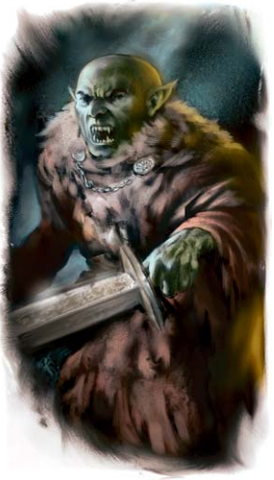
Hobgoblin
Big, brutish versions of goblins, supposedly closer to their common ancestor in appearance and demeanor. They don't care much about material goods, using shitty rags and hides for clothing and either handmade or stolen weaponry, and are also typically isolationist even towards other hobgoblins not part of their individual tribe. While they do sometimes go pillaging, hobgoblins don't have the social stigma of being barbarians due to the fact that they don't have the active evilness and love for destruction that orcs have. The hobgoblin racial template is -15 points and has +1 to Strength and Dexterity but -2 to IQ, provides a free rank of Brawling and superior night-vision, but also gives the disadvantages of being ill-tempered and stubborn.
Kobold
The last and strangest of the goblinoids (save for one that isn't covered at all in this section, but we'll get to that when we get to that), kobolds are dumb blue shitheads that swarm in cities and are typically either lazing around doing nothing, wandering, or enjoying slapstick humor at the expense of others. While they will sometimes take menial jobs, they are more comfortable mooching or thieving, as they find things that aren't food, sex, or jokes involving pain boring. Kobolds have a -60 point racial template that has +1 Dexterity but -2 IQ and Strength, -1 to Willpower, resistance to disease and the ability to eat garbage food, a short attention span, fragile ego, and the social stigma of being uneducated morons.
Reptile Man
8 foot tall humanoid lizards that are also native to Gabrook. While most reptile men are quite reasonable folks and there are even large groups of devout Muslim reptile men in al-Haz, humans and goblins are often wary due to the fact that some tribes of particularly savage individuals in the Great Desert of western Ytarria are anthropophagous barbarians. Human nervousness towards them isn't helped by the fact that they have great difficulty speaking languages other than their own and their claws and teeth are always at the bare. Reptile men are a 58 point template that grants Strength +4 and Health +2 but -1 to IQ, sharp teeth and claws, heat tolerance, slightly longer lifespans than humans, damage resistance thanks to their thick scaly skin, a wide field of vision, free ranks in Camouflage and Survival, shyness, the social stigma of being barbarians, and an inability to speak languages other than their own without a thick accent.
Centaur
Centaurs are one of the four races of Loren'dil, a verdant world of massive forests interspersed with thick meadows. It was particularly hard for centaurs to adapt to Ytarria, as they had (and to some extent still have) great difficulty understanding the concept of non-nomadic species and the existence of horses (originally seen as deformed or maimed centaurs) both confused and horrified them. Scattered herds live a pastoral existence across the plains of al-Wazif, al-Haz, Cardiel, and the northern limits of the Orclands. While rare, there are occasions when a particularly wise and patient centaur will settle down in a civilized area and interact with other species, even sometimes rising to positions of power as advisers to royalty. The centaur racial template is 100 points and provides Strength +8, Health +2, and +1 Perception but -1 IQ, improved overall movement speed plus fast running, four legs that end in hooves, and greater Willpower saves against fear, with the disadvantageous traits being that centaurs are impulsive and overconfidence, fond of partying, and are deeply offended by domesticated horses and all the equipment associated with them such as saddles and stables.
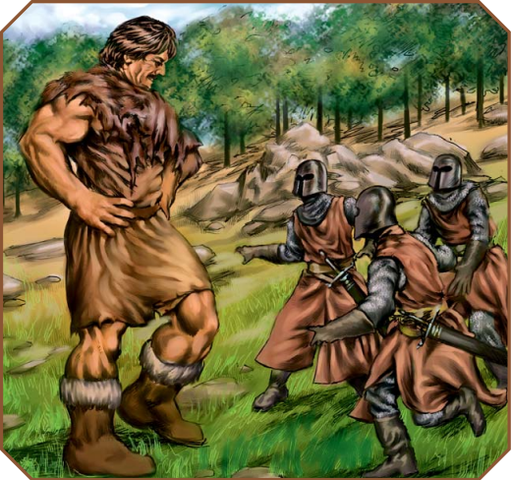
Giant
Giants are, as their name implies, giant – muscular human-looking beings typically 9 or 10 feet in height. This is just a standard rather than a species rule, as there are often giants with random stranger features such as one eye, multiple arms, multiple heads, or even greater sizes. They are isolationist and unconcerned with most comings and goings of other species, preferring to live in their houses out in the wilderness of the cold north or the Orclands. While most giants aren't out to get anyone, disturbing their peace or comparing them to ogres are both quick ways to trigger their fiery tempers and get a tongue-lashing at best and a messy and violent altercation at worst. Other species of Ytarria are often uncomfortable about giants simply because they are so big. All giants get a 122 point racial template and have +15 Strength and +2 Health but -1 Dexterity, are slightly slower than most species at a walk but can run faster than a human if they put in the effort, have a really good sense of taste and smell, get damage resistance from their very thick skin and a high tolerance for pain, and suffer the disadvantages of being bad-tempered, shy, stubborn, and seen as barbarians.
Halfling
While they once lived in the great roots of the largest trees of Loren'dil, halflings have adapted to Yrth by going full hobbit. Like, literally stereotypical Tolkien hobbit: portly, big hairy feet, live in villages, don't like danger and adventure, etiquette and eating, etc. etc. They have a 0 point racial template, with a -3 to Strength but +1 to Dexterity and Health, stealthy movement, their own special racial talent that gives them a +2 bonus to several ranged combat skills (which is a D&D halfling thing and not a hobbit thing, but it's an exception rather than a rule), a social perception from others as being good neighbors, and the disadvantageous traits of being uncomfortable if they are alone, a halfling's code of honor (be all Bilbo Baggins when it comes to hospitality, housekeeping, and dealing with guests who outstay their welcome), a distaste of large water and too much chaos, and a bit of gluttony.
Minotaur
While minotaurs may just look like giants with bull heads, their attitudes are very different. They are violent, roving predators that took the leap from eating halflings on their native Loren'dil to eating humans, goblins, orcs, and anything else on hand quite easily. The minotaur racial template is 13 points, with +3 to Strength and Health, +1 to Dexterity, and -2 to IQ. On the beneficial side, they get hide-based damage resistance on part with elephants, very good hearing, an inability to get lost, sharp impaling horns, decent magic resistance, a wide cone of vision, and several free ranks of Brawling. On the downside, they go berserk in combat, have a great difficulty not wanting to maim and kill someone they get into combat with, hate all other species, hate not being alone, and have the social stigma of being uneducated brutes that eat other sapient beings. Some minotaurs manage to overcome their wandering loner life and habit of eating other sapient life and get jobs as hired muscle in civilized lands, but cannot ever buy off their combat violence issues, and it's probably a horrible idea to hire one if you want any of your enemies to stay alive after they pick a fight with you.
Merfolk
Human up top, fish down below, as is traditional. Merfolk came from an ocean world known as Olokun, where all but small islands were covered by water for most of the time, save for violent daily tidal shifts that would briefly turn small islands into large landmasses before covering them up again. They are known for typically being ambivalent towards surface-dwelling species unless the merfolk want to trade or the surface-dwelling fishermen intrude what merfolk see as their own exclusive fishing grounds, good friends of sea elves and sapient dolphins, and eternal enemies of the shark folk for some unknown events that happened between the species long ago on Olokun. The merfolk racial template is 52 points, has no attribute modifiers, and grants the benefits of increased swimming speed, gills as well as lungs, a tolerance of deep water pressure, sonar, slippery skin, and the ability to speak underwater. Their only listed disadvantage is a need to be immersed in water at least once every day, but their flavor text says that they can only slowly crawl on land, which implies that they should have the disadvantage No Legs (Semi-Aquatic) and whoever was editing that day just forgot to put it in the template.
Shark Man
The shark men are stocky humanoids with leathery gray skin, webbed hands and feet, and the heads of predatory sharks. Shark men don't understand surface dwellers, seeing them as all one big but extremely variable species they call the Dry Folk, and surface dwellers doing understand the shark men much either. They worship strange eldritch gods, typically stay deep in the oceanic trenches, and have a very Darwinian view of life in general. Add in a small but nonetheless present number of shark men that eat other sapients and isolated groups of Elder God-living religious zealots and you have a recipe for unease among the landlubbers. Not all people are worried about these aquatic entities, however: the Sahudese, who call the shark men Samebito after a humanoid shark of Japanese mythology, respect them enough that there is active trade and even some exchange of spells between shark man and human mages. The shark man racial template is a whopping 145 points, providing +6 Strength and +2 Dexterity, very good vision in both darkness and light, amphibious movement, gills and lungs alike, damage resistance from their thick skin, very sharp teeth, strong resistance to deep water pressure, and the ability to speak underwater. Their only disadvantage is the same dependency on being watered that merfolk have.
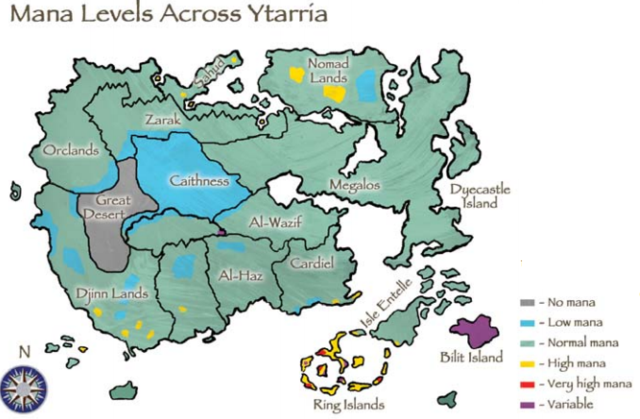
Magic
Spell-Based Magic
About one in a hundred humans on Ytarria have Magery at the 0 or 1 level. Comparatively, all elves are mages (though not all of them actively learn spells), shark men and medusas (which aren't covered until chapter 5) have lots of mages, reptile men and goblins have slightly more mages born than humans do, dwarves and gnomes have slightly less mages, halflings and centaurs have about the same mage rates as humans but typically choose not to use magic out of seeing it as flashy and obtrusive to a simple life, orcs rarely have mages, giants, hobgoblins, kobolds, and ogres almost never have mages, and minotaurs cannot actually birth mages at all. Of course, Magery is useless without mana, so it's probably a good thing that most of Ytarria has a normal mana rate. The main exceptions, as you can see in the above image, are the mana-void dead zone that is the Great Desert and the low-mana areas around it. Those spots of high or very high mana come from two sources: either asteroid impact sites such as the Ring Islands, or djinni-made towers in the Djinn Lands.
There are also certain exceptions concerning the use of spells. Spells that involve either moving yourself between dimensions or sending/summoning something from one dimension to another, as well as spells that manipulate time, are available but suffer a -25 penalty to their skill roll. This means that while you could technically get yourself off of Yrth, it's so very difficult that almost nobody finds it really worth it to waste the time, effort, and Fatigue Points to try even if they do learn of the spells. Necromancy spells are outlawed in most nations, Gate spells (teleportation and dimension manipulation spells) are exceedingly rarely known, and knowledge of technology spells from the Industrial Revolution onward are so little known that they might as well not be discussed at all. Even technology spells related to the Renaissance and pre-Industrial era are almost entirely hoarded by the Megalan Ministry of Serendipity, who use spells such as Seek Gunpowder and Seek Machine to hunt down and either kill or mindwipe technologists.
Mysticism
Advantages like Channeling, Healing with the Faith Healing limitation, Medium, Oracle, and Spirit Empathy are supernatural powers that are technically magical, but not the skill-based magic spells system GURPS typically adheres to, and fall into the category of mysticism. Mystics are common among the Sahudese and the Northmen, but their situation in the Christian and Muslim nations is somewhat complicated. Mystics who fall in line with the local orthodoxy are seen as one blessed by God for their faith, especially those who have the whole "faith as if of a child" simplism to them. Those who aren't in lockstep are watched exceedingly closely for anything that can be used to discredit them as either purveyors of heresy or wild-eyed lunatics.
Magic and Religion
Of the three religions, two mostly accept magic. The Ytarrian Catholic Church and Sunni Islam both see magic as acceptable as long as it is any of the "white arts" – pretty much any magic other than necromancy and things that muck about with non-undead spirits as well. Ytarrian Shi'ia, on the other hand, declares that any use of magic is a sin, though it may be pardoned by God if it is done in the direct service of Islam or there is no choice in the matter. Actual practice in the houses of God are slightly more complex. While the Catholics of Megalos actively demand that any of their clergy who are mages learn spells, in al-Wazif it is generally considered that magic is an allowed but ultimately secular affair, albeit one that mullahs can opt to participate in if they wish.
Magic and Science
Multiple paragraphs that can be summed up as "magic fucks with our perception of science, but the scientific method and rationalism on Yrth aren't really advanced enough to care".
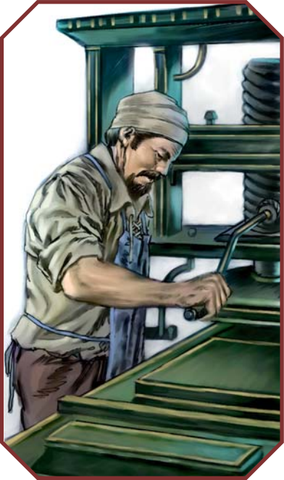
Technology
For the most part, Ytarria is Tech Level 3, which coincides with the human Middle Ages. There are some small cases of greater technological prowess where the Powers that Be feel it is not a threat to their authority, such as simplistic understanding of germ theory and inoculation, Renaissance astronomy and heliocentrism, and regulated but nonetheless present forms of non-combat TL4 clockwork machinery. The book also admits here that while there is a great overarching attempt to suppress technological advances, if there is another huge flareup of constant and large Banestorms like what happened in the 11th Century it is unlikely that even Megalos could stem the flood.
Suppression of Gunpowder
The Yrth gun control issue isn't a vast conspiracy so much as a bunch of smaller ones that form into a greater whole. Wizards like their privilege, nobles worry about revolution, the rulers of al-Wazif and al-Haz have heard reports of the post-Crusades world and believe that firearms are tied directly to the fall of the Islamic lands as a world power, and Sahudese see guns as inelegant and dishonorable. There are also at least some cases where dragons have helped in the suppression of gunpowder, though the reason is just as inexplicable as anything the dragons ever do. The genie has started to come out of the bottle in Caithness, however, where the raging civil war and low mana conditions have fractured the ability to control the spread of guns. Caithnessian wizards have collectively decided that if the sporadic use of handheld guns turns into the creation and use of cannons and mortars, they'll back whichever side of the civil war hasn't invented them yet regardless of personal opinions.
Transportation
Outside of fancy stone roads in and between large cities, most overland travel in Ytarria is a shitty slog through dirt and mud roads in wagons, on horse- or camelback, or on foot. Water travel fares a bit better, as the 17th Century ships of the Protestants were stripped of their guns and commandeered by the Megalan Navy rather than being destroyed outright. Nations outside of Megalos still mostly use earlier sloops, barges, and two- or three-masted brigs.
Medicine
Magic is the biggest healing industry in Ytarria, but not the only one. Alchemical mixtures, herbal remedies, and primitive pharmaceuticals are all found in both rural and magic-poor areas. An understanding of hand sanitation, the spread of disease through animals, and semi-successful vaccinations have made these methods more successful than they would be in a real Medieval world. There have also been attempts at blood transfusions, but the lack of blood type categorization has made the practice dangerous and unreliable.
Printing
The art of movable type printing is one of the greatest failures on the part of the Megalan Ministry of Serendipity. While guns have obvious dangers, it wasn't until printing presses were already widespread that the wizards and nobility of Megalos realized "oh shit, the peasants can use these to fast-track seditious materials!" By that point, it was too late and the nobles had to run damage control by supporting scriveners' guilds that gain royal support and funding in favor of only printing things that are friendly to the Megalan government.
Major Languages
Languages have somewhat evolved in the transfer from Earth to Yrth. Most of the Christian nations all speak Anglish, a mixture of Medieval English and Norman French. Some remote parts of Araterre instead speak Old Aralaise, which is 16th Century French. Northmen speak a similar language known as Northland, which combines traits of Medieval English, Norman French, and archaic German. In al-Haz, al-Wazif, and some of Cardiel, proper Arabic is spoken, preserved through careful reading of the Q'uran and other Arabic literature kept in their great libraries. Other languages worthy enough to be noted are Latin amongst Megalan clergy and scholars, Ladino (a mixture of spoken Spanish and written Hebrew used by Jews), Tredroy Patois (a mixture of Anglish and Arabic), and Sahudese (a garbled mess of numerous Asiatic and Native American languages that also happens to use Japanese for proper nouns). Non-human species speak either human languages, their own native languages named after themselves, or both. Kobolds and orcs have no written language whatsoever, and reptile men have one but only rarely use it.
Sexual Morality
Adultery and homosexuality are both crimes that are usually ignored if they are kept in the closet, but punished severely if they threaten social order and group cohesion. On the subject of women and their sexuality, Christian countries are typically pragmatic about it, Muslim ones are strict about modest dress but okay with a lot of the same things the Christians are otherwise, Sahudese are all about honor and formality, and the Northmen are all about honor and having big bloody feuds about fucking gone awry.
Next Time: The other half of chapter 2, because this is a fairly hefty chapter. Theatrics, lawmaking, secret societies, slavery, and more.
Chapter 2 Continued
Original SA post
Chapter 2 Continued
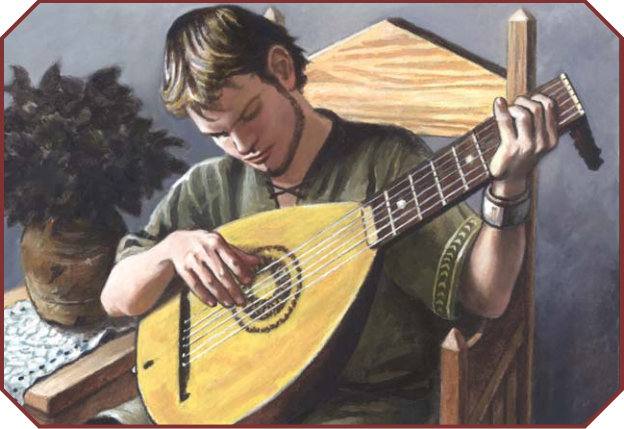
Arts and Entertainment
As with the printing press and medical advances, the 16th and early 17th Century entertainment ideals of the people of Araterre managed to gain a foothold on Yrth. This means that Shakespearean theatrical performances, polyphonic musical orchestras, and the artwork of the great Renaissance masters have supplemented the more Medieval forms of creative expression across Ytarria.
Theater
While Sahud has dramatic reenactments and the Islamic nations have great oratory amphitheaters, theatrical plays are almost entirely a thing of the Christian lands. Great theatrical halls can be found in many major cities, performing the works of the great playwrights and Christian morality plays to thunderous applause of large audiences. There are also theatrical troupes who take their shows on the road, playing anywhere from the grand halls of a local noble to the rugged center of a rural village. Musical theater – that is to say, opera – is also present, but the only actual opera halls that have been built are in the two cities of Tredroy and Megalos.
Musical Arts
Most classical instruments can be found on Yrth, though the piano was never invented and the church organ and harpsichord instead hold sway in the place of later keyed instruments. Orchestras tend to be limited to dance halls or the homes of the nobility, with the majority of music elsewhere being played by either small groups of troubadours or solo acts. It should also be noted that the strangest piece of text in GURPS Banestorm so far calls this section its home.
GURPS Banestorm posted:
Songs may also survive the transfer, although incomprehensible references in the words may lead to them being accidentally mangled or deliberately changed as they spread. No one realizes that one of the most popular Cardien ballads about the recent wars between al-Wazif and Megalos uses the tune from the Beatles’ “Yesterday,” while only a few professionals know that the weird and decadent songs recently so popular with the Megalan aristocracy are the work of Cole Porter, freely translated into Anglish.
Dance
Outside of harem dancers in al-Haz and al-Wazif and ballet in the thriving cultural center that is the city of Tredroy, most dancing that occurs in Ytarria is a social affair. No Megalan or Cardien dandy worth his knickers doesn't know the latest slow dance or jig that is popular when all the nobility get together.
Literature
Most writing in Ytarria is focused on the tangible and real, albeit often aggrandized. Epics are extremely popular, especially nationalist founder's tales such as the Simoniad for Megalos, Nine Knights of Redhall and Lay of Conall for Caithness, and The Voyage of Jean and Catherine for Araterre. The Nomad Lands, where the Celtic- and Norse-descended Northmen dwell, hold epics to an even greater standard and consider their eddas to be sacred texts. The writing of novels is present but not particularly common due to the fact that its writing style is not particularly popular in the Christian lands. Meanwhile, over in al-Haz and al-Wazif, you have poetry favored by the nobility, oral storytelling and written fairy tales popular amongst the common folk, and travelogues by dashing adventurers enjoyed by both sides of the social strata.
Visual Art
Art is another area where the lands vary in their practices. The Christian nations primarily utilize Italian Renaissance techniques, but their actual execution varies. In Cardiel and Caithness, the great artistic minds paint or sculpt Biblical scenes or local heroes in a vibrant and dramatic manner that often show even the flawed sides of grand figures, while the artists of Megalos create anatomically correct but ultimately lifeless vanity/propaganda pieces of Megalan royals and heroes both past and present, always with a placard or engraved statement that makes viewers sure they know who they are looking at and what they are meant to feel. Over in the two Muslim nations, the majority of visual art is abstract geometric decoration in a fashion based around the 'Arabesque' style of Earth. There has also been adoption of the Persian miniature style of painting, though there is some controversy in the Shi'ite community over whether or not such representational art might be questionably moral. Over in those other two countries that aren't part of the Crusader attention party, you have artwork being entirely used for religious and ceremonial purposes in the Nomad Lands and calligraphic landscape and figure drawing in Sahud.
Architecture
Architecture is still mostly the same on Yrth as it was on Medieval Earth for the cultures of Ytarria, save for 16th Century Gothic architecture gaining a huge surge in popularity across the Christian nations. While a fancy palace or cathedral is nice, however, a lot of nobles have their actual living quarters still based on Medieval fortresses with added protections against magical foes.
Elven Arts
Elves see art as a participatory event, meaning that they don't attempt to create long-lasting works or uphold certain figures as patrons of the arts. They share dances, stories, poems, and displays of magic that tricks the senses. The fact that elves see everything in their lives as aesthetics means that they are also technically always at least half-participating in performance art. Humans tend to find elf art weird, but eventually come around to its "pervasiveness and perfection" (the book's words, not mine).
Dwarven Arts
In stark contrast to the elves, dwarves favor extreme meticulousness and detail so that even the most hard-eyed viewer of the art will know that it was crafted to its utmost potential. The gems in a piece of jewelry can't just fit well, they must fit perfectly , and all of the various engravings and filligre around it need to have just as much care taken with them. Likewise, a dwarven saga will feature details about politics and local events that most human writers would find tangential to the overall plot and pointless to include. Gnomes, however, have abandoned the forms of their dwarven ancestors in favor of elven artistic opinions. Humans, elves, and gnomes alike agree that dwarven art is really, really boring.
Goblin Arts
Goblins were culturally overwhelmed by humanity, both through their willingness to go along with cross-pollination of ideas and the fact that they brought very little of the works of Gabrook with them during the Banestorm. Their main unique artistic measure now is the hraknoom, a practice of alliterative triplet limericks that are typically geared either to provide a paradoxical statement or some manner of twist at the end. It is a popular pastime for goblins to have freestyle hraknoom contests as a test of both improvisation and wit.
Social Arrangements
Have you heard about this thing called feudalism? Well, let me tell you all about it. Almost all of it, that is, as there are specific Social Status charts in chapter 5 too!

Peasantry
In the Christian lands, the lowest of the low are the serfs. You and your land are one and the same, and both are under the command of the local lord. Serfs can't move somewhere else, marry, or generally do any big change to their life without asking the lord for their permission. Villeins have slightly more autonomy, as they technically own their land but must pay for it in labor services to the lord. Some villeins known as cottars have full ownership of their land, but they still ultimately have to pledge loyalty to their lord and are likely to have any attempt to buy or sell land blocked. In al-Haz and al-Wazif, all peasants are effectively either villeins or cottars, with no equivalent to the serfs other than possibly slaves if you count serfdom as being like slavery (which the book adamantly states is untrue).
The Merchant Class
The Christian nations have a hard time figuring out what the hell to do about merchants, as they don't really fall into the traditional social stratigraphy of their society and can come in forms anywhere from poor roadside traders to wealthy trade fleet moguls. Merchants are typically free citizens that adhere to the rules of a local merchant guild, and the fact that many merchants are truly wealthy means that only some particularly stubborn nobles and clergy that see merchants as welfare parasites truly hate this social group. Hazis and Wazifis typically have little good or ill to say about merchants beyond noting that Mohammed himself was once a tradesman.
Knighthood
Knights – or ghazis and 'amirs in al-Haz and al-Wazif – are the brunt of class of warriors in society. While villeins and cottars are often conscripted into militias and warring forces, knights have actually good mounts, armor, and weaponry that is the benefit of being a land-owning member of society with a wealthy benefactor from the nobility. Caithness is notable as the only nation that allows women to become knights. Most knights of the Christian nations have Code of Honor (Chivalry), or at the very least a -1 point quirk representing their often failed attempts to follow that ideal. There is no such code among the ghazis and 'amirs, who only follow futuwwa, a generic concept of masculine honor.
The Nobility
The 1%. Nobles live on the backs of their estates, having to manage the basic needs and affairs of their peasantry, defenses, and various servants in order to get lavish living in return.
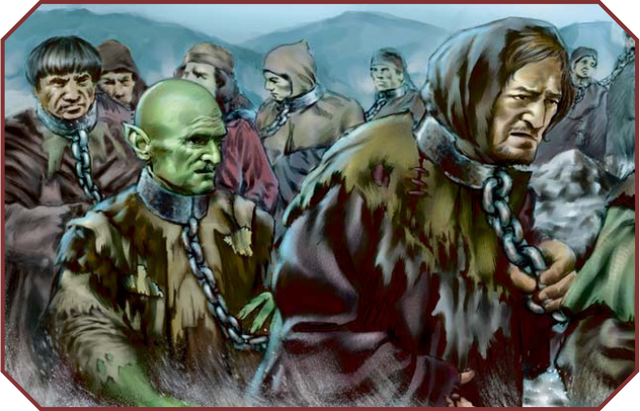
Slavery
Slaves are legal and widespread in Megalos and both of the Muslim nations, as well as legal but more scattered in Caithness, the Nomad Lands, and the dwarven lands such as Zarak. Orcs and ogres are also both big on the whole slavery thing, though they have no actual laws as such either way given that they are savage barbarians. Even in Cardiel, where social reform efforts abolished slavery, there are fringe cases of it still occurring in isolated locations. The only places where slavery is a true unknown are Sahud and the sanctuaries of the elves. Slavery in Ytarria is of the traditional variety, modeled on Imperial Rome in the Christian lands and on Arabic customs in al-Haz and al-Wazif, as chattel slavery was either never introduced to Yrth or never caught on if it did.
Economics
Ytarria has a greater monetary economy than actual Medieval society. While there is still bartering and living off the goods of your land and all that, all of the great nations have their own minted coins that are used in the more inhabited areas for the purchase of wares and services. Megalos, Araterre, and Caithness have the farthing (copper piece worth $1), penny ($4 silver piece), mark ($200 gold piece), and pound ($1,000 bar of silver), al-Haz and al-Wazif have the halala ($1 copper piece), dirham ($4 silver piece), dinar ($100 gold piece), and talent ($1,000 plus-size thickness gold piece), Cardiel uses money in both of the above forms, Zarak has the khenn ($1 copper piece), dann ($12 copper piece), ffo ($144 silver piece), and tohn ($5,184 gold piece) that are all extremely rare outside of dwarven lands, and Sahud has the lone $10 silver piece called the yen. The Northmen of the Nomad Lands are not mentioned at all, so who knows what they use.
Crime and Punishment
The law is Medieval, and thus pretty shit. Public flogging or mutilation are common punishments for things that aren't worth the death penalty (which is also publicly performed in the old hanging fashion), you only get incarcerated after your trial if you happen to be very politically expedient or someone thinks they can torture more useful things out of you, rape and similar assaults against women are seen in sexist "property value" terms in every nation except Caithness and Cardiel, etc.
Political Systems
Feudalism
My god, are we really talking about feudalism again? I thought we already covered that pretty thoroughly. Oh well. This part talks about fiefdoms, fealty, and the divine right of kings. Moving on.
Megalan Autocracy
While technically a feudalist nation, Megalos is considered to be an autocratic and authoritarian regime because the emperor is above the nobles rather than the "best among equals" as kings are amidst nobles in other feudal nations of Ytarria. More interesting than whether or not one type of feudalism is more noble than another is the fact that Simon Menelaus had a huge boner for Rome that has continued in the centuries since he founded the empire in the first place. This has lead to several unique developments in Megalos, such as the resurgence of gladiatorial games and the creation of the Imperial Legion of well-trained legionary soldiers and battle mages that has all but ousted the traditional knights. The autocracy is weakest in Araterre, where the Aralaise puppet nobles are second to powerful merchants and clergy.
Muslim Government
In al-Haz and al-Wazif, feudalism is technically in play, but begins to weaken at the top of the structure. The current sultan or caliph is who oaths of fealty are sworn to, not the actual position of leadership, While there are some officials and families that give their loyalty to each new ruler like clockwork, there are enough fringe cases that some long-reaching political tensions can arise when the head honcho dies and there are influential groups that disagree with the next to the throne.
Tribalism
In certain parts of Ytarria, such as the Nomad Lands, there is no greater government, and the largest social order is the tribe. These tribes are lead by chiefs (known with local names such as jarls or headmen depending on the region) that are selected either by blood, by a council of elders or shamans, or elected in a primitive form of democracy. Chiefs are responsible for their entire tribe's well-being, but also typically have a lot of power and respect to match the size of their responsibility.
Sahud
The bastard child of Medieval Chinese Confucian bureaucracy and Japanese feudal lords, lead by an emperor known as the Heavenking. Most other nations see the Sahudese government as weird and confusing, but that's not really surprising, as that's what most other nations say about anything involving Sahud.
Towns
Towns and cities technically don't follow the system of feudalism. Townsmen are mostly free in the sense that modern citizens would be rather than under the rules of the serfdom or villeinship, but are nonetheless below the nobility and can be physically harmed if they don't know their place. The leadership in towns is made up of an elected council of wealthy townsmen that in turn serve a mayor or a governor. Governors are appointed by the local lord and can replace council members as they wish, while mayors are elected by the town council and are thus subject to their whims and desires.
Guilds
One of the most important parts of towns and cities – other than their leaders, of course – are their guilds. The guild is effectively the union of Ytarria, creating an organized force of laborers in a specific practice that monopolize that practice and ensure fair wages, item prices that are lucrative but not exploitative, and product quality. Being a member of a guild also provides insurance for its members: the guild cares for its members' families if a member dies and pays for the rebuilding of destroyed store property or the cost of healers if members are ill or injured. The two main types of guild are merchant guilds, which are all about buying and selling, and craft guilds, which provide specific goods or services. The extent of a craft guild actually varies depending on the size of a community. For instance, while a small town may have a Clothman's Guild, a big city near the heart of Megalos will have its same practices split into the Spinner's, Weaver's, Tailor's, Dyer's, and Embroiderer's Guilds. Guilds hold a lot of political clout in Megalos and Cardiel, very little in al-Haz and Caithness, and a middling amount everywhere in between.
Guilds Unique to Yrth
Five types of guild are found on Yrth that originated in the nations of Ytarria rather than extended concepts from Earth. Two of these are new due to the whole fantasy element, for instance. Alchemist's guilds regulate the practice of experimental or unskilled alchemy to ensure public safety as much as they do their actual product, while mage's guilds focus on hiring out magical services such as enchanting magic items or using spells for various crafts. Armsmen's guilds, by contrast, take the very Earthly practice of hired toughs and make it a respectable profession. Armsmen include mercenaries, bounty hunters, unaffiliated battle mages, and other people who want to get paid to fight but don't want to fall under anyone's banner. Finally, you have thieves' guilds and assassins' guilds, the two forms of underground guild. Thieves' guilds form monopolies on extortion, racketeering, prostitution, smuggling, kidnapping, and any other number of nefarious activities, while assassins' guilds do what their name implies and kill specific people discreetly for a fee.
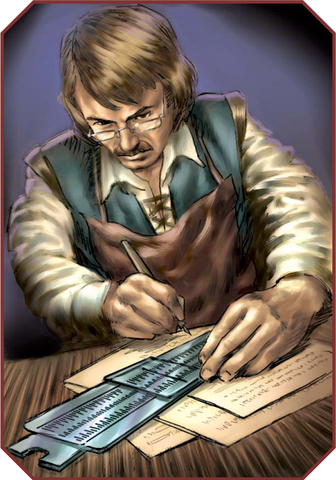
Conspiracies and Secret Societies
Wizardly Conspiracies
Mages tend to follow one of two courses in life: either they act like normal people, or they fall into a destructive cycle of megalomania and belief in caster supremacy, creating in-groups, those in-groups inevitably falling into infighting over who is the most supreme supremacist, and then dissolution of the group as its former members join and use non-magical groups as proxies for their petty squabbles. While the megalomaniacs are only about 20% or so of people with Magery, it and the legitimization of mages in power by most nations means that they aren't all that inclined to having conspiracies.
The big place where they actually work together for a greater conspiracy is in the suppression of gunpowder. As stated before, mages quickly realized that firearms could allow mere peasantry to have destructive power without any need for supernatural powers, and this scared them enough that they began to correspond with each other rapidly and plot to convince the nobility that guns were a threat to their national stability as well. In the rather lax Caithness, mages have taken to being glorified thugs that rough up secret technologists in dark alleys, since the Caithnessers in power don't seem to want to go along with their anti-gunpowder racket like most nations' lawmakers have.
Cults
Pagan Cults: Paganism (defined here as any non-Abrahamic European religion, so Sahudese religions aren't counted) has found a strong foothold as the major religion of the Nomad Lands, but in the Christian and Muslim nations it is persecuted and driven underground. These minor sects aren't actually all that conspiratous, as they mainly just want to be left alone and practice their religion in secret.
Mystery Cults: Mystery cults are very regional societies that revolve around preserving a specific ideal in secret. Unlike pagan cults, mystery cults are more motivated and often have extreme vows and psychological conditioning to keep their members loyal. Mystery cults can support pagan religions, political concepts such as communism or democracy with a veneer of mysticism on top, illegal activities and actions (again with a veneer of mysticism on top), or even a desire to preserve specific spells that they don't want anyone else to have.
Diabolic Cults: Demon-worshipers. Some diabolists are persecuted pagans who were pushed into desperation, others are anarchists willing to risk eternal damnation (assuming there is a Hell that demons come from) to break the system, still others are atheists that use demons to strike against religion with the thing they fear most, and a few of them are even genuinely evil and wish to consort with things just as diabolical as they are.
Bardic Colleges
The College of Bards is a fraternal society that takes a mixture of Medieval minstrelry and Catholic traditions, Celtic beliefs, and Sufi Islamic mysticism and mashes it together into a form of mysticism based primarily around music as an expression of magic and faith. The College doesn't actually care about the religious affiliation of its members, which haas lead to some clergy viewing the organization as a potential source of sinful dissidence, not that the College particularly cares. Unlike proper troubadours, College bards are not particularly well-respected in any Christian nation other than Caithness, which has lead to more than a few bards being cocky around a noble and then getting the axe for it (sometimes literally). Bards are usually seen as suspicious at best in al-Haz and al-Wazif, save for some Sufis that see them as kindred spirits, while in the Nomad Lands they are seen as foppish but ultimately respectable people only slightly inferior to Northman skalds.
The Underground Engineers
An informal secret society of those who wish to see technology progress in Ytarria, especially if it's banned technology. The fact that underground engineers have no centralized leadership means that they haven't exactly conquered any lands, but it also means that they are hard to squash completely – like a hydra, you cut off one head, two more sprout in its place. Most underground engineers have recreated TL4 technology such as blunderbusses and early muskets, some have even managed to replicate TL5 technology such as electrical and steam engines. Some underground engineers also take up the cause of preserving and spreading social concepts such as Protestantism and democracy rather than just physical devices.
Protestantism
Oh hey, speaking of the Protestants, they're also here. While they may have been crushed and forced underground in the imperial lands of Megalos, it has managed to actually survive above ground in several key places. One is Cardiel, where they are tolerated but treated as second class citizens. In the city of Tredroy (which is technically Cardien land, but also technically part of al-Haz and al-Wazif...it's complicated), ever infamous for its rebellious streak and seemingly endless glee at pissing off Megalos, there is even a Protestant school system and official administrator known as the Secretary of the Protestant Congregation. Finally, in al-Wazif, Protestants are viewed as any other People of the Book and have open worship in the large cities. Al-Haz is theoretically accepting in Protestants but suppresses them just as much as any other non-Muslim in practice.
Spy Rings
While there are some large groups of spies in service of nations or bouncing around as freelancers, most espionage on Yrth is made up of small cells that are gathered together for a specific purpose and then break apart when that purpose is done. The lack of any more advanced methods of communication means that most spies look and listen for any interesting news and send their information to a central spymaster, as opposed to hunting down a specific secret and risking discovery before the information can be delivered.
Next Time in GURPS Banestorm: Have you heard the twenty-eight pages of good news? All about Christianity, Islam, Judaism, and those other religions that aren't as important.
Chapter 3: Religion
Original SA post
Chapter 3: Religion
Since we are discussing the topic of actual, real world religions (for the most part), I'm going to attempt to restrict myself primarily to discussing the stuff of religion that is unique to Ytarria. I am not a theologian, nor do I play one on TV.
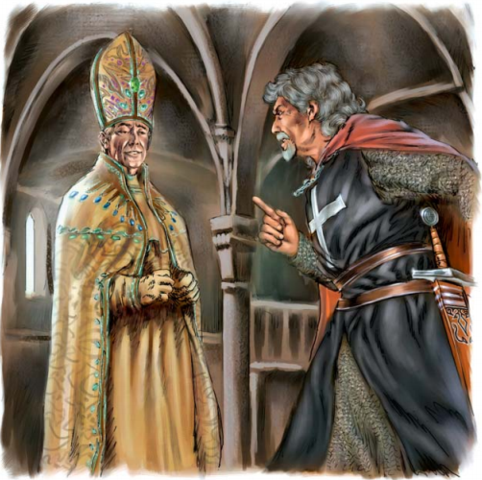
Christianity
Ytarrian Christianity is almost entirely connected directly to Catholicism, so you have sacraments, communion, excommunication, bishops and archbishops, and all that jazz. Megalan canon declares that most races such as goblins and reptile men have souls and are thus subject to the original sin and salvation. Demons, spirits (which are considered demons by the Church even though they aren't), medusas, trolls, and vampires are beings explicitly claimed to not have souls. Lycanthropes are the most complicated subject, as it is believed that they have a soul but can have it disappear and become soulless if they act too much like animals compared to people.
Heresy
Out of what is mostly cynical pragmatism, the Church deemed magic to be a tool based around some strange manner of natural mechanics that is not innately good or evil, any sin coming from usage such as necromancy or the use of spells for murder. This wasn't how it started, however. The great conflicts between various splintered Christian groups after the Banestorm lead to many sects developing in both directions. The Penitentines were a sect that believed Yrth was Purgatory, all non-humans were demons, and that magic was Devilry rather than strange science, and while not all were on board for the Purgatory part, there were more than a few groups that believed the Devilry part. On the other end, there were also the cult of the Manites and their belief that mages were actually chosen miracle-makers of God and thus holier than the non-magic members of society. It was only the rise of Megalos to power and its ruthless purges and declarations of heresy that eventually forged the current dominant view of magic by the Church, since the Church is in and of itself Megalan-controlled. Protestantism is another heresy, of course, as are any syncretic religions or attempts to combine pagan rites with Christian practice.
The Curia
What is the Catholic Church without the Pope? That was a question that faced Megalos as it reunified the Church, and its answer was the Curia. The Curia is a council made up of the Grand Master of the Hospitaller Order, Grand Master of the Olybrian Order, Grand Master of the Templar Order, Grand Master of the Thomasite Order, an archbishop from Caithness, three archbishops from Cardiel, and five archbisohops from Megalos. As the Church's ruling body, the Curia is the group that decides who gets to be a bishop, what changes in doctrine happen, and advise rulers on how to keep to the Christly path. They also happen to have the most owned land in Ytarria, so that's not exactly a downside to the job. The Emperor of Megalos once also held sway over the Curia, but that had to end after the declaration of independence from Cardiel and Caithness, since even the Empire realized that it was probably better to allow Cardiel and Caithness their bishop and archbishop autonomy than to have the Church undergo a double schism.
Holy Orders
The Hospitallers: While they may have been an instrmental force in spreading Megalan Christianity through force early on, a lot of people consider the Hospitallers to be colossal assholes. That's fair, to be honest, given that they are in fact colossal assholes. Hospitallers consider non-humans in general to be unclean and refuse to allow them into their ranks in spite of official Church doctrine, claim that the Christianity-eschewing dwarves and elves are Satanically influenced, and get really excited whenever it's time to do some heresy purging and are usually the first to get out their swords and torture devices. Caithness and Cardiel in particular absolutely hate those bearing the sign of the white cross on a black flag, and the Templars have used this to gain influence in Cardien society.
The Olybrians: The Olybrian Order is named after Saint Michael Olybrius of Serrun. Goblin peasantry fell into line with Christianity in the 1190s after the preaching of Olybrius, and erected this order after goblin chieftains following the old religion of Gabrook put Olybrius to death. Olybrians are best known for their rather disparate mixture of deep introspection and fierce warriors. Their monks pour over the scripture and debate the nature of God and what constitutes revelation and heresy alike, but also train tirelessly in the art of swords and staves. Olybrians arguably hate Muslims even more than Hospitallers, which is no small feat, and are the primary voices in the call for a Fifth Ytarrian Crusade. Grand Master Jobert of Evrow feels that the only reason there hasn't been another Crusade already is that the people of Megalos are lukewarm spirits content in resting on their laurels. As opposed to, you know, the fact that the Fourth Ytarrian Crusade was a horrible failure.
The Templars: The Knights Templar in Ytarria are entirely descended from sixty Templars that came through the Banestorm on Halloween of 1310 and proclaimed their presence as noble warriors of God seeking sanctuary from prosecution. This was particularly strange, as the Banestorm was nearly entirely dormant during that century. Even stranger was the fact that nearly all of the Templars became extremely adept wizards and quickly welcomed non-humans into their ranks without fuss in spite of being newcomers to Ytarria. Unsurprisingly, some have claimed that the Templars know more than they let on, and possibly even knew of magic on Earth and found ways to open the Banestorm at will. Regardless of whether or not those rumors are true, what is definite fact is that the Templars are loyal and talented warriors. Their fortresses guard key trade routes, and their military academy in the city of Azer trains some of the best knights and battle mages for all of the Church's Orders and the Megalan Legion.
The Franciscans and Friedrichites: The followers of St. Francis are pretty content to be God-focused hermits in monasteries located in the wilderness. Many are illiterate, all follow a vow of poverty, and they don't really get involved in Church or secular politics. There is also a splinter group of friars known as the Order of Friedrich that follow the teachings of their namesake, a Franciscan monk in the 1800s who split off from the main order to follow his own path. Friedrichites proclaim that not only is the world sinful, but the very fabric of material existence is evil, and that all good Christians should seek to have as little impact on the physical world as possible before shuffling off the mortal coil. Not only do they keep the vow of poverty of their parent order, they also vow complete pacifism and a solitary existence. They are so dedicated to to this cause that some Friedrichites manifest mystic powers such as the ability to eschew food, drink, or sleep, very strong magic resistance, and even the power to become incorporeal. For reasons unknown, the Friedrichites keep some contact with the Templars, which has kept the Curia from declaring their order a heresy.
The Thomasites: The Order of Saint Thomas was founded by Benedictine abbot Gareth Aristophiles in the late 1300s. Aristophiles was obsessed with the works of the great philosophers such as Pythagoras and Aristotle, and more specifically the idea of science as the key to finding the truth of the universe and empirical proof of God's existence. Thomasites take strong positions on ethics in magic and natural philosophy, and most of their research has ended up landing in the field of healing spells, which they put to use in their hospitals in the cities of Megalos, Teridar, Calder, and Craine. Thomasites are one of the few Orders that accept women into their ranks, and are also welcoming of all species seen as possessing souls by the Church.
The Jesuits: After the first came to Ytarria in the 1570s as part of the whole Araterre business, the Church engaged in a brief persecution campaign, finding the closeness the Jesuits had to the Protestants uncomfortable. A combination of fervent missionary work and oaths of loyalty to the Church Curia, however, ended up leading to the Jesuits being accepted as a strange but nonetheless proper Catholic order. Jesuit monks share some similarities to the Franciscans, especially in their vows, but are very much extroverted rather than introverted and believe in bringing God to the peasantry and far-off lands. Their works are in architectural practice, teaching, medical aid, and diplomacy as much as it is in actual preaching. They also happen to be big on political wheeling and dealing, often being seen as aides of Megalan nobility, which has lead to some other Orders bearing suspicion that the Jesuit Order is plotting some grand unknown conspiracy.
The Michaelites: The Order of the Archangel Michael was created in 1412 to specifically be the go-to guys for Inquisition fun times. After two centuries of lots of torture, purging, and all that good stuff, heresies had pretty much either fallen to the sword or been driven underground, and the Michaelites had to find new jobs. The end result was the Michaelite Order becoming a paranormal investigative service, dealing with political intrigue and crimes performed through magic. While Michaelites in Megalos still sometimes go through the whole Inquisition song and dance if it comes up and are made up of fanatical zealous men, the technically separate Michaelites of Cardiel and Caithness are more or less Medieval magic FBI agents and are even willing to accept non-Church members (including Muslims in Cardiel's case).
The Constantinians: Named after a Megalan archivist named Constantine who lived in the 16th Century, the Constantinians are a small order that play a key role in both political and Church administrative functions. That's all that is stated about them, so I'm not surprised that they aren't represented in the Curia.
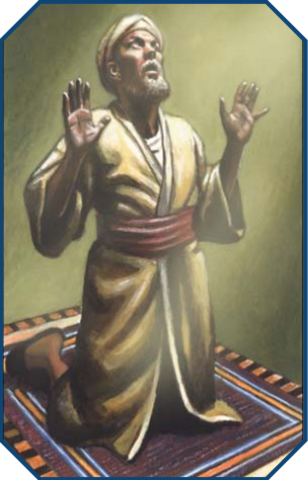
Islam
The Muslim castaways of the Banestorm religiously adapted to their new world far quicker than their Christian fellows. Magic powers and nonhuman species could be directly compared to the djinn, and like the djinn, it became clear that members of these species were varied sorts who had free will and could come to be People of the Book if they so chose. Those that crossed over originally were hugely of Bedouin, Berber, and Tuareg descent and had no intention of replicating any of the great empires of the Islamic peoples of Earth, but two events would lead to a shift in this paradigm. The first was the discovery of an immense onyx stone carved with holy scripture from bottom to top by tribesmen traveling through the great mountains known as the Fence of God, guarded by a wizened old man who told the tribesmen that he had been waiting to show the Muslims of Ytarria their holy city for over half a century. When the tribesmen returned with all the most learned mullahs of the land months later, the elder was dead but perfectly preserved. The combination of "non-decaying corpse" and "convenient second Kaaba out in the boonies" was seen as an obvious sign from God, and the holy city of Geb'al-Din was built around the great stone. This created a central point of focus for the religion, and helped bolster the growth of the nations of al-Haz and al-Wazif in the face of Crusaders from Megalos.
Most of Islam on Ytarria is pretty familiar stuff. You have the five pillars (with Geb'al-Din replacing Mecca for pilgrimage), sharia law, facing Geb'al-Din in prayer, etc. Without the clear-set prohibition against mystical powers that the Christians had, Muslim views on magic have mostly been shaped by Shi'ia vs. Sunni beliefs. The Shia-practicing believers of al-Haz see wizards as prideful and prone to falling into the evils of idolatry and malicious use of their powers, and are thus distrusted and likely to stray from the path to God. In Sunni al-Wazif, however, magic is seen as a tool that can be used for good or ill like any other, but one that should be tempered. This tempering is done by a two year service to the Caliph upon completing wizardly studies – service in the army for men and in administrative staff for women – that is meant to ensure that the wizard has the moral backbone to properly use their talents. Sufis are pretty devil-may-care on the whole topic and are fine with magic use in their already rather mysticism-focused traditions.
The Ghazi Orders
The greatest difference between the Islam of Earth and Yrth is the presence of the Ghazi orders, holy warriors that have taken to having an active knight-like social structure. They are very well-respected in both of the Muslim lands, and even respected more than the average Muslim in the Christian nations.
The Order of the Crescent Moon: A Hazi Ghazi order that is known for its extremely skilled warriors. They don't swear fealty to the Sultan of al-Haz, instead directly serving the Ulama (Islamic scholars).
The Order of the Pegasus: The personal bodyguards of the Caliph of al-Wazif. Sadly, they don't actually ride pegasi.
The Warriors of the Quill: Ghazis that take the whole "pen is mightier than the sword" adage to heart, as their combat skills take second place to their knowlege of the Q'uran. They travel across all the lands of Ytarria to judge the moral rightness of believers and preach the word to non-believers.
Fanatics and Heretics
Kharijites: The "scream about infidels and bathe in the blood of their enemies" crazy people sect. They mostly hang out on the northern border of al-Wazif, raiding Hospitaller and Templar fortresses and Christian towns. The Caliph of al-Wazif tolerates them for now, but he also won't raise a hand to save them from the noose if they are captured by the knights to the north. Al-Haz doesn't trust them at all, as the original Kharijites of Earth were the murderers of Mohammed's cousin 'Ali.
Hashishin: As mysterious as they are deadly, the Hashishin lived on in Ytarria even after their mountain fortresses were razed and their order crushed on Earth. Scattered Banestorm castaways were gathered back together and bean to build new fortresses in the arid mountains of al-Haz, the greatest of these being named Al-Amut ("Eagle's Nest") after the Turkish fortress of the same name that acted as their base on Earth. Their rare and calculated politically-motivated killings spread fear in both the Muslim and Christian lands of Ytarria, even if most citizens don't even know the identity of this sinister organization.
Balikites: The "scream about mages as infidels and bathe in the blood of their enemies" crazy people sect. They are lead by Balik Abdallah al-Firuz, a Shi'ite mullah from northern al-Haz who is extremely against magic. While the Sultan hates the Balikites with a passion for their murder of one of his most trusted advisors and has put a hefty bounty on Balik's head, most Hazi mullahs are very apathetic towards the sect in spite of their murderous brutality. In al-Wazif, where magic is far more accepted, Balikites are treated as criminals and are sentenced to death by public torture if they are captured.
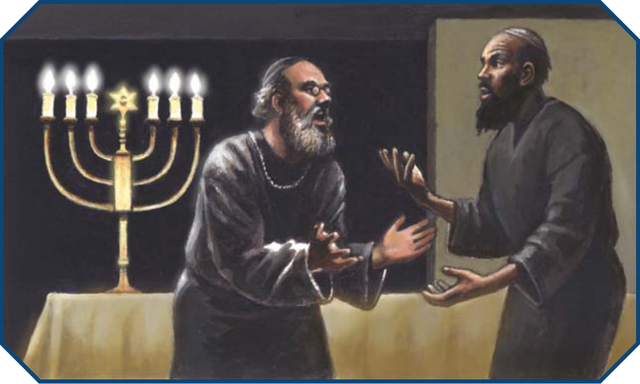
Judaism
While they might not have a nation of their own or the same great numbers that the other Abrahamic religions have, the Jewish people are a sizable minority that has had far greater success in the lands of Ytarria than they had on Medieval Earth, even spreading as far as having several small communities in far-off Sahud. Jews are in a unique position in the empire of Megalos wherein they are barred from owning land but also not beholden to the serfdom, effectively becoming landless freemen that typically take jobs as advisers, craftsmen, doctors, merchants, and scholars. They are considered useful citizens in both the Christian and Muslim lands, though there are still pockets of antisemitism here and there. Ytarrian Jews are fairly orthodox, keeping heavily to the law and very rarely accepting converts to Judaism that are not already of Jewish birth.
Their rabbis have had many a discussion on matters of the state of kosher concerning various Ytarrian beasts, the nature of the planet Yrth concerning prophecies, and of course a great deal about magic. Rabbinical law on magic is very rules-lawery on what is and isn't acceptable. While they share the ban on necromancy, communing with spirits, and demonic contact that Islam and Christianity also have, Jewish magical prohibitions also look down on divination spells as meddling in the inscrutable will of God and consider all forms of magic involving sacrifices as idolatrous. On matters of the future, many rabbis believe that the Messiah will bring the Jewish people from Yrth back to Earth when he comes, and until then they should be settled in their new home. A small sect known as the Diasporists believe that there's still one last trek to make, especially with seemingly unbelievable tales about a new Israel that have been filtering in as of late, and seek to find Gate spells to return to Earth on their own accord.
Other Religions
The Old Religion: Followers of the Old Religion claim that it came from the lands of the Germanic tribes and the Celts before Christianity, the Hellenistic believers, and even the polytheistic pantheons of the later Irish peoples. Their deities are a married couple – the Goddess, the lady of summer and birth, and the Horned God, the lord of winter and death. Neither figure is entirely good or evil, with the Goddess sometimes expressing new life and growth through violent expansionism and the Horned God sheltering the soul in the peace of death and the promise of rebirth it brings. Old Religionists believe in nature spirits, magic as an extension of the Goddess's dominition over the wild realms, and a constant cycle of reincarnation without an afterlife for good or ill.
Greco-Roman Cults: Believers in the gods of Olympus are few and far between, and typically very much undergrund as both Christianity and Islam seek to stamp them out once again. It's unknown just how these cults even managed to crop up in the first place – some have speculated that Simon Menelaus resurrected the old gods as part of his whole Rome fetish and then discarded them when he realized sticking with Christianity would probably make his dreams of empire more palatable, but nobody can say for sure. Most Greco-Roman cults accept that a worshiper of Zeus and a worshiper of Jupiter or one of Hephaestus and one of Vulcan are ultimately talking about the same gods, as trying to part the Greek and Roman pantheons at this point would be dangerously splintering and an already tiny group.
Norse Cults: True believers in the entire Norse pantheon are surprisingly few and far between, most of them being content to stick to themselves and grumble about those new-fangled Old Religionists appropriating their gods while waiting for Ragnarok to come about. And appropriate the Old Religion has! The Horned God is sometimes specifically named as Odin, and in some particularly sexist clanships of the Nomad Lands he almost entirely eclipses the Goddess in Old Religionist worship. Thor is sometimes also included as the warrior son of the Goddess and the Horned God, and Loki as a diametrically opposed force that is blamed for when the powers of the Old Religion's godly husband and wife team seem to fail to prevent calamity.
Magic Cults: Rather eccentric types that believe magic is in and of itself divine. Magic cults see magic as a sacred gift to be reverently touched and embraced, with non-believing wizards painted as haughty and destructive figures that enslave the gods for their own benefit. More than a few charlatans start magic cults as part of long cons.
Bilit Islander Religion: Most people avoid the mysterious and mosnter-laden jungles of Bilit Island, but those who have seen it firsthand have told of its murderous priest-kings and their equally bloodthirsty gods. This pantheon is primarily made up of Mayan and Aztec gods with a few southeast Asian deities added in, all endlessly hungering for tribute from their fearful worshipers. These sacrifices are typically animals or treasures, but human sacrifice is practiced when it's convenient. Some Megalan missionaries claim that Bilit Islanders are also ritual cannibals, though this may be adding a dash of hyperbole on top of an already crazy situation.
Hinduism: Few and far between, a few Indian and Balinese Hindu clans exist in Araterre and other random islands. The majority of them worship Lakshmi, Shakti, Shiva, or Vishnu as their primary deity, with a scant few adherents of Kali practicing in secret due to both the Abrahamic believers and even some other Hindus seeing them as creepy worshipers of a thing more demon than deity. Most tenets of Hinduism still exist, especially key ones such as the samsara cycle of reincarnation, but the caste system has all but disappeared due to the lack of societal numbers to keep it relevant.
Buddhism: Buddhism is the whipping boy of Ytarria. It's actively persecuted in most parts of the Christian and Muslim lands, seen as a weird fad that is interesting to a few elites in Cardiel, and barely tolerated in Sahud. For this reason, Buddhists tend to stick to elven and dwarven lands, where they can build their monasteries deep in the wilderness without fear of religious reprisal.
Sahudese Religion: Like most things about Sahud, their religion is a clusterfuck. You've got the yin and yang and a lot of the general philosophy of Taoism, the moral code of Confucianism, the worship of kami from Shintoism, and beliefs from Mongolian Tengriism, Siberian folk beliefs, and various Native American religions that go unstated because they are, and I quote, "simply too bewilderingly diverse to go into here". The spiritual leader of Sahudese religion is the same as the physical leader, that being the Heavenking, emperor of the land and purported divinity tied to mortal flesh.
Nonhuman Religions
The Eternal: The native races of Ytarria all follow a deity known as the Eternal. The Eternal is a great gestalt consciousness that pervades every piece of the universe's fabric, from the greater star to the smallest mote of dust. Everything is slowly on a journey to become one with the Eternal, and in worshiping the Eternal you seek to fast track your way to that oneness. It is believed that by meditating and studying the inanimate on its way towards the Eternal, one can achieve that enlightenment. The elves worship the Eternal through animals and plants and see waste of life (murder, laziness, vast deforestation, etc.) as the greatest immortality against it, sea elves worship it through water and believe that their suffering during the Banestorm was retribution for not understanding the ocean well enough, dwarves worship stone and metal as their chosen part of the Eternal and see perfecting something so that it will endure the test of time to be the closest link to the divine, and gnomes see the Eternal in the propagation of new and healthy life. Orcs believe in the Eternal, but don't understand the idea of worshiping it to become one with it – after all, what in life is greater than victory, and how can you have victory if everyone is equal? – so their big religious idea is to go all JRPG and fight the god-universe. None of the Ytarrian races are likely to follow human religions, but when they do the elves typically go for Hinduism or Sahudese religion, dwarves gravitate toward Islam, and orcs go for either a pagan or Abrahamic religion.
Faiths of Gabrook: In the sandy deserts of Gabrook, two gods held sway over the minds of the people. To the goblins, it was a battle between the god of civilization Uunkuy protecting the people from the god of barbarians Bozdaag, while to the lizard men and hobgoblins it was the god of strength Bozdaag defending against the god of decadence and lethargy Uunkuy. Similarly, the role of the two gods in Gabrook's creation are altered in the tellings of the two species, with the goblins proclaiming that Bozdaag ripped a chunk of matter out of the primal chaos that Uunkuy proceeded to forge into something actually useful and the lizard men and hobgoblins stating that Bozdaag created a useful world from the Chaos and Uunkuy merely added useless decorations and polish to the end result.
Half of this equation doesn't even matter on Ytarria, of course, as extremely few goblins worship Uunkuy after the Christianization of their lands. Indeed, Uunkuy's very Christian-like worship and priestly caste system oddly similar to Catholicism were what helped create such an easy transition to the new religion. All that had to be done was replace Uunkuy with God and Bozdaag with Satan, and voila. Lizard men, on the other hand, mostly still worship Bozdaag. His worship focuses on self-sufficiency and personal strength. Over-reliance on others, especially in the form of civilization beyond the tribal level, is seen as a great weakness and affront to Bozdaag's gifts of might. While lizard men see the Christian interpretation of God as the same decadent wastefulness of Uunkuy, they partition Islam's God into his own category of a happy medium between between decadent civilization and "barbarism" due to the strenuous strength of pilgrimages and the lives of nomadic herdsmen outside of the great cities of al-Haz and al-Wazif, and some lizard men become devout Muslims as a result.
Faiths of Loren'dil: The gods of the forest realm were part of a complex and flawed pantheon of deities with often opposing views, with war in the heavens being a frequent event in their religious lore. The halflings worshiped Halaina, goddess of home and hearth, and Heclan, god of trickery and stealth, but have almost entirely converted to human religions of where they now live on Yrth. The giants had the god of strength Chane, earth goddess Therneen, and sea god Otrik, but in the travel to the lands of Ytarria they have mostly become atheists with the exception of a few followers of their old gods and a handful of worshipers of human religions. The centaurs are the only people of Loren'dil that have fully kept their faith in the old pantheon, especially in Atallie, goddess of learning and wisdom. Some have nonetheless become followers of pagan religions or the Eternal, however, and the majority that still do worship the gods of Loren'dil typically keep quiet about it when talking to humans.
Others: Dragons are the only of the Elder Races of Yrth that don't believe in worship of the Eternal, instead believing that every dragon itself becomes a god after shoring up enough knowledge and power to ascend to a higher plane of existence. The ancestors that have already become gods are worshiped but rarely called upon, as it is believed dragons that ascend to godhood with as little help as possible get a better reputation in the land of the god-dragons. There are also the two species of Olokun, neither of which seem to give much information about their old gods. The merfolk seem to have hated the gods of Olokun and are mostly atheists with a few Eternal worshipers mixed in, while the shark men worship their deities the same as always, hoping to be able to one day draw them over to Yrth. The book describes this as a bad thing, so I can only assume that the whole insinuation about their gods actually being Cthulhu-likes is meant to be true.
Next Time in GURPS Banestorm: We begin the tour of the lands of Ytarria with the empire of Megalos. Soldiers, slaves, gladiators, and goblins await!
Chapter 4: the Lands of Yrth, Part 1 – Megalos
Original SA post
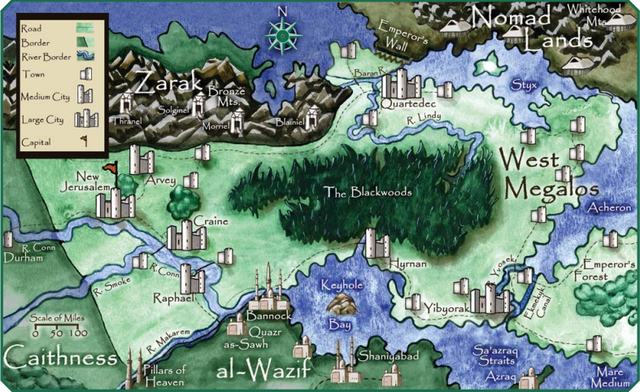
Chapter 4: the Lands of Yrth, Part 1 – Megalos
After being built up since the introduction, we finally get to dive headfirst into learning about the Megalan Empire. The banners of Megalos bear a great dragon upon them, which is meant to signify their power and status but is just as easily turned around to poke fun at their greed and sloth.
Geography
The climate and habitats of most of Megalos line up with that of western Europe. Wow, isn't that just convenient? There are a fair amount of rivers criss-crossing its length, as well as the huge Lake Styx and Lake Acheron, the two of which are the main barriers between Megalos and the Northlands. The fertile east and south and the dry but liveable west are all heavily populated, but central and northern Megalos are frontier wilderness that the empire technically owns but doesn't control in the slightest.
History
A lot of the history of the Megalan Empire was covered in the introductory chapter, but we get a refresher anyway. Simon Menelaus founded the city of Megalos and the Empire in 1200 AD with the explicit goal of world domination, easily gobbling up a lot of the Banestorm immigrants stuck in distress and disarray. The only two obstacles that seemed to be of any concern were the goblins, who were absorbed througha religious takeover, and the Knights Hospitallers in their citadel of New Jerusalem. Warlord Octavius Magnus convinced the Hospitallers that the savage Mohammedans to the south were a greater threat than the Megalan Empire could ever be, and a union of the two forced followed by the First Ytarrian Crusade began as a result. The Muslim tribes, in turn, threw down their plowshares and took up the sword, unifying their tribes into the three nations of al-Haz, al-Wazif, and al-Kard.
As the Crusades waged on, al-Kard fell to the invaders and the other two Muslim nations were pushed back into holding their existing territory rather than gaining ground. Things seemed to be all sunshine and roses for Megalos for over a century. Then came the war against Thulin's Folk, the dwarves of Zarak. Not only did the dwarves prove more than capable of defending themselves, but the nobles of Megalos were too embroiled in a fight over who would get the dwarven territories and treasure once the war was over to notice that their greed was alienating the Knights Hospitaller. Realizing that this was a war for money rather than a holy war, the Hospitallers declared that they were taking their ball and going home, at which point the dwarves utterly smashed in the last remaining invaders. To make things even worse, the Northmen had been keeping an eye on all the events playing out in Megalos, and decided that it would be a great time to make raids in its northern reaches. The massive
In the time since then, Megalos gained the island territory of Araterre, gained and then proceeded to lose the western land of Caithness, and lost Cardiel. Two more Crusades were attempted, both of which failed, and centuries of political infighting have no real end in sight. Emperor Diophrates XII is engaging in Caligula levels of indulgence and savagery, to the point that the Church is getting ready to excommunicate him, but he seems to have no care for their wishes or matters of rule. This has allowed various nobles to engage in tyrannical local rules or begin plotting the Emperor's downfall and their own rise to power, while the Empire goes to shit around them without anyone in power who seems to care.
Society
Megalan society is ruled by a feudal system beneath the autocratic rule of the Emperor. Its nobles are petty and vain, seeing the former territories of Caithness and Cardiel as shitty backwaters that they totally didn't need anyway – Cardiens even allow Muslim citizens and female warriors, how absolutely yokel of them. In game terms, this means that Caithnesser and Cardien nobles receive Reputation -1 (Too Tolerant of Inferiors) when dealing with Megalan nobles.
Social Status
The caste you were born in is probably the one you'll die in. Even great feats of valor usually won't bat an eye in Megalan society, though giving the nobility obscene shitloads of money can propel you into being an aristocrat. The social strata of the Megalan people has beggars and slaves at the bottom, serfs and urban rogues above them, villeins and townsmen above the last set, craftsmen, merchants, ship captains, and squires above that, governors, mayors, guildmasters/guildmistresses, and unlanded knights/dames above that, landed knights/dames and lesser barons/baronesses above that, viscounts/viscountesses and senior barons/baronesses above that, earls, counts/countesses, and marquesses/marchionesses above that, dukes/duchesses and princes/princesses above that, imperial consorts or heirs to the throne above that, and the Emperor at the top.
Nonhumans
One of the few areas where the Megalan Empire hasn't dropped the ball, most nonhuman races aren't discriminated against or unwelcome. Goblins and halflings are both common in Megalos, the former in the city and the latter out in the country, and there are a handful of elves where there are still untamed forests. Dwarves, though, have the memories of elephants and the grudge-bearing capacity of a hundred teenagers, and will never forget or forgive the unprovoked attack on Thulin's Folk. If dwarves are even willing to trade merchandise with Megalans, it is always of stock built to subpar standards (which still means pretty decently-made when it comes to dwarven standards, but still).
Magic
Megalos is wizard country. Even tiny villages have them, and at the top of the social ladder you have aristocracy that are either wizards, directly advised by wizards, or dead because they weren't smart enough to hire a wizard to keep them from wizard-induced death. Many of the nation's Emperors have also been powerful wizards, and Mage's Guilds hold a lot of political clout in the Megalan nobility.
The Legions
Megalos's Imperial Legions are the largest standing army in all of Ytarria. Each legion is made up of a mass of professionally-trained soldiers, commoners, and freed slaves that have all been trained in use of polearms, longspears, and crossbows. The fact that the Imperial Legions even allow serfs and slaves a chance at a free life makes the whole affair an enticing proposition in spite of the danger involved, and it is not uncommon for particularly driven commoners and former slaves to rise in the ranks and become officers that are below only their commander and the Emperor in military rank. The commander of a legion can be either a soldier or a nobleman's son whose family had enough money to get him the position, the former tending to be vastly more effective on the battlefield for obvious reasons, and in times of war each legion is assigned a group of knight cavalry and a corps of battle mages to augment their infantry. Particularly influential noble lords have their own private legions that they will sometimes fight each other with when they are having yet another squabble. This is technically illegal, but most of the time the governing forces turn a blind eye to private legion vs. private legion death matches.
The Law
Slavery, torture, and death are the most popular capital punishments in Megalos. If you're rich enough, you can bribe yourself out of pretty much anything short of treason.
Slavery
While it's technically prohibited for a Christian to enslave another Christian, that can be wiped clean with a convenient excommunication. As a result, many criminals, prisoners of war, and people who are politically inconvenient to someone in the nobility create a wealth of slavery that is widespread across the Empire. Most slaves are either owned by nobles for whatever whims they desire or toil in labor camps for mining, logging, or farming. It is illegal to free a slave without the express permission of the Imperial nobility, which is almost impossible unless you gut your way through the gladiator games or happen to have a lot of creative or magical talent.
Megalan Arenas
These are fairly common due to Simon Menelaus's whole Rome fetish. For the nobility, either hosting gladiatoral games or having your own sponsored gladiator is not just recommended, it's practically required to avoid being seen as socially inept. They tend to do all the bloody things that Roman gladiatorial games did, plus magic duels.
Names in Megalos
Human commoners have names that are typically either Anglo-Saxon, Celtic, or Norman in origin, with an epithet based on place of birth, occupation, or a physical or personality trait rather than a surname – some examples given include John o' the Lake, Merid Redlocks, Carre Half-Elven, and Adolph Ear-Puller. Goblin commoners still use goblin names, one of the only remnants of their heritage they have kept. Nobles of both species use Latin names with their fiefdom acting as their last name.
The Ministry of Serendipity
Because of course these assholes get a whole segment dedicated to them. You might recall that the Ministry of Serendipity is the group of fanatical jack-booted thugs who stomp down any attempts to introduce technology they don't like to Ytarria. While this is a fact, it's a fact that only the people oppressed by them and the nobility actually know. The Ministry's official purposes it to defend Megalos from extradimensional threats, and its actions and even the identity of its members are strictly on the down low.
The Offices
The Ministry is run by the Chancellor of Serendipity, under which there are three Captains of Serendipity. All four of these guys have their positions for life, unless they want to retire (and probably get put under suspicion by the very organization they once aided). The three Captains head the three specific offices of the Ministry. The Office of Acquisition is the Ministry's customs inspection wing who track down and take anything that happens to come through a new Banestorm when one pops up, the Office of Truths are the propagandists and brainwashers, and the Office of Records holds a vast library of all the knowledge that the Ministry suppresses.
Dark Secrets
The "dark secret" in this paragraph is that the Ministry is insanely paranoid and not actually all that loyal to the Emperor, which seems less like a dark secret and more really obvious.
Serendipitous Games
You can play members of the Ministry if you really want to, but for obvious reasons they are intended to be a villain for your campaign.
"Ministries" of Other Lands
The Ministry of Serendipity isn't the only group to check out weird things that pop out of Banestorms. There are also the Silver Hand in Caithness, the Chaplaincy of St. Andrew in Cardiel, the Office of Harmony and Thunder in Sahud, the Roving Inspectors in al-Wazif, and an unnammed shadowy group in al-Haz. This aside is probably more noteworthy for the fact that it actively addresses the whole "everyone is against guns" thing again, but this time doesn't point its fingers at the wizards. Instead, it suggests that there is a greater conspiracy afoot, one bigger than any of the separate nations. Different underground engineers have different opinions on who the conspiracy is; depending on who you ask, it's either some ethnic minority group, the Jesuits, the djinn, or the dragons.
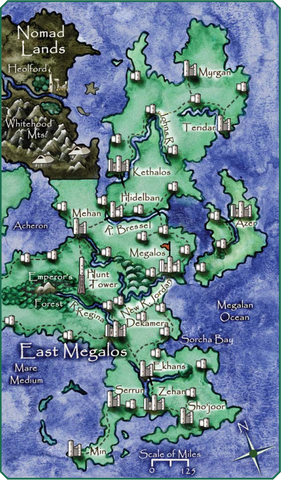
Megalos, Capital of the Empire
The seat of the nation and empire of Megalos is the city of the same name (which I'll refer to as Megalos City to avoid more confusion than need be). It is a bustling port city of 400,000 people, with a wide variety of human races and species all intermingling. It's also filled with all sorts of action:
GURPS Banestorm posted:
Megalos has never been peaceful. As the capital, it is plagued by conflict between court factions. Assassinations are commonplace, and the knights and men-at-arms of opposing nobles fight duels and brawls in the city’s streets. Corruption extends from the top to the bottom; the alleys hold cutthroats who would kill their mothers for two coppers.
History
Since it was founded by Simon Menelaus himself as the first stepping stone in his path to empire, Megalos City's history goes back all the way to 1200. It was a pretty big deal back in the day, with extensive sewers and city walls created by Menelaus II in 1290 AD and massive towers, marble architectures, and paved stone streets by the 1400s. Other big events in its history include the establishment of the Order of the Archangel Michael and purging of all non-Christians from the city in 1412, the design of a new palace in 1630 by Titus II, and the construction of a new city wall five miles past the original one by Metellus IV in the late 1800s.
Layout and Architecture
As noted before, Megalos City is a port city, with its heart surrounding the mouth of New River Jordan as it meets the Megalan Ocean. The area between the original city wall and its new wall host most of the well-to-do nobility, the Great Arena, and barracks for the First and Second Imperial Legions, while the areas within the old wall and either just inside or outside the new wall are where all the unsightly poor people and workers' guilds are pushed to.
Government
The Emperor is a hereditary monarch whose word is absolute, and all decisions come from either him or his retinue of high-ranking nobles and church leaders known as the Assembly. There is no local government beyond some civil service workers pulled from the Church and lower ranked nobles. Defense of the city is mostly in the hands of the city watch, who are decently paid but ultimately crushed by the nature of the city. Watchmen are kiss-asses to the nobles and accept any bribe because they know that to not do so would be flirting with the hangman's noose, and likewise are typically abusive to commoners as a way of letting off steam. Criminal investigations are handled by the Order of the Archangel Michael, and people who are indicted by them typically don't see the light of day ever again.
The Emperor's personal guard is made up of reptile men dubbed the True Dragons. This rather odd arrangement is due to an event centuries ago when a shrewd Emperor freed a thousand reptile man slaves and told them to have their way with an island that the Imperial Legions had been unable to conquer on their own. Grateful for the seeming act of benevolence, the reptile men of that island have had members of their people loyally serve the Emperor as his guard ever since. The True Dragons are unwaveringly loyal to the Emperor, inured to bribery (and are allowed to eat people who attempt to bribe them!), and are baptized Catholics. The current leader of the True Dragons is Captain Ah'ziranthl Dgansis Rextlyin, a strong and scarred warrior who's been on the job for two decades at this point.
Finally, there's the Emperor himself, Diophrates XII. Or at least that's who he looks like, but looks can be deceiving. Sixteen years ago, Grandmaster Jordan Siegebraker of the Knights Templar and an unnamed but influential Jesuit arranged to have Diophrates murdered by a demon. The demon, named Xuvutruobacaoly, turned out to be ridiculously powerful and also capable of transmuting himself and others. Xuvu took the form of the Emperor and reshaped the Emperor into his own demonic visage, killed him, and then framed the Emperor's head court wizard for the demon summoning. As a result, the official story of the whole event is that the duplicitous court wizard attempted a bid at power, but was stopped by Jordan Siegebreaker's valiant slaying of the demon in order to save Diophrates XII. Xuvu is an incredibly shitty ruler and hedonistic to a fault, but apparently the real Diophrates XII was garbage enough that nobody other than Captain Rextlyin finds anything odd about it.
Factions
While the Emperor is theoretically the most powerful man in Megalos City and the Megalan Empire in general, his power base is actually small and getting smaller by the year. An archbishop by the name of Sosius has been gathering up clergy who feel that it's probably a good idea to just axe "Diophrates" before he does even more damage with his thoughtless hedonism than he already has, while Diophrate's son Prince Miltiades and a large group of nobles who have pooled around him plan on doing the same thing for similar reasons. Jordan Siegebreaker and his Templars are the only people who aren't actively gunning for Xuvu's head, instead working to cover up the whole affair and keep the perceptions of the Emperor outside of Megalos City far brighter than they actually are.
Citizenry
Half of the population of Megalos City is human, and another 40% is a mixture of goblins and halflings. That final 10% is a clusterfuck of every other sapient race, and I do mean every one: even medusas, minotaurs, ogres, and orcs can be found in Megalos City. Almost everyone in the city is of the Catholic Christian persuasion, with anyone otherwise being either a visitor to the port or quietly keeping to themselves.
Places of Interest
Like politics? There's three spots you can head off to on your tour. The current Imperial Palace is a mishmash of architecture that looks aesthetically hideous, the Assembly Hall is a Gothic wonder, and the original palace of Menelaus is an aging and patched-over shadow of its former glory that acts as the headquarters of groups less important than the True Dragons, Emperor, and Assembly. If books are more your thing and you aren't a villein or lower on the social ladder, the well-crafted Imperial Library is decorated with unicorn and griffon statues and houses so many scrolls, maps, and books that you need help from a librarian to find most things. Sports fans can see the Great Arena, the Megalan knockoff of the Colosseum of Rome, which holds various gladiatorial spectacles and a biannual event called the Grand Elimination that involves 160 prisoners fighting to the death. Finally, while not exactly somewhere you probably want to go yourself, there are miles and miles of sewers beneath the city.
The Midlands
Hidelban
Hidelban is a duchy littered with streams and creeks, as well as the clean and clear River Bressel. It provides a fair amount of the agriculture that feeds the Empire, but it has a darker side in that its Duke, a young man named Cuin, seems to have an insatiable appetite for more land and power that seems to be spurred on by his advisor, Lord Claudius Maskill. The truth is that Maskill is a 299 year old vampire mage that has made Cuin into his puppet. While once trapped away in the 1700s when a knight trapped him in a crypt surrounded by a stream, one drought and a curious girl breaking into his tomb was all it took to get him back into the game of being a monstrous schemer who plans on taking on the Emperor. Maskill suspects that the Emperor is a demon, because "evil knows evil" according to the text, and he might actually be able to pull it off; while only the first character with an actual stat block so far, he is one of the strongest overall, with 525 points to his name.
Hunt Tower and the Emperor's Forest
As the private hunting grounds of the Emperor and the traditional fiefdom of the princes of Megalos (since it's hard to raise a rebellious army when you don't have any sapient subjects in your land), the Emperor's Forest is a place where poaching is punishable by death and wildlife thrives. Hunt Tower is a five story tall stone tower that acts as both a hunting lodge and feasting hall where nobles get to feed on rare magical beasts. Hunt Tower is lead by the Imperial Huntsman, Marquis Honore Bourmont, who is probably the best unstatted NPC we've been told about so far because he has helping with Prince Miltaides's plans for usurping the throne by capturing and training monsters to attack the Emperor.
Mehan
The duchy of Mehan has grown rich on the trade and fishing from Lake Acheron, which it almost exclusively holds land around. Copper ore from the Whitehood Mountains, grains and mustard from fertile farms, and sheep's wool augment this already lucractive land. The city of Mehan itself also has the distinction of being the location of the elaborately-crafted St. Paul's Cathedral, where the Curia meets for its conclaves and various Catholics make pilgrimages to. Unfortunately for the pious folk, the heresy of the Manites has been quickly gaining hold in Mehan, which has the Mehanese archbishop Vittius in a fit of rage.
The Northern Marches
Leaving the cities and farming towns in the northern reaches of Megalos is a horrible idea, because nature has it in for you. Vast moors and pine forests are home to bears, boars, nightstalkers (giant nocturnal bears), treetippers (a fantasy name for the Pleistocene giant ground sloth Megatherium), and wolves, while its icy waters are home to sea monsters such as krakens.
Azer
A port city on the eastern island of Dyecastle, Azer is home of the Templar College of Battle Magic, where wizards of the Knightly Orders and the Imperial Legions are trained in the art of magical combat. There is also a large Jesuit mission on the college grounds, which was created as an attempt to learn of any weird magical traditions the Jesuits might have but ended up failing to open up their lips on such subjects.
Kethalos
The county of Kethalos is up in the northwest corners of Megalos and is built along the Johns River. The city of Kethalos probabl wouldn't look too out of place in Skyrim, with numerous timber buildings supplemented by a handful of stone ones and a large fishing fleet. Count Darius is a skilled knight who is famed for having driven back Northmen raiders in the 1990s, but is far better at fighting and hunting than he is at actually ruling. His lack of managerial skills have only emboldened the Northmen, who have begun to engage in more and more raids of towns on the northern fringe of the county.
Myrdec
This city is at the edge of the Yrth equivalent of the Arctic Circle and relies heavily on trade with the Nomad Lands and Sahud for its livelihood. Former merchant's guild leader Baron Walsham Markant has helped Myrdec become the prosperous hub of trade that it is, and under his benevolent leadership the largest population of Sahudese people outside of Sahud has grown up within the snow-flecked walls of the city. Unfortunately, some particularly racist Megalan merchants have become angry that a lot of business goes through the Sahud parts of town before their own, which has lead to increasing tensions:
GURPS Banestorm posted:
Attempts to intimidate the Sahudese traders verbally are met with feigned if polite incomprehension. The few instances of actual violence have been repelled by stunningly effective martial arts and occasional magic. The situation is on the verge of deteriorating into outright war.
Teridar
Teridar is a city known for hosting one of the few Thomasite hospitals in Ytarria, having mild winters thanks to its location nestled within a river valley flanked by a cove, and also having lots of slaves. Earl Sigmund Bonus uses his large slave population to both work one of the largest lumber operations in Megalos and host some of the most elaborate gladiatorial games outside Megalos City. The slaves are now plotting revolt, as the Earl's requests for freeing slaves that win in his gladiatorial games are being mysteriously refused by the Emperor time and time again.
The City of the Dead
Legends say that there is an island city of necromancers and undead monstrosities somewhere in the vast waters of Lake Styx. Does it really exist? Nobody knows, because no one ever comes back with proof and the only supposedly reliable records of the city are kept by the Ministry of Serendipity.
The Southlands
The Southlands enjoy a pleasant Mediterranean climate and fertile fields that allow cotton, grapes, and olives to grow easily. The Southlands also enjoy a lot of settled land and few dangerous predators. Basically, the Southlands are everything the Northern Marches aren't.
Dekamera
Yet another big, important port city, Dekamera enjoys trade with other parts of the Empire, Cardiel, and al-Wazif. That last one is rather surprising, as it is stated that the late Earl Gavin Magnus loved throwing his fleet of privateers right into Wazifi towns. His son, Taveon, was captured during one of these raids, and Magnus died before he was released. As a result, in spite of being treated as a guest rather than a prisoner by the Wazifi people and returned home after the Frontier Wars, Taveon hates the Wazifis and plans on starting the privateer raids back up again.
Ekhans
While the duchy of Ekhans has been made rich on cattle ranches, plantations, and vineyards, it has fallen on an unexpected blight in recent days. At least five dragons make raids on the vast cattle grazing grounds in the dead of night, stealing away the most healthy and valuable members of the herds. No one knows why they are doing this or even where their lair is, so it seems that the raids will continue for the foreseeable future.
Min
At the very bottom of the mainland holdings of Megalos, Min has the misfortune of being situated in rocky land that isn't conducive to farming and bordered by shallow ocean that cannot harbor large merchant ships. Its people struggle to survive on fishing, clam diving, and ranches that raise milkfish (manatees and dugongs). Min has also become a haven for pirates, as it is both a key staging point for raids of major shipping lanes and a convenient place to spend coin at the end of the day. Baron Martignac of Min allows the pirates to keep doing what they do because of the fact that their revelrous spending is helping his city and barony keep afloat far better than the nearly nonexistent aid from his Empire has.
Serrun
The hold of Archbishop Nikolai of Serrun, this city thrives thanks to its wildly successful vineyards and cotton plantations. The fact that is on a rocky cliff face means that its trade is mostly done overland rather than by sea. The greatest difficulty for Serrun is that Nikolai, for all his benevolence and devotion to the people, is currently heavily caught up in the politics of the Church over his hold. While the Archbishop's thoughts are elsewhere, the people's minds have been turned against Nikolai by Count Sergius of Shambray, a scheming power-hungry lord who seeks to take over much of the Southlands through subterfuge. Nikolai knows of Sergius's deceptive ways, however, and it is likely that the conniving lord will overreach his boundries sooner or later and be sent crashing down from the social ladder he's so desparately trying to reach the top of.
Sho'joor
Sho'joor was once a thriving port for anyone traveling through the southern sea between Megalos and the two Muslim nations, piracy has all but wrecked the livelihood of the city. The goblin duke Yivirrl of Sho'joor recently managed to acquire a minimum amount of aid from the Imperial Navy, but it's very much a case of too little and too late. All it would take to plunge the city into total poverty would be either one particularly huge pirate raid or the Emperor recalling the handful of ships guarding Sho'joor back to Megalos City.
Zehan
Like Sho'joor, Zehan is dying by a thousand cuts of piracy. The difference is that Count Aloysius has no faith in the Emperor and is instead appealing to sea elves, merfolk, and the proud sea warriors of Araterre in an attempt to find and crush the pirate strongholds once and for all. It is likely that if Aloysius manages to succeed in his hunt, Zehan's return to prosperity as a trade port will come with the side-effect of war with an angry Min.
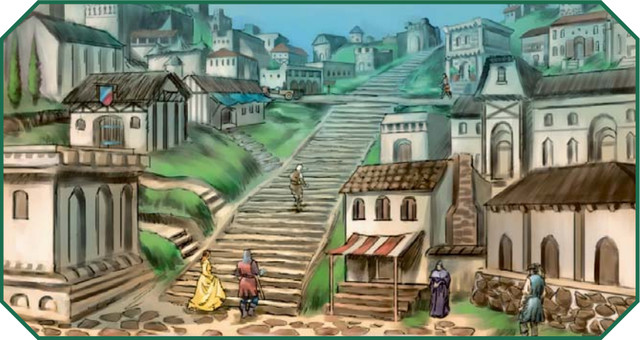
Western Megalos
Past Lake Acheron, the Megalan territories become less fertile, mild grassland and meadows and more a mixture of dry prairie and savannah. American bison, African antelope species, wild horses, and zebras all roam free on the great grasslands, and farmers rely on pecans, peaches, and wheat as their staple crops.
Arvey
Arvey sits in the foothills of the great Bronze Mountains, making it a key location for trade with the dwarves of Zarak. It is a city of stone and stairwells for streets, with lots of hills and steep inclines.
Craine
The wondrous marble and granite buildings of Craine are symbols of its opulence, a city built on trade with Caithness, the bounty of the River Conn, and massive ranches of bison, cattle, and sheep. The fiefdom that Craine sits upon is also the largest in western Megalos. Unfortunately, this also means that it was the easiest place to throw Megalan soldiers at al-Wazif, and the duchy has been sieged or even taken by Wazifi forces more than once in its long history. The warmongering Duke Bran of Craine is certain that al-Wazif will strike again, and wishes to instead strike first, but he is currently stalled by his own indecision over whether he should declare western Megalos its own nation and rule it as king or attempt to take over the position of Emperor and thus have all of Megalos under his thumb.
Hyrnan
Hyrnan was once a small duchy settled between the Blackwoods and Keyhole Bay. That is long in the past, however, as the fact that the Blackwoods have been actively growing threw it into being the staging grounds for discovering the mystery of the great forest's expansion. From the 1980s onward, attempts were made to cut through the great wilderness and find out what the hell was going on, but each time the Legions sent in would fall to disease, mysterious disappearances, and strange night terrors. It wasn't until two Legions with five times the normal amount of battle mages in tow entered the Blackwoods in 2002 that the problem would be solved. While they were struck by inexplicably fevers, voices in the night, and giant woodland beasts, they were simply too large to be overcome, and eventually found a huge elven village that had been deserted very recently. The village was burned and the trek back to Hyrnan was a peaceful one.
This was proof that the dark elves had survived the first Banestorm and hid in the Blackwoods, but the truth of its ominous transformation is a bit more complicated. Even the dark elves are not sure of what the massive slime-drenched tree that grows in the Blackwoods' center is. It is alive, extremely powerful in its magic, and hateful of all living things, capable of fleshwarping and mind-tampering the native wildlife as its toxic influence spreads outward and increases the size of its dark forest. Of course, seeing as the dark elves are xenophobic assholes, nobody would probably believe them if they told anyone, so everyone thinks that the Blackwoods dilemna is their fault. The citizens of Hyrnan have become spiteful towards all elves regardless of their allegiance, and Duke Tunstall Dubhagain has continued to fortify the city with soldiers and mages to ward off attacks from the forest.
New Jerusalem
The Knights Hospitaller run this city, and under their rulership it has remained one of the most autonomous regions of Megalos. New Jerusalem may pay taxes to the Empire, but the Hospitallers only come when they are called if it is convenient of them, and they have technically never sworn fealty to the Emperor at all. Being a Hospitaller city, New Jerusalem isn't tolerant of anyone who uses magic, isn't human, or isn't a particularly conservative Catholic. Grandmaster Geoffrey Freeman wants to cave in some Wazifi skulls again in the near future, but he also realizes that it would probably go sour if he can't get an army together and the Hospitallers went in alone, so for now he whips up fervor in other Megalan regions while keeping his knights from jumping the gun.
Quartedec
This fiefdom is run by Earl Hadrian of Quartedec and is found in the far north of western Megalos. It is a land of marshes, pine forests, and icy mountains, right at the doorstep of both Zarak and the Nomad Lands. The Baran River, flowing out of the Bronze Mountains down to Lake Styx, was the sight of a major gold rush when humans of Quartedec learned of its rich panning potential in the 1980s. So much gold was taken that prices plummeted and the dwarves of Zarak were angered, complaining that the gold flowed from their mountains and was thus theirs. The dwarves have repeatedly attempt to buy the river from Earl Hadrian, to no avail, but mysteriously stopped in late 2004. They have instead begun to ask questions about Earth. Is it a coincidence that these questions started after they began digging heavily at the headwaters of the Baran River up in the Bronze Mountains? Probably not, but who knows.
Raphael
Raphael is an archdiocese that was only created in 1855 as part of the official border demarcation between the Empire and al-Wazif. As a result, many of its residents are of Muslim descent, and a few even keep to their religion and defend a handful of mosques that weren't torn down during the Christianization of the city. Most of the lifeblood of Raphael is through breeding and selling horses to Megalan knights and nobles or trading with al-Wazif, and the majority of the Empire ultimately ignores the city.
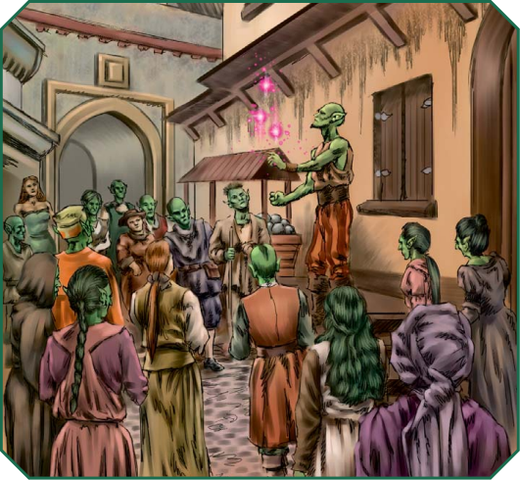
Yibyorak, the Goblin City
History
Five goblin clans settled at the mouth of the River Yvosek shortly after the first Banestorm. This settlement eventually became a town, then a city, and then the capital of an entire kingdom known as Yibyorak by 1175. This kingdom became a duchy of the Empire in 1229, and has since become a place of prosperity...most of the time. Every war with al-Wazif has seen Yibyorak's port being blockaded, and its people have taken to stockpiling their gains in order to avoid suffering too much during these conflicts.
Layout and Architecture
Yibyorak covers the two shores of the mouth of River Yvosek and the entirety of the rocky Memanjik Island. While humans have tried to force Yibyorak to fit the mold of Megalos City, its goblin architecture of adobe, brick and granite in labyrinthine patterns that twist and turn through narrow streets and disparate city walls refuse to give way so easily. The two greatest feats of architecture in Yibyorak are the immense Bajik Bridge, said to be able to hold a hundred full ox carts without so much as a stone quivering, and the Ekmekyk Channel, which was built in the 1990s to supplement already burgeoning ship traffic up to Lake Acheron.
Government
The duke of the Yibyorak duchy appoints a governor to rule the city, and under the governor is a set of five lieutenants. Each lieutenant oversees a section of the city referred to as a demesne, with the five sections being named after and corresponding to Clans Bojich, Bricik, Kurnjaych, Memanjik, and Saratlik, the five goblin clans that founded Yibyorak. A merchant guild known as the Yibyorak Merchant's Council also has a fair amount of sway in the government. It costs five Megalan pounds a year to have a seat on the Council.
People of Yibyorak
Yibyorak is 60% goblin and 30% human, with the rest of the population being primarily halflings and dwarves. It is also one of the few places in Megalos where there is a large Muslim population, most being merchants or descendents of merchants. Thanks to the goblins' love of magic, there are numerous practicing mages in the city, from street performers with minor tricks to extremely powerful wizards.
Places of Interest
The Ducal Tower of Yibyorak literally stands head and shoulders above the rest of the city's architecture, being an eye-popping twenty stories tall and hewn from gray stone in a combination of traditional goblin and Gothic artistic styles. While the duke's private residency is at the top of the tower, its lower floors have everything from shops and restaurants to civil offices and residential apartments. Another major landmark is Covik Park, a large swath of greenery in the middle of Memanjik Island that was created as a memorial to residents that died to a vast fire in 1864. Finally, there's the grand Yibyorak Market, split up into the Common Market and the Goods Market. The Common Market is a maze of streets choked with shops and stalls selling all manner of goods, while the Goods Market is effectively the first (and so far only) case of a stock market cropping up in Ytarria.
The Brothers of Mercury
While it may seem wondrous and about as perfect a city you can find in Megalos, Yibyorak has its flaws as well. The largest is the brothers of Mercury, a thieves' guild and cult to the Roman gods that ruthlessly runs the underworld of the city. Members of the Brothers carry a copper coin with the caduceus of Hermes/Mercury etched into one side, used as a symbol of their bond and loyalty. A goblin wizard name Shuuv'kopekk rules over the Brothers of Mercury and uses his powerful magic to provide boons in the name of the guild's god. Brothers are kept loyal both through the riches they earn and the fact that traitors are murdered in particularly gruesome and creative ways.
Next Time in GURPS Banestorm: Island life with Araterre and company.
Chapter 4 Continued: Araterre
Original SA post
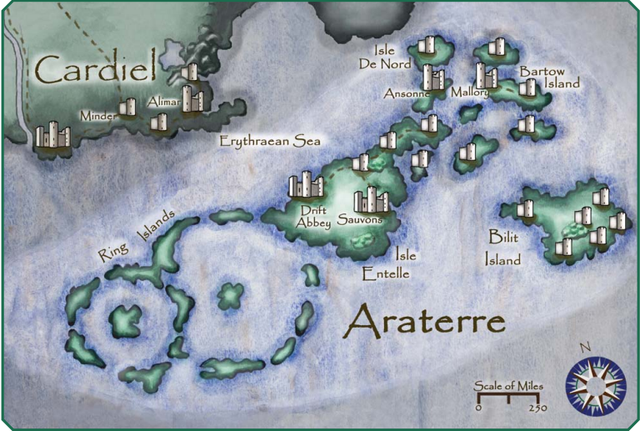
Chapter 4 Continued: Araterre
The Principality of Araterre consists of the various large islands and island chains sitting south of mainland Megalos. It is governed and policed by the Megalan Empire thanks to its major Banestorm drop being a bunch of gun-wielding Protestants and ornery Jesuits that caused widespread panic and fear.
Geography
Most of Araterre is made up of subtropical to tropical islands that have been heavily deforested and used for sugar cane, tea, and spice plantations by French and Spanish colonists, so it is more or less Literally the Caribbean. The only exception is Bilit Island, which takes the role of the Hollywood jungle island with fierce wildlife and even fiercer locals.
History
Protestants and Jesuits came in the 1500s, Megalos got pissed, the Protestants were all but wiped out while the Jesuits fought so bitterly and tenaciously that their status as heretics was repealed fairly quickly, and in 1652 the region was declared a principality of Megalos. That's about the long and short of it. Oh, and some Balinese Hindus came in the 1800s and didn't get wiped out because they had fancy new crops to share, so there's that.
Society
While Araterre technically follows the same social rank conventions and such as Megalos, having its own prince and various aristocrats down the ladder, their power is hollow compared to their counterparts in the Megalan mainland. Instead, the merchants and the Church hold the biggest pieces of the pie across the principality. It's suggested that they are powerful enough that they could overthrow the monarchy entirely and become the next Cardiel or Caithness if they didn't hate each other so much that they'd never work together.
Technology
In spite of Megalan efforts to keep the world grounded heavily in the Middle Ages and its success at gun control, Araterre retains Renaissance-era ships, swords, architecture, and agriculture. Aralaise shipwrights and armorers are a pretty big deal, and keep the secrets of the crafting of their unique sea vessels and fencing swords pretty close to their chests to avoid foreign competition in said crafts.
Nonhumans
Sea elves and merfolk are both found in the waters around Araterre, but they're pretty much the only native nonhuman sapients. The Aralaise are made up of people who are either open-minded or keep their prejudices about other species to themselves in an effort to look welcoming, however, and other nonhumans are treated well when they come ashore. Goblin merchants in particular are common visitors.
Magic
Unsurprisingly, a group of formerly Protestant people who were attacked by a magic empire don't have great opinions about the wizardly arts. Who would have thought? The Jesuit and Thomasite clergy are pretty much the only people with a great working knowledge of magic in Araterre, and it's generally frowned out outside of the Church.
The Law
Legal practice in Araterre isn't all that different from in Megalos, though slavery has fallen mostly out of favor compared to imprisonment.
Fencing
And what would the not-Caribbean be without some buckling of the swash? Combat in Araterre is fast and maneuverable, as armor is impractical in the heat of its islands, and the weapons of choice are rapiers, sabers, and smallswords, as well as a few cases of the main-gauche and kris blade. The Aralaise even have dueling academies that teach weapon skills, Acrobatics, Cloak, Carousing, and Sex Appeal to their students.
The Fiefdoms
Araterre is divided into fiefdoms that make up either part of or the entirety of an island. They aren't really different from fiefdoms in Megalos, though the local lord typically has a private fleet rather than horse-mounted knights due to obvious reasons.
Sauvons
One of the two fiefdoms on the large Isle Entelle, Sauvons is both the capital and the cultural hub of Araterre. Combat in Araterre is fast and maneuverable, as armor is impractical in the heat of its islands, and the weapons of choice are rapiers, sabers, and smallswords, as well as a few cases of the main-gauche and kris blade. The Aralaise have their own dueling academies that teach weapon skills, Acrobatics, Cloak, Carousing, and Sex Appeal. Most of the population's food comes from the sea, either through fishing or Sauvons's numerous manatee farms. Prince Arnod de Sauvons rules from this city, for some measure of the word "rule". He's not particularly skilled at speech, and he cares far more about hunting and affairs with various mistresses than he does about governance. His wife, Princess Acarie, is the far more politically savvy of the pair, and was once ruthless in undermining anyone who could threaten her place in the system before she finally bore a son that secured her position for good. Sadly, the young Francois de Sauvons has always been gravely ill, and requires a retinue of healing wizards at his side at all times.
Drift Abbey
Drift Abbey was around before most Aralaise even came to Araterre, having been settled way back in 1175 by some Benedictine monks who happened to come across the island chain. It is now the headquarers of Andrew of Hidelban, Archbishop of Araterre. Andrew is rather different than his predecessor, Jacques-Jude LeBlanc: while he may not be as skilled in oratory or theological debate, he is nonetheless passionate about the faith, and also keenly aware that the Curia's insistence on keeping watch on the Jesuits is probably meant to keep the Aralaise Church and the Jesuits at odds with each other to avoid any political upheaval. While Jacque-Jude towed the line concerning the Jesuits, Andrew is convinced that if he can work with the Jesuits the two can break the great influence the merchants have in the court of the prince.
Ansonne
What was once the second mightiest city in Araterre is now known by the rather unflattering title "Wickedest City in Ytarria". The blame for this falls on the prince's younger brother, Duc Remis d'Ansonne, and his corrupt Wazifi advisor Jafar as-Siyassi. While claims that Jafar is a Hashishin, diabolist, or even a demon are probably overblown tales, it's true that he has been puppeteering the rise of the criminal underworld in Ansonne, flooding its streets with thieves and pirates of all stripes. He is also probably running a network of Wazifi spies throughout Araterre, though that one is less certain.
It is also in Ansonne that we get our second actually statted NPC, the 208 point Catherine de Melies. An attractive woman whose mostly Asian heritage is contrasted by pale blonde hair, Catherine was once a favored mistress of the prince, but was kicked out when she proved unwilling to be subservient and silent when he eventually grew bored of her. She used the prince's parting gifts to pay for a fleet and a crew, making herself a self-styled pirate queen. She now loves striking blows to the royal navy of Araterre as her ships plunder the Eastern Isles. While rather waifish and only slightly skilled in knife fighting, she makes up for her lack of physical prowess with charisma, cleverness, a fair amount of ranks in the Tactics skill, and loads of money.
The Ring Islands
The Ring Islands get their shape from two meteor impacts in Yrth's deep past. These impacts also greatly affected the magic of the region, making it wild and unpredictable – you can start out an area that greatly boosts necromantic magic and cripples healing magic, and then just half a day's hike later be in a place where it's suddenly boosting fire spells and baning water ones. The islands are also home to ferocious monsters such as acid-breathing feral dragons, giant man-eating bats, tigers with chameleonic skin, and sea serpents. Even the mundane animals in the island chain are things that are exotic and frightening to most Ytarrians, such as pythons, crocodiles, and gorillas. The only permanent habitation in the ring islands are scattered pirate hideouts.
Bilit Island
An island of thick forests and semi-active volcanoes, Bilit Island is home to people descended from various Mesoamerican civilizations. While only at Bronze Age technological advancement, they are ferocious warriors aided by powerful wizard priests who sacrifice captives to various gods from southeast Asian and Mesoamerican cultures, demons, and Great Old Ones. To make things even worse on invading armies, the wilderness around the cities of Bilit Island are filled with violent monsters and giant reptiles that may or may not be dinosaurs. Even the Megalan Empire learned fairly quickly that it would probably be more beneficial to trade with the Bilit Islanders than attempt to conquer them, even with their xenophobia and various unknown taboos making life difficult on traders anyway. And trade they had: jade, obsidian, strange hides and feathers from local wildlife, mahogany wood, vanilla, capsicum-laden peppers, and chocolate are all unique exports from the southern island. They also have loads of gold in the biggest deposits outside of the dwarven lands. In return for their own goods, the Bilit Islanders typically demand wine or steel weaponry, the latter to augment their own arms of bronze and obsidian.
Next Time in GURPS Banestorm: Civil war and Silver Hands in the land of Caithness, and also a longer entry than the one this time.
Chapter 4, Part 3: Caithness
Original SA post
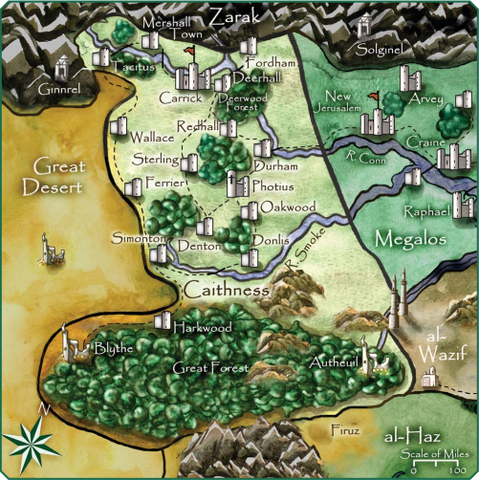
Chapter 4, Part 3: Caithness
Populous, glamorous, prosperous, and stable: none of these words describe Caithness as a whole. What was once part of the Megalan Empire's western expansion is now a tattered mess of feuding baronies without a strong king to unify them, with a people-to-land ratio akin to Alaska.
Geography
While central Caithness is known for its gently rolling hills and forests, as you get closer to its borders there are adverse situations in every direction. Heading west leads to the edge of the Great Desert, in the east there are badlands with piss poor soil, to the north there are the imposing foothills of the great mountains of Zarak, and in the south is the vast Great Forest. The eastern border of Caithness is officially demarcated by the point where mana starts going from normal to low levels, but Megalan forces frequently fuck around in the badlands anyway. Bridges and roads are shitty dirt tracks traveling large expanses of uninhabited land between small townships, and crops of wheat, rye, and barley are the main staples of the farms around said small townships.
History
Caithness of the late 18th Century is rather bluntly described as being mostly great for colonization with the exception of having "not enough mana, and too many orcs". Conall of Craine was the first Megalan to make a concentrated effort at colonizing the region in 1784, slowly but surely driving the orc tribes further and further west. Eventually, in 1812, the orcs were driven into the Great Desert and so thoroughly demoralized that they decided to cross the seemingly endless waste and find a new home far away from the invaders. The territory was officially made a Megalan county in 1822, only for Conall to rebel and declare himself king a scant four years later. His ally, Archbishop Constantine of Clixtus, similarly broke away from the Curia, which meant that Caithness was both spiritually and physically separate from Megalos. It wasn't long before the Curia and the Emperor of Megalos at the time got the Knights Hospitaller hooting and hollering about murdering heretics again and sent both them and the Legion flooding into the rebelling nation. Unfortunately for them, the battle mages of the Imperial Legions couldn't handle having to fight in low mana conditions and abandoned the Hospitallers to face a death of a thousand cuts from small but relentless Caithnesser guerrilla attacks.
Things went back to normal fairly quickly after the initial chaos. Megalos and Caithness opened trade with one another, the Curia accepted the Church of Caithness back into their fold in 1844, and the dynasty of King Conall reigned supreme. This cheery movement forward lasted until 1975, when King Morill III died an unexpected death, leaving his son Conall VI king at a mere six years of age. The already headstrong nobles of Caithness ignored any orders from the child king or his mother, Queen Alys, and the stability of the nation began to roll downhill at an alarming rate. The final breaking point was when Deneral, a former lord who was exiled after a failed coup in 1994, used increased taxation in the region of Donlis as a rallying cry for yet another rebellion in 1999. Thus began the Caithness Civil War, a ferocious conflict between lords who shored up with either Conall VI or Deneral that has yet to end.
Society
Caithnessers as a whole are a society of strong-headed outsiders. They see Megalans as pretentious and decadent assholes (which is true, to be fair) and highly value physical pursuits and self-reliance.
Social Status
Caithness has the same feudal social ranks as Megalos, but also has a far greater acceptance of social advancement. Shows of intelligence and gumption are typically rewarded, and any freeman can potentially be knighted if their deeds are suitably brave and talented. The only particular difficult transition is becoming a lord, which requires the trust and acknowledgement of the King himself, a period of faithful service, and swearing loyalty to the King.
Women in Caithness
Caithness is one of the few places on Ytarria that has any sort of feminist views, and women are typically pretty accepted in any pursuit. Even the knighthood has an increasingly large number of women ever since Dame Devin of Fordham was knighted in 1934, and only particularly conservative outlets such as the religious order of knights known as the Dragons have withstood the march of time.
Nonhumans in Caithness
If they're Christian, most nonhumans are pretty well accepted in Caithness, especially hardy species such as halflings and elves. The only exceptions are orcs and reptile men – as both species have a large number of barbarians in the Great Desert, it's not uncommon for individuals to be lynched without qualm if they don't have a member another species on hand to both vouch for them and "chaperon" their activities.
Magic in Caithness
Any Caithnesser wizard has either worked their ass off to be able to cast spells reliably even in the low mana conditions of the nation or parked their tower over the scattered handful of meteorite impact sites that create small pockets of normal or even high mana. Over the past decade and a half, the badlands near Megalos have slowly been shifting from low mana to normal mana for unknown reasons. While not enough people stick around in that area for it to have made an impact, it seems to indicate that something is beginning to shift in the seemingly set-in-stone nature of the mana zones ravaged by the Bane so long ago.
The Law
Caithnesser law isn't all that different from Megalan law, save for a greater emphasis on compensation over retribution. Fines to be paid to the victims or their families are preferred over death or imprisonment, and are sometimes very high if the crime is severe. If you can't pay for the fine outright, you get sold into slavery to the King, wherein your labor pays for the fine.
Slavery
Outside of the above case, slavery isn't common in Caithness. Slaves in private hands either willingly became slaves (for whatever reason) or are captured slaves such as orcs from raider bands.
The Civil War
If you have a nation wracked by civil war, you can be damn sure there's going to be a section of the text talking about that civil war, and here it is. While its name brings to mind violent combat and tragic loss of life, the Caithness Civil War is actually closer to the Cold War than most well-known Civil Wars in Earth history, with a lot of espionage, small-scale conflicts, and sabotage with only the occasional actual all-out battle. The lordings/baronies across Caithness have fallen in line surprisingly thoroughly given the whole hard-headed and independent nature of Caithnesser nobles: Deerwood, Durham, Fordham, Redhall, and Tacitus all have lords that have thrown in their lot with King Conall VI and his lording of Carrick, while Denton, Donlis, Ferrier, Oakwood, Sterling, and Wallace are all rebel holdings. The only holdouts that remain neutral are the ravaged land of Blythe, the archdiocese of Photius, the elven stronghold of Harkwood, and Simonton with its apathetic lord. On a species level, elves are extremely opinionated about their neutrality, dwarves want the king to reunify and rule over Caithness so they can get back to the business of trade, and halflings support whoever the local lord supports.
The Royalists
Carrick
Since it's the seat of the crown, it's kind of obvious that Carrick would be a portion of Caithness still in support of its king. Kings have ruled from the castle overlooking River Conn and Carrick Town ever since the very first Conall left Megalos in search of fame and glory, and this long history has lead to a modern population of 20,000 city dwellers and over several hundred thousand peasant farmers that reap the bounty of some of Caithness's most fertile soil. Having a direct line of trade with mighty Zarak to the north probably doesn't hurt the lording's wealth either. Carrick Town plays host to the two organizations that work for the king as well. One, the Silver Hand, is a mysterious spy network that is spread across Caithness and may or may not engage in assassination attempts against rebels. The other is the far more open and well known Order of the Stone. A knightly order whose goals are the upholding of the chivalric code, loyalty to the king, and the suppression of chaos, Knights of the Stone are to expect no land or glory for their services and are typically idealists and romantics as a result. The Order is also particularly inclusive: men and women, humans and halflings, elves and dwarves, all are welcome within the fold. While Megalans treat the Order of the Stone as common filth daring to parade around as knights, Knights of the Stone have been known to trump Megalan knights in duels again and again.
King Conall VI himself gets mentioned here as well, complete with a 303 point stat block. While that's a big number, most of it is in social skills of various stripes and a load of wealth; Conall VI's actual attribute scores aren't particularly special, nor are his combat skills all that well-honed. His description paints him as an unsurprising result of being a boy king who grew up to a man in unpleasant conditions, having thrown all of his devotion into his kingdom to the point that he is actually kind of socially awkward when working face to face, especially with women. His lack of a wife has greatly annoyed his advisers, who are sick and tired of being told that the civil war and the safety of kingdom matter more than having a woman with which to birth an heir to the throne. Allies see him as a goony but well-meaning ruler with a kind soul, while his foes feel he is an emotionally stunted man-child who clamors for far more power than he deserves.
The Former Barony of Mershall
While once its own lording at the far north of Caithness, Mershall is now technically part of Carrick, much to the consternation of some of its citizens. Zarakun traders frequently come to the region for its beer-friendly grains, timber, iron, and silver.
Deerwood
The heavily forested land of Deerwood is known for two things: plentiful game animals, and dangerous packs of angry gryphons that were introduced by the servants of King Morill three decades ago. It is lead by Dame Lorena of Deerwood, a Knight of the Stone and staunch supporter of Queen Alys and King Conall VI. As she has just reached age 50 but has never married, she has decided to name Sir Phillip of the Knights of the Stone as heir to the kingdom. Gossip hounds in Deerwood have been making false assumptions that this indicates an affair between Lorena and Phillip, and it's speculated that his eventual rise to lordship won't be taken in stride.
Durham
Durham is the youngest but most famed of the lordings of Caithness, having been created in 1926 when the legendary hero Peredur Orcslayer did exactly what his name says and cleared the territory of the last of the great hordes. Orclsayer's granddaughter, Bronwyn, is the current baroness of Durham and a loyal supporter of Conall. Conall has fallen madly in love with Bronwyn, but ever since her last husband died of cancer she's only had her mind on the civil war, and Conall's attempts to get her attention have been less than graceful. Baroness Bronwyn also happens to hold a great secret: she has been covertly aiding a massive firearms manufacturing operation deep in the most inhospitable reaches of her barony, a fact that would most certainly shatter the people's adoration of her rule and attract the vengeful eye of Megalos were it to ever become public knowledge.
Fordham
The northeastern lording of Fordham is a land of fields and forests that engages in heavy trade with Megalos. Lord Berd's loyalty to the King is only tenuous, as he's scared shitless of the idea of Megalos breathing down his neck if he were to become too involved with the ciivl war. Also major to the running of Fordham is the wizard defense manager Blake and his treasurer, Niall of Fordham. Niall is particularly interesting, and not just because he's another character with an actual stat block. Niall was Neil Shefford by birth, and was a normal everyday accountant in Chicago before being eaten up by a random tiny Banestorm while on a hike in 1993. After being found by Blake and given lodging in his tower, Neil learned Anglish, changed his name to Niall, and cozied up into a profitable living as being the money-changer for a wizard who knew absolutely nothing about finance and good business sense. Niall would love to get back to Earth, or at the very least advance the technology of Ytarria, but he knows that neither of these is all that likely. He's also so paranoid of the Ministry of Serendipity that he keeps a journal in English that he checks daily just to make sure his memories haven't been tampered with.
Redhall
An old and storied stronghold, the mighty red granite castle of Redhall has withstood the ages and weathered the storms of the past thanks to being in between stronger neighboring lordings. Unfortunately, it's now right up against the rebel lording of Sterling, and Lord Lathan Redbeard is considering defecting if the civil war continues to threaten his citizens and cut his beloved hunting trips short.
Tacitus
Another young lording that was gained during the final advances against the orcs, Tacitus is settled in the forests at the foot of the mountains of northwest Caithness and famed for its huntsmen and archers. Baron Elohar is a former knight and known for having friends in high places, as on top of King Conall VI he also has the allegiance of the mighty dwarf Fedor Ironthews of the dwarven city of Ginnrel.
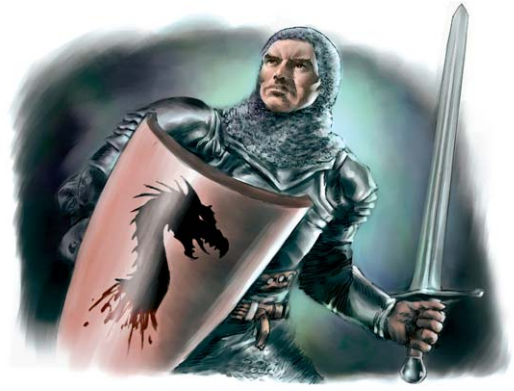
The Sterling Rebels
Denton
Denton has lots of fertile fields and forests, but its citizens are wallowing in poverty thanks to the fact that Baron Cabble of Denton is a conniving money-grubber. Denton sees the civil war as a chance to expand his lands, and sees the rebel lordings as merely more land he can either squeeze resources from or potentially take over if the tides turn in that direction.
Donlis
For the place that sparked the entire Caithness Civil War, Donlis doesn't seem all that intriguing at first look. It's a backwater lording made up of marshes and bayous along the River Smoke, Donlis Town proper's wealth being made by boatmen who ferry goods downriver to Megalos. In 1999, the Silver Hand found evidence that Lord Marsden of Donlis was actually allowing swamp pirates to attack Megalan traders in exchange for a cut of their booty, which lead to Conall's increased taxation on Donlis as retribution. And, of course, that taxation was the wedge Deneral used to provoke the civil war in the first place. The civil war has actually caused Marsden to fight against the pirates now that they have started preying on local Donlis ships.
Ferrier
Ferrier is a lording at the edge of the Great Desert, supplied by sheep farms and underground aquifers that allow it to stay productive. The reptile men in the region have come to a sort of understanding wherein the are allowed to steal at least a few sheep every once and a while, but can never harm a human lest they suffer reprisal. Baron Nabbick of Ferrier doesn't actually care about the rebel cause so much as he just really wanted to be tax exempt and have greater financial control of his lording.
Oakwood
While a rather uninteresting general "forest and fields" part of Caithness, Oakwood is infamous for the vicious Lord Brance. The nephew of the former lord who died from illness in 1996, Brance is arrogant, violent, racist, and generally an unpleasant person. The halflings of Oakwood have turned to the Royalist cause and gladly act as spies, while the human subjects are preparing to overthrow Brance and replace him with someone who actually cares.
Sterling
In a sea of power-mongers, tax evaders, and general assholes, Sterling's Lord Towne stands out as being a genuinely idealistic man who believes that the rebellion is in the best interest of his people and honoring the memory of his late father, who Deneral claims should have been king in Conall's stead. Sterling is well known for its alcohol, particularly the barley beer Sterling Gold and clear whiskey Sterling Silver, both of which are sold for luxurious prices as far away as Cardiel.
Wallace
Another shepherding town on the fringes of the Great Desert, Wallace is famous for a large gold mine several days away. The mine seems to be subject to a dark curse, however: every time someone decides to strike it rich, they manage to haul out a large amount of gold, but then suddenly have all their workers disappear without a trace. Just what's down in the mines is a mystery, but some claims include reptile men, orcs, a dragon guarding its hoard, or even undead dwarves. Lord William of Wallace is another actually idealistic member of the rebellion, who joined out of resentment toward Connal for protecting the throne against Deneral in 1994 instead of helping the citizens of the far-flung Castle Defiant as they were besieged by orcs.
Photius
While technically in rebel lands, Photius is neutral due to the fact that it is the archdiocese of Archbishop Siccius and subject to the Church rather than to Caithness. Photius is known for housing one of the only two Hospitals of the Order of St. Alyce. The nuns of this order are known for being extremely competent healers, capable of performing what seem to be miracles that surpass even most healing spells. Also housed in Photius is the keep of the Order of St. George of the Dragon. Members of the Order, typically just called the Dragons, are basically Hospitallers but with magic: they bar women and nonhumans from their ranks, but are otherwise more or less the same. The order gots its name due to its founder being a dragon slayer by the name of Galen Dragonsbane, who slew two of the great beasts in the early history of Caithness. Like Photius as a whole, they are neutral in the civil war, as they are dedicated to protecting Christendom and Caithness rather than whoever happens to rule at the time. They are also rivals of both the Order of the Stone at home and the Knights Hospitaller abroad.
The South
Other than Photius, all of the lordings that remain neutral in the Caithness Civil War are found down south. Coincidence? You decide.
Blythe
While technically still considered a lording, Blythe is a dead land. A tribe of reptile men who had long had qualms with Blythe caught wind of the Caithness Civil War in 2001 and quickly moved their army in for an invasion, and cries for aid fell on deaf ears due to the greater chaos in the nation. all scouts have ever found have been razed towns, reptile men looters, and rare cases of human families that managed to survive by hiding out in the Great Forest. It is unlikely that Blythe will ever be rebuilt unless the civil war finally comes to an end.
Harkwood
Harkwood was dedicated to King Connal VI at the start of the rebellion, but things quickly changed when its army was slaughtered by Baron Cabble when passing through Denton. As more and more human citizens left for fear of their lives, elven warriors came out of the Great Forest in 2002, claiming that they were there to protect the remaining people of Harkwood from orcs and reptile men. While they have indeed helped against the raids, they have also woven their way into the lording's political structure as more and more immigrate from the Great Forest to Harkwood, and their leader Lleroflyn seems poised to become the new wife of Baron Fenmarc. The fact that elves usually never involve themselves in human affairs makes the whole matter confusing, and more than a few people suspect some ulterior motive.
Simonton
This lording's namesake is the last town on the westward journey of the River Smoke, as well as a major trade center for Caithness in general. Materials from Zarak, Megalos, and elven lands all come to rest here, as well as a fair number of goblins looking to make a new life of trade in a new land. Lord Walton of Simonton refuses to join either side of the Caithness Civil War: he doesn't trust Conall to have such good-natured motives as he claims, but he also hates Cabble and won't join the rebellion as long as he's part of it.
The Great Forest
In the deep past, before the Bane ravaged the land, the Great Forest was the southern tip of an even greater forest that also included the Blackwoods of Megalos. It is an exceedingly thick forest of fir, pine, spruce, oak, and elm, full of life such as deer, elk, wild boar, bears, wolves, and rare supernatural beings such as gryphons and unicorns. The sheer density of the forest and its dangerous wildlife tends to mean that humans avoid it, but that's definitely not true for other nonhumans: there are numerous elf villages, a clan of dwarves live in the gold-rich mountains in the center of the forest, gnomes dwell in the foothills to the south, and hobgoblin bands patrol the thinner areas of the forest. The only humans that regularly go into the Great Forest are hunters, fur traders, and prospectors, and even then they typically only go 10 miles at the most into the immense wilderness that stretches 600 miles long and 200 miles wide. There are also some people that have the foolhardy notion that the Great Forest could be partially tamed and cleared to create a new trade road from central and northern Caithness to al-Haz.
Next Time in GURPS Banestorm: Sand, sultans, and sectarian conflict in the land of al-Haz.
Chapter 4, Part 4: al-Haz
Original SA post
Chapter 4, Part 4: al-Haz
GURPS Banestorm posted:
Al-Haz is Yrth’s greatest Islamic nation, and sees itself as a rival to Megalos for glory. It also views itself as the heart of Islamic orthodoxy. The mullahs of al-Haz teach that someday the faithful will conquer the world and convert it to Shi’ite Islam . . . but not yet.
So yeah, al-Haz is The Shi'ia Nation, which means that there are tensions between it and its technical allies of al-Wazif (The Sunni Nation) and Cardiel (The Progressive Non-Denominational Muslim Nation).
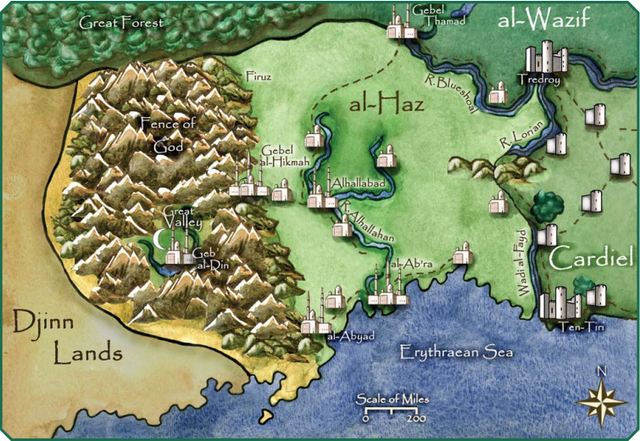
Geography
Most of al-Haz is vast savannah threaded with rivers, where Hazi peasantry grow large fields of grain and herd livestock. These great warm plains end at the Fence of God, a mountain range that is made up of fir and pine forests in the highlands and stands of cedar and olive trees in the foothills, to the west of which are arid badlands that few people inhabit. The plains are home to lions, jackals, wild cattle, antelopes, and elephants, a trio of creatures extinct on Earth in the form of the bushwolf (thylacine/Tasmanian tiger), paladin ( Doedicurus), and strider ( Phorusrhacos), and a Yrth-native tusked goat called the harding. The largest animals such as paladins and elephants are only allowed to be hunted by the Sultan himself.
History
In the time shortly after the first Banestorm, the fact that many mullahs and Islamic scholars had conveniently all been dumped in the same region meant that what would later become al-Haz was the site of the first two great Muslim cities: Gebel al-Hikmah and al-Ab'ra. These were soon followed by the holy city of Geb'al-Din in 1160, but even then the majority of Muslims in Ytarria were nomadic tribes lead by sheikhs. This changed with the invasion of the Megalan Empire and the formation of the sultanate of al-Haz in 1442, with the words of the mullahs outweighing the cries of many sheikhs that they had no desire for the shackles of empire. The primarily Sunni tribes of the north would rebel in 1444 and name one of their sheikhs as caliph of al-Wazif, followed shortly thereafter by the eastern tribes forming al-Kard in 1445. Modern al-Haz still sees its two neighbors as both betrayers of the Hazi cause and spiritually "polluted" by their non-Shi'ite ideals even after all the centuries that have passed since the Ytarrian Crusades.
Society
Social Status
The lowest rung of the Hazi ladder is reserved for beggars and slaves of peasants, followed by fishermen and porters, then peasants and urban craftsmen, then tribal sheikhs and shopkeepers, then lesser mullahs, lesser pashas, and 'amirs, then middle-ranking pashas and merchants, then cadis and greater pashas, then the Great Judge of the Ulama and the sultan's extended family, then the immediate family of the sultan and the sultan's vizier, and finally the sultan at the very top. Pashas are the governors that perform regional administrative duties and have either gained their position through heredity or recognition of their own talents, and are referred to as being a pasha of one to four horsetails depending on their importance. Non-Muslims are only tolerated if they are Christian or Jewish, and even then they are subject to the jizya (an extra form of taxation) and are heavily persecuted (or even possibly lynched, if they happen to be openly prosyletizing) if the local pasha doesn't give them his blessing. Many Christian and Jewish Arabs have left al-Haz for Cardiel, because Cardiel is the only nation that is allowed to have any wholly good traits.
Non-Humans
There's no speciesism in al-Haz as long as the other species are Muslim, but for whatever reason there aren't really many non-humans around anyway. There are some dwarves and halflings in the coastal cities and a singular reclusive tribe of reptile men on the eastern plains, but that's it.
Magic
Hazis don't like magic. It is heavily suppressed and the use of magic in the holy city is blasphemy of the highest caliber. No sultan has ever had the balls to fully ban magic outright, however, which has lead to the creation of murderous vigilante groups such as the Balikites that perform the "duty" they feel the sultan won't.
Warfare
Al-Haz has a strong army of mostly mounted warriors, but they have no one to fight. Well, they could technically fight the Hashishin stated to be in literally every city of al-Haz, the Balikites of the badlands, or pirates to the south, but they are instead kept in reserve to fight "the infidel" if yet another Crusade happens. The current sultan also doesn't trust them at all, which has lead to military downsizing and a probable need for mercenary forces to augment the main army if said Crusade ever occurred.
The Law
Pain is believed to be the outlet for
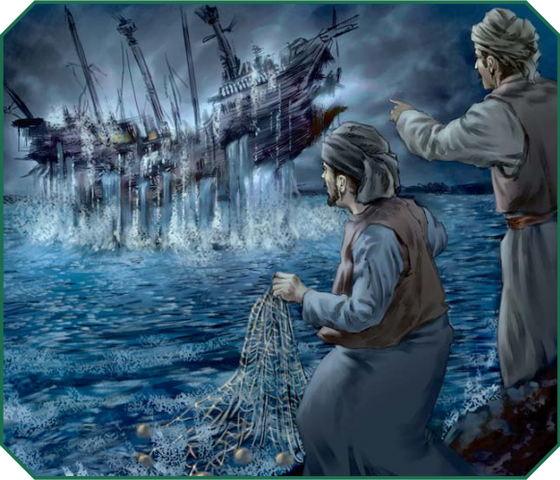
The Coast
Al-Ab'ra
The largest seaport and second-largest overall city in all of al-Haz, al-Ab'ra is found at the mouth of the meandering Alhallahan River. Ceramics, glass, salt, and textiles are exported here to the other nations of Ytarria. There is also a collection of hashish black markets in the Al-Ab'ra underworld, the sale of which is so lucrative that gang wars will sometimes spill blood into the harbors and the local pasha of four horsetails no longer moves to anything about it after repeated assassination attempts against him.
Al-Abyad
A little city in the west, where the foothills of the Fence of God slope down to meet the sea. Harding and cattle ranches, wheat farms, and shipyards that build and repair vessels using the great cedars of the hill country are the city's livelihoods. The only passage through the Fence of God to the Lands of the Djinn to the southwest is through al-Abyad, and the passage is blocked to all but a few merchants favored by Pasha of Three Horsetails Ayyub ibn-Madawi. A man named Ghalib washed up in the city half a decade ago, claiming to have come through the Maelstrom from the Lands of the Djinn. People wrote him off as some random crazy person, but he shortly disappeared after he appeared, and ever since there have been strange sightings of a ghost ship that rises out of the sea and heads west toward the Lands of the Djinn.
The Maelstrom
A giant whirlpool and never-ending hurricane that float around the ocean south of al-Haz. It's extremely hard to predict the Maelstrom's movements, as it is made up of crazy chaos magic that allows it to move in the first place and thus baffles both traditional and paranormal prediction methods. The fact that the Maelstrom doesn't push too far to the coast of al-Haz means that ships heading from any of the regions to the north can enter al-Haz but can't make it further west to the Lands of the Djinn and beyond, nor can anyone from the west can head eastward to al-Haz in that direction.
The Mountains
Gebel al-Hikmah
The capital of al-Haz, where Sultan Mamoun al-Mansur and his many viziers and concubines dwell in the luxurious palace known as the Blue Pavilion. Al-Mansur is known for his great love of polo, and frequently hosts lavish parties at matches between professional polo teams. The fact that polo team sponsorship also acts as political clout means that there's a lot of bribery, dirty deeds, and even murder behind the scenes. If you aren't Muslim or are a troublemaker, you aren't allowed into the city, and both the Sultan's guards and the 'amirs of the Ghazis of the Crescent Moon are at the gates to make that very clear.
Geb'al-Din
Geb'al-Din is the holy city that lies deep in the Fence of God. It is home to numerous mosques, including the Shrine of the Rock that houses the Ytarrian kaaba. While every Muslim in Ytarria is to enter the city in pilgrimage at least once in their life, any non-Muslim who attempts to enter the city or is even found close enough to see it is executed without trial. Unfortunately, there are infrequent outbreaks of "Pilgrim's Plague" (bubonic plague) in the city, which have never been quelled due to the fact that wizards aren't allowed into Geb'al-Din and thus can't magic away the problem. So far, outbreaks haven't occurred in tandem with a call to pilgrimage in fifteen years, but since it happened once it can surely happen again.
Firuz
While not official in any capacity, the handful of settlers who eke out an existence in the shattered badlands of the northwest call it Firuz. The land is made up of canyons, cliffs, and jagged hills that are plagued by constant drought and near-total lack of vegetation. Firuz is also where Balik Abdallah al-Firuz created the Balikite cult, which still has a powerful following in the region even after al-Firuz himself disappeared and hasn't been seen for decades. The fact that Firuz is a low mana region in an otherwise normal mana nation means that Balikites have a distinct advantage against wizards that attempt to hunt them down on top of their intimate knowledge of the region's treacherous terrain.
The Plains
Nomad Tribes
Various tribes still roam the great plains of al-Haz even after its unification, living their Berber lifestyle to this day. The tribesmen are suspicious of stangers, but are nonetheless often contacted because their horses are the fastest in all of Ytarria and only slightly less hardy than the relentless steeds of the Northmen.
Alhallabad
While Alhallabad is already prosperous thanks to fertile land on the banks of the River Alhallahan, it is even more wealthy due to being the only city in central al-Haz and thus the place where the nomad tribes come to sell their horses and trade for various goods. Of course, since this is GURPS Banestorm and political intrigue is everywhere, this wealth has been broken due to the death of Pasha Alihaba al-Khalil during the last great Pilgrim's Plague outbreak. The three sons of al-Khalil have torn central al-Haz apart. Badem ibn-Alihaba al-Asadel is the current pasha, but only thanks to the sultan giving him the title due to him being the eldest of the three sons - he's decidedly average and only succeeds in his duties thanks to his clever and wise wife. The youngest son, Denyz ibn-Alihaba al-Hassan, is clever and loyal to the people of Alhallabad, and has been defensive in his maneuverings for the governing throne. Middle son Fadil ibn-Alihaba al-Azim, however, is dumb as a sack of rocks and extremely violent, planning to siege the city with his army of bandits, thugs, rebels, and Balikites after he failed to get anywhere politically thanks to everyone in the city hating his guts.
Next Time in GURPS Banestorm: Al-Wazif, a place of political intrigue and internal strife. Who would have though, eh?
Chapter 4, Part 5: al-Wazif
Original SA post
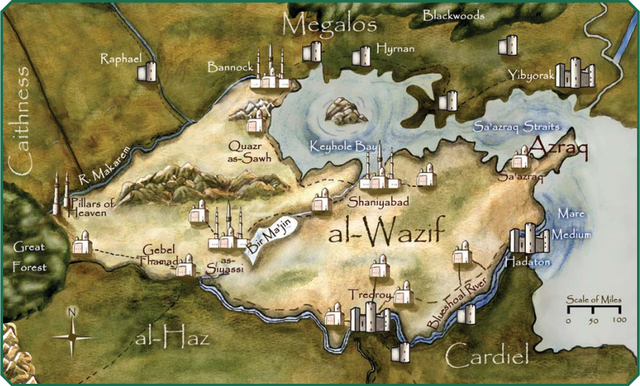
Chapter 4, Part 5: al-Wazif
Geography
Mostly plains and hill country, with very little forest and almost no non-rocky coastline. Native wildlife includes antelope species, bison, horses, striders, quail and grouse species, bushwolves, jackals, lions, and wolves.
History
Two years after the Shi'ites of the southlands created al-Haz, the Sunni tribes to their north gathered together for a grand fourteen day celebration and contest, in which the greatest men of all the tribes competed against each other to become the caliph of their own new land, al-Wazif. The Wazifis quickly became a bulwark against Megalos, forcing each of the Megalan Crusades to be brutal slogs through territories stacked to the brim with siege emplacements, wizards, and ghazis. In 1988, the death of Caliph Ishaq ash-Sharif and the rise of his son Hafsa the Scholar to the throne was seen as as a perfect opportunity by the war hawks of al-Wazif to suggest their own crusade. This war quickly became a quagmire of death and misery that neither the Megalans nor Wazifis took any grandure from, and peace was restored. The war hawks don't seem to have gotten that message, though, and continue to amass their armies for another holy war as soon as they get another chance under a new caliph.
Society
Social Status
Wazifi social statuses are basically the same as those of the Hazis, just with Turkish names for positions of power rather than Arabic ones. Christians and Jews are treated better in al-Wazif than al-Haz, getting Social Stigma (Second-Class Citizen) instead of Social Stigma (Minority), and aren't at risk of horrible lynch mobs. The ruling caliph is Hafsa at-Talib ibn-Ishaq al-Wazif, or Hafsa the Scholar for short. Hafsa would rather be doing what his nickname implies and is a strict pacifist, both of which are traits that have made some in his court consider him a weakling, but he has ruled with shrewedness and unwavering dedication. His half-brother through one of their father's concubines, Emir Harun abd Ishaq, is by contrast a warmongering brute who was the instigator of the Frontier Wars. Hasfa and Harun are now barely speaking to each other at all, Harun seeing Hafsa's brokering of peace at the end of the Frontier Wars as yet more evidence of his pathetic weakness and Hafsa seeing Harun's bloodlust as insane and self-destructive. Harun is still building yet another army for another war against the infidel, but he's at least smart enough to realize that attempting to spark a civil war would just give Megalos an easy chance to steamroll over al-Wazif.
Nonhumans
Al-Wazif was never a land where dwarves or elves held native territory, so most nonhumans in its borders are halfling or goblin immigrants. They are mostly Muslim converts, and some are even well-respected mullahs and scholars.
Magic
Even the most conservative Sunnis see magic as useful, making al-Wazif a far greater bastion of the arcane arts than al-Haz. Any wizard must serve two years in the employ of the caliph, usually as a battle mage or artifact hunter, but are generously paid for their services.
The Law
Sharia is technically the cornerstone of Wazifi law, but heavy secularization has lead to rights of intercession by governors and the caliph when they disagree with the rulings of mullahs and generally more lenient sentences than al-Haz. Al-Wazif also permits alcohol use by Christians and Jews (but not public drunkenness) and unveiled non-Muslim women.
Warfare
The grand Wazifi army is made up of mostly cavalrymen, be they tribal horse warriors lended from sheikhs or members of the ghazi orders, with a sprinkling of infantry and wizards on the side. Mercenaries are well-paid and welcomed, but only if they can give proof that they are not Megalans.
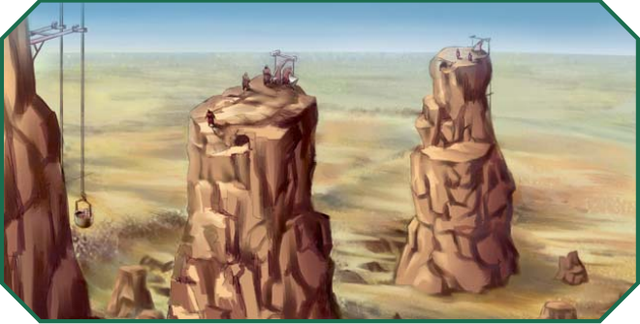
Cities of al-Wazif
As-Siyassi
The capital of al-Wazif, and also one of the oldest human cities on Yrth, having been founded in 1074. Its outskirts are verdant fields of wheat and corn and sprawling orchards producing almonds, figs, olives, and peaches, while its bustling center is filled with universities, wizard colleges, and houses of art and philosophy. The patronage of Caliph Hafsa the Scholar has allowed these facilities to reach even greater heights, a new era of intellectual discourse between all faiths and creeds flourishing after the end of the Frontier Wars. As-Siyassi also plays host to the Great Games every spring, commemorating the election of the first caliph through various competitions from freestyle poetry contests, acrobatics, and chess to jousting, wrestling, and magic duels.
The most famous competition is the Dare, wherein each competitor chooses some dangerous stunt to perform; the three examples given are riding a wild bull, axe juggling, and slaying a wolf bare-handed. Victory is determined not by actual success in the task, but by how genuinely the act is performed, and anyone who is wounded enough to require medical attention is given aid by physicians and healing wizards but is disqualified. The Dare continues from competitor to competitor until all but one has either dropped out or been too injured to compete. Foreigners and women are both allowed to participate in the Great Games, though in the case of the latter ultra-orthodox mullahs will sometimes raise a fuss. Winners of competitions get lavish prizes and honor, both of which carry great value in al-Wazif.
Shaniyabad
The largest of the handful of ports in the otherwise rocky coastline of al-Wazif, Shaniyabad benefits from sea trade, supplies coming down the river from Lake Bir Ma'jin and as-Siyassi, and the large quantities of silver, iron, and tin coming out of mines in the northwestern hills of the city outskirts. It also happens to be home of one of the requisite sources of political intrigue, its ruler Bey Hisham ash-Sharib. Hisham's whole deal is that he is self-absorbed and megalomaniacal, believing that he is destined to rule al-Wazif just because he won the Great Games when he was a young man and became relatively famous. His massive spy network is being run around the clock in an attempt to figure out how to murder both Harun and Hafsa in order to take the throne for himself, and he is stated to be actually fairly clever. Hisham's two great flaws are his overconfidence and his temper concerning the fact that he has red hair and green eyes that suggest he may have had a slave ancestor.
Sa'Azraq
Oh hey, another port city. This one is the only good harbor easy of Shaniyabad, but it's honestly not a trade hub due to offering little more than a safe port in a storm and local fishermen. It's also crimeland:
GURPS Banestorm posted:
Because of Azraq’s remoteness and proximity to Megalos, the people of its villages often fall prey to Christian slavers. Many a Muslim mother has seen daughters carried off while her husband was out fishing. Of course, at the same time, quite a few Muslim slavers use the area as a base for raids on Megalos.
Gebel Thamad
Gebel Thamad is the location of springs of water in an otherwise extremely arid region, which is what got it started up as a waystation on the way to the holy city. It eventually grew from a mere watering hole to a bustling trade stop, fueled both by carvans heading north and south and the loads of timber coming from the Great Forest. Academics have also been brought to Gebel Thamad by the strange ruins found in the Great Forest nearby, a citadel of wildly fluctuating mana levels covered with carvings in Arabic, Latin, and Norman French. While none of the academics have wrested its secrets from the ground yet, the text helpfully gives us the whole backstory on these ruins. This is Autheuil, the first human city on Yrth. It was a city created by humans from numerous nationalities and faiths, drawn together by their need to survive in the strange and dangerous wilderness that they were all dumped together in, and eventually aided by the elves. Some of the Normans eventually dabbled in dark magic and became increasingly paranoid and imperialistic, murdering Christian and Muslim dissenters alike and eventually falling prey to...something. It's unknown as to whether they were consumed by their own hubris and died in a chaotic magic accident or were slaughtered by the elves of the Great Forest.
What is known is that the remnants of whatever fate befell Autheuil has created foul mana, inducing both the aforementioned wild fluctuations between no mana and very high mana at random and a strange undercurrent that slowly induces violence and bloodlust in both animals and sapient beings alike. More than a few attempts at looting the treasures of Autheuil have ended when the party members turned against each other and slaughtered one another in cold blood. There are also rumors of even darker things down in the ruins, from undead monstrosities to ancient magical weapons of war.
Qazr as-Sawh
The walled city of Qazr as-Sawh is the stronghold of Harun abd Ishaq and the site of numerous past conflicts with Megalos, being located near the northern limits of Wazifi territory. It is also a main source of trade with Caithness.
Bannock
A city that has gone back and forth between Megalan and Wazifi rule six times in the past two centuries. The latest case of turned allegiances has been different than the others, however, as the Frontier Wars brought many of the fanatical Kharijite sect from Qazr as-Sawh to Bannock. This has lead to a schism between the previously friendly Muslim and Christian communities of the city that threatens to break the peace.
Pillars of Heaven
A ton of giant stone pillars out in the badlands near the border of Caithness, the Pillars of Heaven are second only to the holy city itself in sacredness. It is here that Sufi mystics carve hovels out of the tops of the rock, dwelling in poverty as they contemplate on the nature of God and the universe. They only come down from their peaks if there is a lack of pilgrimage and starvation is close at hand from lack of supplies. The greatest of the Sufis of the Pillars is Rhazi as-Safa, a centenarian who legends state was anything from a governing bey to a legendary Great Games victor. Regardless of his distant past, the past few decades have seen adherents of Rhazi gather his wisdom into tomes that have made their way into many halls of learning, with Caliph Hafsa himself being one of the work's greatest fans.
Next Time in GURPS Banestorm: It's finally time for
 ~Cardiel~
~Cardiel~

Chapter 4, Part 6: Cardiel
Original SA post
Chapter 4, Part 6: Cardiel
Ah yes, it is time for America  Cardiel
Cardiel  , the wondrous multicultural democratic monarchy-ruled land that stands as a beacon of light in the darkness of the millennia-of-Middles-Ages world that is Ytarria.
, the wondrous multicultural democratic monarchy-ruled land that stands as a beacon of light in the darkness of the millennia-of-Middles-Ages world that is Ytarria.
 Cardiel
Cardiel  , the wondrous multicultural democratic monarchy-ruled land that stands as a beacon of light in the darkness of the millennia-of-Middles-Ages world that is Ytarria.
, the wondrous multicultural democratic monarchy-ruled land that stands as a beacon of light in the darkness of the millennia-of-Middles-Ages world that is Ytarria.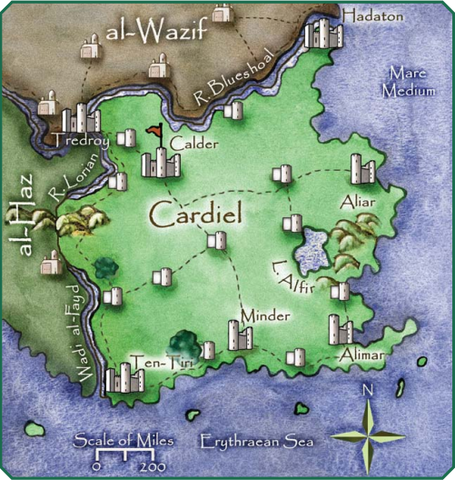
Geography
Mild climate, rolling hills, good rainfall, and only a handful of woods. Truly a fitting habitat for the glorious patriots of Cardiel.
History
Cardiel began its life as al-Kard in 1445, lead by Sultan Said ibn-Mahmud. Of course, Megalos steamrolled them as soon as they had a chance two decades later, and quickly began installing Imperial rulers, sending in waves of colonists, and eventually declaring forced conversion to Christianity at the end of the sword to any remaining Kardis. Unsurprisingly, this threat lead to mass revolts, and Cardien rulers after the first decided that it might be better to practice tolerance. Centuries of tolerant rule, intermarriage between different faiths, and jolly cooperation created a cultural melting pot that declared independence from Megalos in 1784.
Society
Cardiel is ruled by a council of lords and a prince, the latter being a first among equals (that term is used almost exactly, the exact quote from the book being "first among proud well-armed equals") rather than an absolute ruler as in traditional feudal monarchy like in the rest of the Ytarria. There is also a commoner's council, selected from knights and freemen, the members of which technically have power or holdings but nonetheless have the ear of the prince and the council of lords anyway.
Social Ranks
Mostly the same as Megalos, save that there is no emperor and the prince is on the same level as the highest nobles.
Nonhumans
While the only long-term native nonhuman communities of Cardiel are a few elven communities along the cost, its cities are just as cosmopolitan as those in Megalos, with dwarves, goblins, orcs, reptile men, and more here and there doing various things.
Magic
Cardien wizards have all the freedom of a Megalan wizard, but none of the prestige, which I guess equates to them being more or less regular citizens when you think about it. Most non-magical Cardiens tend to look upon wizards as kind of weird and potentially dangerous everyday sights.
Warfare
Most conflicts in Cardiel are on a personal level than one of a larger scale, and are usually solved through either politics or espionage. Thanks to centuries of peace, its land forces are a roughshod group of two poorly-trained legions that haven't seen a lick of combat in their lives. By contrast, Megalan raiders along the river and coast have lead to the creation of a mighty navy, which is "inferior in numbers, but superior in skill and daring" to that of its former parent nation.
The Law
In Cardiel, slavery and torture are outlawed and freedom of religion is encoded in its legal fabric. Indeed, this is one of the few areas where the book is willing to criticize Cardiel as a whole as flawed, as rather than adopt a secular legal system (beyond the above points) there is instead an "each judges their own" mentality that has Sharia, Church canonical law, Jewish law, and various other religious legal practices all side-by-side on equal footing, which leads to problems when the crime happens to be inter-religious. The death penalty has also been replaced with the equally questionable punishment of the worst criminals being sent to act as test subjects for wizards, which often leads to death anyway.
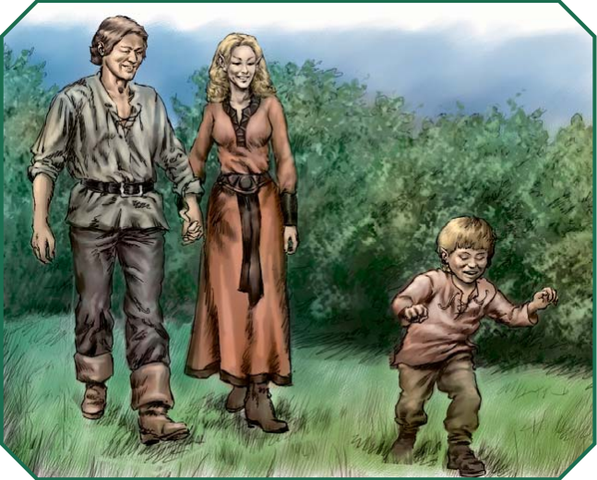
The Regions of Cardiel
Aliar
One of Cardiel's premiere port cities, Aliar is the destination for Megalan merchant vessels looking for Cardien wine and wool. Its current leader is Count Faramon, an elderly Christian Arab who is rather bitter due to losing the past two elections for prince. As he sees the 25 year old Prince Anthemius Crivelli as the roadblock to his last chance at rule, Faramon has his extensive spy network shadow the young prince at all times, hoping to find evidence of some discretion that would get him removed from office.
Alimar
Alimar is another port city that is found lodged between a peaceful bay and the only great mountain range in the country, known for its exports of grapes, oranges, and sugar cane. There's also lots of manatee farms there, in case you forgot those were a thing. Alimar and Aliar have developed somewhat of a rivalry with each other due to the past few centuries of growth of the former from a backwater town to a bustling port city after the opening of Araterre to trade. Thanks to a large collection of elf communes nearby, Alimar is one of the few places where there is a large number of half-elves. The city's baron, Saywell, is even a half-elf. Saywell is competent but unsure of himself, which Prince Crivelli has preyed upon by pretending to be a friendly shoulder to lean on in exchange for support.
Calder
Calder is known for two things: lots of cattle ranches, and lots of politics. Baron Vincent of Calder was the prince from 1976 to 1990, becoming respected for his clever rulership and overhaul of Cardiel's roads to a state that rivals even the great stone pathways of Megalos. Vincent willingly stepped down from the throne in order to help further the growth and prosperity of his home city, but has recently been worried that the signs of amorality from Prince Crivelli may require him to take up the crown again.
Hadaton
As the capital of Cardiel moves with its prince, the home city of the Crivelli family now acts as the seat of the crown as well. Unlike the rest of Cardiel, Hadaton is heavily Catholic and rather socially conservative, treating non-Christians as second class citizens. Prince Crivelli himself isn't in the ranks of these conservatives, but he is a morally challenged and power hungry schemer who cares more about himself than his country. The fact that his entire freshly-appointed position rests on people believing his facade as the latest in the long line of tolerant "people's princes" that have ruled Cardiel for centuries means that any slipup could cause Crivelli's political power base to come tumbling down.
Minder
Minder is a farm-rich city with sugar cane, wheat, cattle, citrus, and olives as its primary sources of revenue. The Shipwright's Wood, one of the few large forests of Cardiel, is also found near Minder and allows for the building and repair of ships at its port. Baron Caius is impressively healthy for being age 79 and known for his honesty, integrity, and military knowledge. Nonetheless, he has grown particularly cynical about the field of politics, and his anger at the scheming nature of the current prince continues to grow. Another famed resident of Minder is the smith of a band of centaurs that settled just outside the city's walls. This unnamed smith is not only extremely talented at his craft, he knows the ins and outs of TL4 metallurgy, leading many to wonder just what else he might happen to know about post-Medieval technology.
Ten-Tiri
A primarily Muslim seaport in southwest Cardiel, sitting at the mouth of the Wadi al Fayd. It is one of the only places where the mild plains of Cardiel fade away to hot and dry savannah. Rather than the crops of the rest of the nation, its exporst are wheat, cotton, sheep, and goats. Baron Amalric ibn-John at-Ten-Tiri is loyal to his people and concerned for their welfare, winning all but one election in his political career, but has begun to be burdened by the pressures of recent border issues. Hazi Shi'ite mullahs have been crossing the river to preach the removal of Christians from what they still perceive as Muslim lands, which has offended both the Christian and Sunni communities of the city. Amalric is receiving more and more demands for action but is genuinely unsure of what he can possibly do that won't spark an international incident.
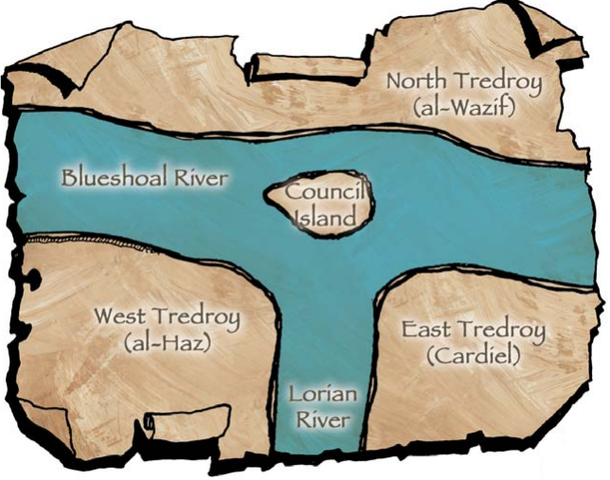
Tredroy, The City of Three Laws
Perhaps one of the biggest parts of the entry on Cardiel is on something that technically isn't Cardien – not fully, at least. Tredroy is a big deal; hell, it even had its own sixty-eight page sourcebook back in the days when Yrth was the de facto setting of GURPS 3E's Fantasy book. Of course, now that it's in an edition where GURPS Fantasy is a generic fantasy sourcebook for utility reasons, and GURPS Banestorm is the one stop shop for all things Yrth. Well, the one stop shop other than GURPS Banestorm: Abydos. Or GURPS Martial Arts: Yrth Fighting Styles. Or Pyramid Magazine issue 22: Banestorm.
Yeah, we'll choose to ignore those for right now, though I'm fairly sure I'll cover at least one of those later for very specific reasons.
History
Way back in 1180, some Christian fishermen decided to found a little village where the River Lorian and River Blueshoal forked. This village, called Paradin, quickly grew to have several hundred settlers within a mere handful of decades, and only continued to gain steam from there as both Christians and tribal Muslims came to live in what was becoming one of the region's great trade hubs. In 1496, Paradin gained the name Tredroy thanks to Cardien influence, wizards and regional governors alike coming together in 1524 to create a code of law for the unique city with the blessings of the Sultan of al-Haz, Caliph of al-Wazif, and Viceroy of Cardiel. Tredroy has withstood the chaos around it and only continued to grow more and more prosperous over the centuries. Second only to Megalos City in population, Tredroy is technically a city in three countries, portions of it belonging to al-Haz, al-Wazif, and Cardiel alike.
Layout and Architecture
As seen in the book image above, Tredroy is split up into three portions and an island. There are six bridges connecting the three parts of the city, but to get to the politically neutral Council Island you've got to charter a ferry. North Tredroy is the largest city of al-Wazif and West Tredroy the largest in al-Haz, but East Tredroy is only the third largest Cardien city, behind Hadaton and Aliar. North Tredroy is where you want to go to see the remaining structures of old Paradin, visit the academic or business districts of the city, or look into Tredroy's Jewish enclave, and is an eclectic mix of European and Islamic architecture both old and new. Heading into West Tredroy you get almost exclusively Muslim building design and population, as well as Tredroy's farms down on the south end. Finally, East Tredroy's got a lot of Imperial Megalan architecture and monuments, as well as the local Chinatown.
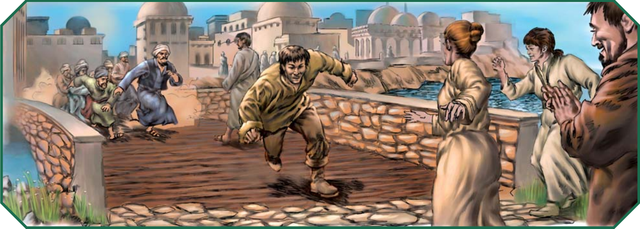
Government
Most of the business of actually dealing with the day to day running of Tredroy and implementation of taxes and social services falls to the city council, seated on Council Island, while the three governors that sit in each of the sections of the city deal specifically with criminal affairs, keeping of the peace, and military matters. In East Tredroy there is a Cardien viscount appointed by the prince, the current holder of the title being a fellow by the name of Guillaume de Laney de Lurnan. His predecessor was Allan Micardene, a former merchant who took the position of both prince and viscount from 1990 to 2004. Guillaume is on uncertain terms with the prince, as he knows in rather certain terms that the death of Allan Micardene wasn't as natural as the public assumes, and the fact that Guillaume still attempted to run for prince even knowing of Crivelli's murderous traits makes him worry he might be a potential target if he ever stops being useful.
Over in North Tredroy, the caliph's chosen emir rules. The current emir is Jannar abu Talha al-Paradin, who is still standing at age 130 because he's an extremely powerful wizard and what else do you do when you are an ancient and bored lord of the arcane arts. Magic can only sustain you for so long, however, and Emir Jannar knows he's probably in the last few decades of his life. This means his retinue of spies and aides are currently being used to find him someone who is best suited to lead North Tredroy after his death and recommend him to the caliph. West Tredroy has Pasha of Three Horsetails Khalid Abdallah ibn-ALi al-Paradin, the latest in a line of hereditary succession for its governing position. He's good at leading and very devout about his faith, but he's not actually all that shrewd, so a lot of the backdoor wheeling and dealing of politics fly right over his head. Finally, you've got the city council, thirty members strong. There are thirteen seats appointed by the city's various guilds, one appointed by each governor, four appointed by various religious authorities, and ten selected by the citizens themselves. An appointed member serves a year long term, while citizen-elected members have three years to their term.
The laws of the respective governments of the three portions of Tredroy are what hold sway in criminal and religious matters, as well as a few unique laws for each. In West Tredroy, non-Muslims must wear white armbands and receive flogging if they are caught without them, in North Tredroy there is a tariff of 10% on any goods over a talent in cost, and East Tredroy has decreed that any slave who can cross the river to its lands are free under Cardien anti-slavery laws. The image above is an example of one of these daring bridge escapes.
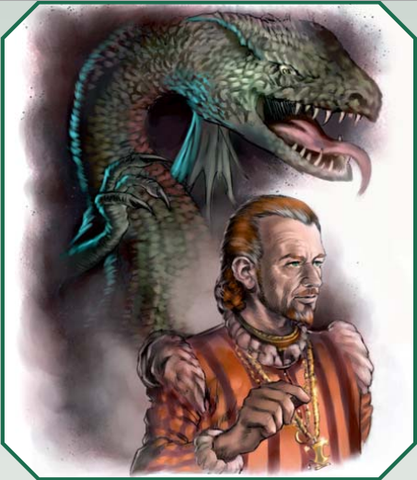
Baron Adrien Dorilis
While technically a sidebar in the Government section, it feels like I need to talk about this guy on his own terms. Adrien has been a lifelong friend of Viscount Guillaume, a trusted ally and confidant, and also secretly a monster. Oh yes. The real Adrien died of natural causes as a child; the thing parading around in his visage is actually a rather venerable (1,200 as of 2005) dragon called Dexnavi. Dexnavi appears in the ancient pre-Bane literature of the elves as a figure of wonder and terror, and while he certainly does have a massive hatred of elves and tends to like to find ways to have them turn up dead, his reason for interacting with humans is far more simplistic boredom. Human politics is a fun game to play when you've been spending centuries just sitting on your 42 foot long bulk, and the dragon's current pet project is seeing if he can manage to maneuver all of Tredroy into being its own city state before the current century's out. He's even already organized a plan for when Adrien needs to "die", preparing an actor to play the role of Adrien's long-lost, put up a big act about it, and then have the actor leave for Araterre while Dexnavi himself fakes his Adrien person's death and takes on the form of this new son.
His stat block is 750 points, which makes sense because he's a giant fuckoff dragon. On top of having immersed himself in so much transmutation magic that he got Morph as an innate non-magical advantage and having all the physical and mental benefits of being a dragon, he has a laundry list of social skills and an insane number of spells ranging from simple things like Drunkenness and Warmth to a murder gauntlet of things such as Burning Death, Deathtouch, and Rain of Fire. Even his human form is a special "enhanced human" template that grants him almost the same level of physical attribute scores as his true form (though he didn't spend the points to be able to keep his breath weapon when going human, which is the one dragon feature I'd imagine wouldn't be an obvious tip-off due to physical abnormalities like wings and claws; oh well, his loss), meaning that anyone attempting to assassinate "Adrien Dorilis" will inevitably be surprised when he pulls out a Strength score of 22. While definitely intended to be the sort of big boss at the end of a campaign very much on the high fantasy end of Yrth's power scale, Dexnavi can be beaten – pride goeth before the fall, after all, and it's right there in his list of disadvantages.
The Guilds
Unsurprisingly given their ability to pick almost half of the city council's seats, the various guilds of Tredroy have a lot of power and influence. Any type of business related to a guild is under complete and utter monopoly. The largest guilds in the city are the merchants' guild and mercenaries' guild, both thousands of members strong. While not as large, the mage's guild of Tredroy is also extremely powerful, requiring everyone living in the city with even a modicum of spellcasting capability to be on their registry. On the down low, there is also a thieves' guild in Tredroy, as well as an infamous assassin's guild simply known as the Assassins. Not to be confused with the Hashishin, the Assassins typically works for the highest bidder rather than for an agenda like their Arabic counterpart.
People of Tredroy
Tredroy is an eclectic mix of Muslims, Christians, Jews (15% of the population, in fact, making Tredroy home to the largest Jewish community in Ytarria), Hindus, Confucians, Taoists, and pagans. On the species side, 90% of Tredroy is human, the rest being an unknown mixture of goblins and their kobold relatives, halflings, orcs, and reptile men. Out of the two most well known of the Elder Races, dwarves sometimes come to the city to trade but find Tredroy residents somewhat obnoxious due to their curiousity about a species rarely seen so far south, and elves avoid Tredroy like the plague due to the fact that they tend to end up dead in the river when they do show up.
Places of Interest
There are at least a few interesting locations in each of the three portions of Tredroy, as well as the obviously interesting place that is Council Island. The island plays host to the three story city hall and numerous offices of business and trade that are bustling with nearly eight hundred workers all day long. Up in North Tredroy, you have the Grand Bazaar, a hundred acre marketplace with a myriad of goods from numerous vendors. It is also the home of the Tredroy Mage's Guildhall, a manor house whose inner quarters are barred from entry by non-spellcasters by having all its doors sealed with the Magelock spell. West Tredroy has the Grand Mosque of Tredroy, with worship quarters capable of holding four thousand people, the office of the chief mullah of Tredroy, the largest Shari'a court in al-Haz, and an Islamic scholar's school. Finally, over in East Tredroy there is the great iron and stone edifice of the Cathedral of the Holy Trinity and the Street of Artificers in Chinatown. The former is the office of Tredroy's archbishop, while the latter is a place where those capable of creating clockwork devices and complex toys show off their wares.
Next Time in GURPS Banestorm: What's that? There's places in Ytarria that aren't the Abrahamic lands? Crazy! In the next post, we cover the first half of these with Sahud, Zarak, and the Orclands.
Break Time 1: Amelia Earhart and Flying Orcs
Original SA post
Break Time 1: Amelia Earhart and Flying Orcs
You might recall that in the last update, I noted that I might look at at least one of the supplementary materials to GURPS Banestorm. I decided that before we head to the next set of nations, I'd give everyone a little break from nations and indeed hammer out a brief post about that supplement: "Whatever Happened To...?", a Pyramid magazine article by Andy Vetromile. Its entire premise is taking some people who famous disappeared without a trace and giving the explanation of "a Banestorm did it". Each entry is broken up into sections on playing around with these characters when they are still alive or after they have died off but left a legacy, and since there's no actual dates on the Banestorm timeline I'm going to be assuming that the legacy sections are the "here and now" of 2010 (not 2005, since the Pyramid issue was written five years after GURPS Banestorm, and the setting totally coincidentally happens to stick closely to its sources' publication dates) for the sake of simplicity.
Amelia Earhart and Fred Noonan
On July 2, 1937, famed pilot Amelia Earhart and her navigator Fred Noonan were caught in a small freak Banestorm that ripped their plane to shreds and threw them straight into the great mountains of Zarak. Miraculously, not only did they survive, but much of the meat of their plane did as well, the sight of which awed the tribal people dwelling in the mountain tarn they landed on. The hill folk were a collection of downtrodden exiles from human, dwarf, elf, and orc cultures, but under Earhart and Noonan they forged an actual identity as "the people of the Air Hart". The pilot taught the tribe how to create ziplines and primitive glider planes to master the rocky crags and vast chasms of their land. Even after her passing, the Air Hart tribe continue to build their gliders and consider themselves now a proud people separate from those nations that abandoned them to the wilderness, though they haven't become strong enough to not fear the potential reprisal were the wizards' councils of the lower nations to come in hopes of destroying their fantastical flying machines. Air Harts are willing to trade with anyone who actually manages to believe the legends of sky people in far Zarak, reach their inhospitable territory alive, and show them respect.
The Escapees From Alcatraz
One of the most infamous prison breaks of all time, Frank Morris and the brothers Clarence and John Anglin managed to break out of Alcatraz on June 11, 1962. Unfortunately, even San Francisco Bay can be struck by a Banestorm, and their escape from the Rock ended up leading to an entirely new incarceration. ...Or that's what I would say, at least, if it wasn't for the fact that Morris quickly grew to love Ytarria and its Medieval ways. He quickly rose to prominence as a renowned genius troubleshooter for everyone from orc tribes and thieves' guilds to nobles willing to get their hands a little dirty in the process. The Anglin brothers, by contrast, became merely Frank Morris's flunkies, "muscle" he could flex around when things got rough. A rift between the three eventually grew wider and wider until the Anglin brothers struck out on their own as petty bandits, eventually dying in a fight with some orc bandits. The fate of Morris himself after a sudden disappearance on his part is a far greater mystery. Rotting in some jail he himself helped make escape-proof during his time as a troubleshooter? Living in some secret hideout somewhere in the boonies? Six feet under? Nobody knows. Similarly, rumors fly that Morris had either a son or a daughter that he taught all his tactical secrets to, and every once and a while there will be a noble who claims to be from the line of Morris in an attempt to gain recognition.
The Princes in the Tower
Richard of Shrewsbury and Edward V of England were two brothers sent to the infamous Tower of London by their scheming uncle Richard III in the year 1483, never to be seen again by Earthly eyes. Turns out the reason why is that they were whisked away by a Banestorm to some small village in rural Ytarria. Their lasting legacy is the creation of the Great Hall, an orphanage and halfway house for those who have been left confused and alone by the Banestorms. Adherents of the princes of the Tower have spread and created more Great Halls in the centuries afterward, to the delight of peasantry and the disdain of Church members that found competition with these new havens as favored positions of refuge.
Judge Crater
An associate justice of the New York Supreme Court, Joseph Crater mysteriously disappeared on the night of August 6, 1930, after having dinner with a lawyer and his mistress, Sally Lou "Ritzi" Ritz. Literally walking into a Banestorm in the middle of New York City is probably the strangest case yet, and even stranger was the fact that he managed to be dumped in the middle of two tribal groups that needed an impartial arbitrator to stop a conflict they were having over marriage and property rights. Eventually, word of Carter's diplomatic skills spread from the tribe to merchants, and from the merchants to the cities and their lords. The New York City judge eventually became a well-respected legal counsel second only to the arbiters of Tredroy. His personal practice eventually took on proteges that have kept up a line of Carterian legal experts to the present, and while sometimes controversial due to its differences to the Medieval laws of Ytarria as a whole, most lawyers, judges, and legal scholars nonetheless respect the opinions Carter espoused.
Break Time Thoughts
This is exactly the kind of glorious/dumb shit Pathfinder should have more of. Some of the examples given aren't the most amazing, but the idea of having random famous disappearances be actually the result of the Banestorm makes perfect sense in universe and allows for playing around. Honestly, the author probably should have taken it further. Roanoke? Banestorm. Jimmy Hoffa? Banestorm. D.B. Cooper? Banestorm. Go whole hog, and also give them all effects as crazy as the Earhart entry.
Chapter 4, Part 7: Sahud; Chapter 4, Part 8: Zarak
Original SA post
Welcome back to the standard GURPS Banestorm power hour. As I said last time, my original plan had been to go through three nations in this post and then the other three in the next, but I decided after the spectacular post failure of last time to instead do three posts with two nations each instead.
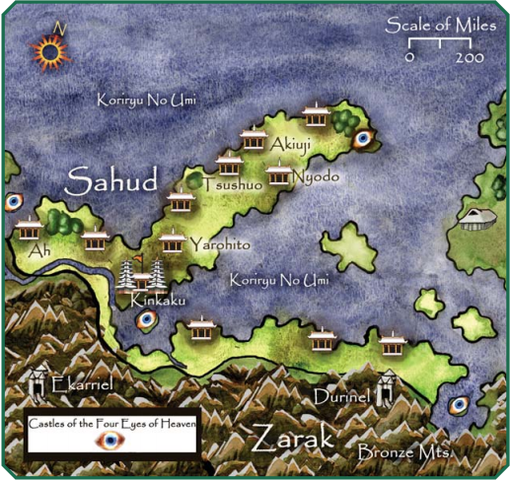
Chapter 4, Part 7: Sahud
Geography
Located far away in the mysterious
History
The people of Sahud were plucked by Banestorms on both sides of the world, taking individuals from China, Korea, Mongolia, Japan, Siberia, various southeast Asian countries, and pre-Columbian North America. For the first few centuries, all of these groups were nomadic tribes, though eventually they began to settle down and form governments. One guy eventually declared himself Heavenking, the divine ruler of all of Sahud, and for whatever reason everyone seemed to believe that made sense and fell in line under him. Sahud has had no major changes in government or altercations with other nations since, as its leadership is hyperconservative and obsessed with keeping stability over everything else. Sahudese noble in the Court of Heaven consider Zarak an old friend and treasured neighbor, the Nomad Lands and Orclands annoying barbarian neighbors, Megalos a good trading partner, Araterre a potential source of greater ship-building knowledge, and everyone else a bunch of irrelevant foreigners.
Society
GURPS Banestorm posted:
Sahudese society has many rules, most of which can vary by location and the time of day or year. Visitors will no doubt find them bewildering, but may learn a few of the basics. The rules are strictest among the highest classes; non-Sahudese will find peasants relatively easy to interact with, if still sometimes baffling. It is possible for an intelligent foreigner to eventually understand the patterns of Sahudese society. However, it is hard to find a teacher in the first place. In Sahud, people are taught the rules while they are children, and making mistakes as an adult can cause loss of face. Thus, teaching the rules to an adult visitor is the same as treating him as a child.
Status
Sahudese social status is heavily stratigrified, imposed upon birth, and effectively dictates both your class and your profession from the day you're born to the day you die. On the very lowest rung are outcasts, beggars, and thieves, followed by servants, geisha, courtesans, and wanderers, then artisans, ninja, peasants, and weak wizards, then wealthy farmers, ronin, monks, craftsmen, and merchants, then samurai, abbots, and average strength wizards, then minor clan heads and minor high priests, then major clan heads, high priests, and powerful wizards, then imperial nobles and high ministers, then the Eyes of Heaven, and finally the Heavenking. Conforming to society is the best way to keep face, though there are "acceptable deviants" that are considered to be able to break rules but keep face due to how beneficial they are, such as women who are skilled enough and driven enough to break through the society's glass ceiling and become samurai.
Social Interaction
When two Sahudese meet, their interaction is all about their social status. You are expected to be polite to your superiors, while you can be a total asshole to your inferiors. It is, however, considered crass to actively note someone's flaws, and it is instead most honorable and effective to be backhanded and catty. One major faux pas for anyone of higher class is to do something kind for an inferior with the expectation of getting something in return, as this is considered sinking to their level rather than having them kiss your ass without coercion as they naturally should.
Nonhumans
Dwarves and the Sahudese have gotten along since they first met, and not just because they're neighbors. Their mutual "you like honor, I like honor, you like metalcraft, I like metalcraft, let's be friends" attitude has given them a lot of common ground and a codified system of trade and social interaction with each other. A handful of other species, from goblins and elves to orcs and halflings, also dwell within Sahud and are treated equitably as long as they have effectively shed their old culture and become truly Sahudese.
Religious Practices
For reasons nobody really knows, Sahud has spirits all over the place when they are absent in the rest of Ytarria. Everything from the largest river to the smallest stone has some spirit tied to it, and they are all seen as gods in the eyes of the Sahudese. Sahudese priests are more like paranormal lawyers than societal arbiters and spend most of their time bargaining with the spirits to make sure that the people of Sahud are still in their favor. Unsurprisingly, people the Abrahamic faiths think that Sahudese are weird and nonsensical pagan-likes at best and Satan worshipers at worst.
Magic
Sahudese mages are often powerful, but magic that has a lot of visible effects is considered dishonorable and socially inappropriate in all but base warfare, mage duels, or when used against criminals.
Warfare
As there are no forces that would wage a land war against it, Sahud has no army. Its nobles, however, frequently fight amongst each other in bitter and bloody warfare of two different types. One type, "high war", is a rigidly structured battle with a strict set of rules agreed upon by the two nobles that began the conflict. This is effectively war for face and face alone and doesn't actually threaten loss of land or life. "Low war", by contrast, is straight up ruthless conflict. Wizards, mercenaries, assassination, and pretty much anything else is allowed, and one side is almost always slaughtered by the other. Low war is only invoked for the most extreme of insults or during periods of economic suffering. While not warfare proper, it is also noted here that judo and karate is known by every noble and many commoners to at least some extent.
The Law
Acts of violence outside of war, theft, offending the spirits, offending the Heavenking, and cheating during a high war are all crimes in Sahudese society. Like everything else in Sahud, trials for legal action are all about face and political maneuvering, which means that commoners and foreigners are almost always at a disadvantage. Flogging and fines are the most common punishments, with death by lashing being the capital punishment.
The Clanholds of Sahud
Ah
Clan Ah is lead by Naga-Go, an ancient dragon who eventually got tired of samurai trying to slay him and decided to integrate himself into Sahudese culture. As it is believed doing so is either insulting him or showing weakness through fear, other nobles don't let on that Dragon Head Naga-Go is literally a dragon, so many outsiders are shocked when they learn of the truth. As a merchant clan, Ah specializes in selling livestock and spices. Clan Ah is known to frequently hire ninjas to engage in character assassinations more often than literal ones, humiliating other nobles to break their face through tripwires, buckets of mud placed surreptitiously above doorways, faking assassinations with wooden weapons, or even using poisons that induce horrible stenches or vomiting rather than death.
Nyodo
The aggressive Clan Nyodo has a long history of bitter conflict and acts of aggression against its neighbors. The current Clan Head, Akiyasu, is attempting to move things further toward the politically manipulative standard of the rest of Sahud, but he is unsure of what to do with the clan's standing army if he does so, as unemployed soldiers are frequently troublemakers. His current plan is to just send them out into the Nomad Lands to fight the barbarians and hope they end up dying horrible deaths, saving him the trouble of having to figure out anything more complicated.
Tsushuo
After being nearly destroyed by the Nyodo during one of the latter's numerous low wars, the survivors of Clan Tsushuo left in exile to the lands of a clan known as the Akiuji in 1985. They returned in 1999, but the utter lack of face from nearly being murdered meant that the only person who could actually rule over the new Tsushuo was a young woman named Hanatatsu. While the elders of the Tsushuo have either faked their deaths or pretend to be gravely ill in order to hide from the public and avoid even more loss of fave, the 22 year old Hanatatsu is being pressured to find a husband and pop out an heir of the nearly dead clan's line.
Yarohito
The great silkworm farms of Clan Yarohito have made it exceedingly wealthy and in frequent contact with Megalos for trade. Clan Head Najimatsu is a mighty wizard and clever ruler who is merciless in his intolerance for the failings of others and dealing with those who attempt to force him to lose face. He is, however, a good Anglish speaker and actually engages foreigners on practical terms, which makes him the most likely ally for anyone from the Abrahamic lands heading into Sahud.
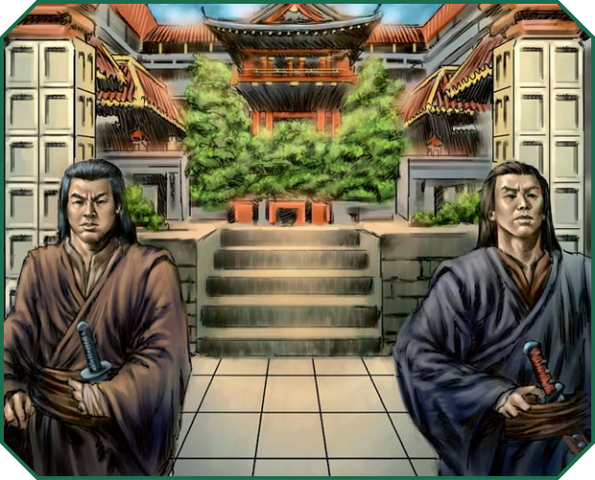
Kinkaku and Uulinn
The capital of Kinkaku is one of the largest cities in Ytarria, rivaling Megalos and Tredroy. Sadahiro first declared himself Heavenking in the 1530s, raising a palace above a high mana hotspot on an nearby hill that came to be known as Uulinn, the palace-town of the Court of Heaven. It spreads along both banks of the River Ayakura near the base of the Sahudese peninsula, most of its buildings dating back to 1869 due to a great fire that ravaged much of the original city. Buildings with rice paper walls, rounded doorways, and flared pagoda-style roofs line twisted and crowded streets. Rising above it all are the massive stone walls of Uulinn, which almost none outside are allowed to pass through. Its innards house the Court of Heaven and the Heavenking himself.
Government
As foreigners are not allowed to enter Uulinn, some Megalans have taken to wondering if the Heavenking isn't just a figurehead effectively imprisoned by his own court. While saying such a thing aloud is a highly illegal and criminal offense, it's also actually the turth, as the Heavenking is unable to leave the grounds of Uulinn and the clan heads engage in most of the actual governance. The Heavenking can write any law he wishes, but their words never leave the palace unless the nobles of the clans agree upon the law and enact it. A law that has only one or two supporters is treated as a falsehood by a traitor who presumes to speak for the Heavenking, while one that has all but a few supporters is treated as the words of the divine mandate, and those who didn't agree with the law initially lose face. Three Heavenkings in Sahud's history have actually been women, but this fact is heavily censored, and it is another great social offense to use anything but male pronouns for any Heavenking even if one does happen to know the truth about these past rulers. The current Heavenking is a 56 year old man who is somewhat competent in figuring out laws for his own country and gathering favors that grant him greater power, but has gained such a dissociation from the outside world due to his life cloistered within Uulinn that he often wonders if the nations outside of Sahud are even real at all.
The Four Eyes of Heaven
The Four Eyes of Heaven are four powerful wizards who that are the direct attendants of the Heavenking and his ties to events outside of Uulinn, as well as both attendants and enforcers of the law. The youngest of the four current Eyes is Vision of Budding Flowers, a 33 year old woman whose raw magical power was strong enough that she easily netted her position. She is beloved by the commonfolk, strong but fair in her administration, and a master of Air, Communication, and Empathy college spells. Perception of Bountiful Growth is 60 years old and gained his position through the poisoning of his predecessor in a way that didn't kill him but made him lose a lot of face through his public vomiting. He is an aggressive political wheeler and dealer even by Sahudese standards and has begun to gain a twisted nationalism that brings a desire for conquest in the name of "civilizing" other nations. He has even begun plotting with King Durinann II of Zarak to consolidate the noble armies of Sahud into one national force and descend upon Caithness during its time of strife and civil war. Earth, Food, Illusion, and Creation spells are his specialty.
Glimpse of Falling Leaves is a 54 year old woman who appears to be merely 25, thanks to her masterful manipulation of her own body through magic. She is also cartoonishly evil, as she is noted to be a sadist who got into her position by murdering her predecessor and is plotting to become the next Heavenking by force. She has mastered the Body Control, Fire, Healing, and Necromancy spell colleges. Lastly, there is the 90 year old Sight of Bone-White Snow, a frail old man who lives in a tower deep in the pine forests of far north Sahud. He is a cold pragmatist whose main goals are the preservation of the Sahudese way of life and the consolidation of his position until the cold hand of death finally takes it from him. His spell talents lie in the Movement, Protection and Warding, and Water colleges.
The Trading Clans
Clans that are heavily engaged in trade with other nations, such as Clan Ah and Clan Yarohito, have their own mansions and negotiation buildings in Kinkaku for the benefit of foreign travelers. Of course, the clan representatives working these compounds often have their own agendas in mind as well, and more often than not a seemingly generous extension of hospitality to a foreigner is actually intended to find out as much as possible about their own trading operations.
People of Sahud
75% of the people of Kinkaku are some flavor of Asian, 10% of other human races, 10% halflings, and 5% a smattering of other species. A vast majority of the residents are Sahudese citizens, with a small Foreign Quarter being erected for foreign merchants and other non-Sahudese that have a permanent or semi-permanent presence in the city. Most of these merchants are Megalans, though there are also a decent number of Caithnessers and Zarakun as well.
Places of Interest
Perhaps fittingly, the Foreign Quarter is the first noteworthy place in Kinkaku that gets mentioned right after the population demographics. It is created in a mostly Megalan style, though there are also a few dwarven fort-houses as well. While there is no centralized bazaar, there are also numerous specialist shops lining the city's labyrinthine streets that can be combed to find numerous goods. On the academic side, there is the Noble and Beneficial Academy of Sahud, a school of learning for anyone from age 4 to 21 that has steep tuition fees, a 50% drop out rate for non-Sahudese students, and a curriculum that spreads over everything from social etiquette and Sahudese history to the martial arts. And, of course, there's obvious Uulinn itself. Only the Eyes of Heaven, clan heads, and the Imperial Guard are allowed to freely come and go. Anyone else is either killed on sight or captured and tortured out of the assumption that they must be a spy or assassin. Permanent residents are the Heavenking and his family and numerous families of servants, and the grounds outside of the mansions and servant quarters include a zoo, lavish gardens, hot springs, treasures, and magical laboratories.
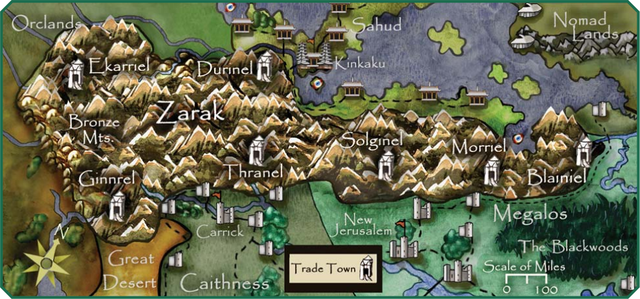
Chapter 4, Part 8: Zarak
Zarak: the word of the dwarves for both their kingdom and the great mountains above it, which they treat as one and the same. Their land is the most powerful nonhuman holding in all of Ytarria, a fact that the Zarakun take as a sign of pride.
Geography
While the dwarves consider all of the Bronze Mountains to be Zarak, some portions end up being officially under the ownership of other nations nonetheless. Most of the surface is jagged peaks and windblown passes that are dotted with warm and fertile valleys in between. Beneath the surface, however, the dwarves have created cities capable of holding thousands and numerous tunnels that can extend nearly half a mile into the earth, extending into various mines and mushroom farms. Massive hundred foot tall gates mark a few surface passages that the dwarves are willing to let other species know about (though there are numerous ones that are kept secret), outside of which are specially crafted trading towns that play host to any inter-species activity.
History
As one of the Elder Races, the dwarves and their kingdom have a history stretching back into the time before the Bane of the dark elves even took place. In millennia past, they kept to themselves, perfecting their wares and enslaving any unfortunate orc or elf that decided to enter their subterranean lands. Even the great war between the elves and the dwarves of 405 AD didn't truly shake them from their isolation. The only thing that truly changed their way of life was the Bane itself, which disintegrated hundreds of miles of the Bronze Mountains that had extended into what is now the Great Desert. The king of the day sent out spies to see why word from the southwestern parts of Zarak had dried up entirely, and reports back of strange monsters and remnants of elven magic heightened and already strong xenophobia. Even in the present day, dwarves consider the Great Desert a cursed and spiritually polluted land that they refuse to set foot in.
The first human encounter with the Zarakun took place in 1235, when a Megalan scouting party ended up stumbling into dwarven outposts on the surface. Most were massacred, but eventually bloodshed turned to curiousity, and the Megalans offered a trade agreement with the Zarakun to end the violence between their nations. Since then, the dwarves have extended more and more trade routes to various human nations, but few ever leave their mountain halls, and even fewer humans have ever been allowed past the great gates. Most other species still see the Zarakun as a great enigma that may never be fully understood.
Society
Dwarves are all about tradition. Only when a tradition is thoroughly proven actively detrimental and harmful is it ever abandoned, and even then only tentatively. To the average dwarf, what worked for the ancestors should work just as well for future generations, and there's no reason to change what works.
Social Status
The Zarakun are lead by the seven kings under the mountain, one of whom is elected the High King of Dwarves. All dwarves acknowledge the authority of the High King, even those far away from Zarak itself. Below the kings and their clanfolk are the high crafters, the most skilled and respected craftsmen of the dwarves, who hold some of the greatest political power in all of Zarak. Below them are local governors, and below them the traders and soldiers, and just below them the merchants. A dwarven saying emphasizing the importance of the last three groups is "if you can't be skilled, be strong, and if you can't be strong, be rich". Normal dwarves that live underground are considered slightly more socially important than those that have chosen to live on the surface world, which are treated as being basically on the same social level as humans for their strange choice to leave the underground. Finally, at the very bottom are criminals, exiled dwarves, and slaves.
The place of women in dwarven society is somewhat complicated. Below the surface world, dwarven women can hold a lot of power, as they are freely accepted as crafters or bankers. A fifth of the high merchants and all of the heads of the banks of Zarak are women, as well as many individuals working on the subterranean side of the trade business. There is sexual discrimination in that women are not allowed to be traders on the surface or members of the army, however, out of a belief that the protection of the species' reproductive success is too important to allow the dangers of the surface to threaten them.
Non-Dwarves
A handful of humans and gnomes are allowed to live in the valleys of the Bronze Mountains, usually specifically to be farmers that help increase the foodstock of the cities and towns below ground. Only twenty living non-dwarves who have been accepted into Zarakun society enough to be allowed to live underground – seventeen humans, two halflings, and a goblin. Beyond that, the only non-dwarven individuals in the subterranean lands are slaves. Slaves in Zarak suffer greatly, as they are seen as a tool rather than a living being and are only used for jobs that are seen as too uncreative for dwarves to perform. When they have outlived their usefulness and are no longer capable of performing manual labor, they are discarded, either through death or being left to fend for themselves in the wilderness of the mountains on the surface.
Magic
Dwarves excel in Earth and Fire magic, especially where it intersects with the creation of objects. Enchanted items are far and away the primary use of magic throughout Zarak. While there are some dwarven battle mages, there is a long-running disagreement between dwarf leaders over whether or not they should be just an average part of the Zarakun Army or made into their own corps.
The Law
Dwarven law heavily focuses on property rights and deference of younger individuals to their elders. Most crimes such as property destruction are punished be community service or fines, but violent crime is punished by having hte offender locked up in an unlit cavern for a month with only a limited supply of food. The most extreme offenders of dwarven law suffer the ultimate punishment through exile to the surface with the threat of death if they return.
Warfare
While its name implies a grandiose standing army the Zarakun Army is actually mostly just various units that do guard detail at every entrance to the underground. These units are trained in the use of axes, crossbows, and mauls, and are mainly there to beat up thieves and spies who are subsequently enslaved if they survive. The rare cases of actual invasion are met with all able-bodied dwarves down in the caverns taking up arms and defending their homes.
Technology
Dwarves are fascinated by the strange marvels spoken of by humans that come through the Banestorm, and newcomers are frequently interrogated if they can be found quick enough. Zarakun engineers even have steam engines and gunpowder explosives, though this is kept a strict secret due to the fact that the seven kings are well aware that Megalos finding out would mean both the end of trade and the Legion knocking down their doors.
The Seven Brother Kings
The leaders of the dwarves are known as the seven brother kings, though they aren't actually related at all and it's just meant to be symbolic. Each one is the leader of a specific clan with people who take on their leader's name (E.G., the dwarves in the clanhold of King Morkagast are known as "Morkagast's Folk"), and one king out of the seven gets chosen to be the High King, which means he has a bit more prestige and power. Each clanhold is autonomous but tied through dwarven brotherhood.
King Ekarron III
Ruling from the ancient clanhold of Ekarriel, Ekarron III is a relatively young dwarf at the age of 115. While known for his kindness, talent as a jeweler, and for being beloved by most other dwarves, Ekarron's current most defining trait is being scared shitless by Megalos. This fear has shaped his current policies such as cries for support of an organized battle mage corps and increased trade with other Ytarrian nations. Unlike many dwarves, Ekarron's Folk are talented woodworkers, cutting down trees from the forests at the edge of the Orclands and ferrying them underground to be carved into various tools and artwork.
King Blainthir VII
Blainthir VII is lovable and charismatic but dumb as a fencepost, which is why he prefers to have his administrators do the thinking for him; his current policies are a hatred of technology and elves and proud support of Megalos, but that will only last as long as the governors at his side hold those opinions. Many of Blainthir's Folk have become wary of the nearby fortress of Glimpse of Falling Leaves, believing that either she or some monstrous wizard-beast from her island has been behind the increasing amount of disappearing dwarven patrols outside of their clanhold.
King Durinann II
A once vibrant king who has become lazy and complacent in his old age. As his mines run dry and people begin to become uneasy, he has attempted to patch up the situation by becomking cozy with Perception of Bountiful Growth and Sahud by proxy. Most dwarves in Sahud are Durinann's Folk.
King Ginnargrim III
Ginnargrim has the misfortune of being the dwarf that leads the clanhold on the border of the Great Desert. While he is a talented wizard, craftsman, and administrator, Ginnargrim's youth and stuttering speech impediment have made many dwarves think he is less competent than he actually is, and many are longing for when one of his two sons is old enough to become king. Grinnargrim's Folk export silver and gray granite with red veins, but also imports a large amount of food thanks to its poor surface fertility. There is also an increasing number of attacks in its westernmost reaches by giant insects that seem to be strangely intelligent.
King Morkagast
Morkagast, son of Morthrinn, is a 173 year old dwarf who took the position of king just a decade ago after his father finally succumbed to a long-running illness. Rather paradoxically, he is simultaneously both the biggest supporter of technological advancement and a major supporter of Megalos. The clanhold of Morriel, the home of Morkagast's Folk, is a major exporter of copper and has one of the highest population of wizards in Zarak.
King Solginyarl
Solginyarl is an extremely conservative dwarf that hates Morkagast for his embracing of progressive technological movement, is extremely xenophobic, and disregards the ideas of creating a battle mage corps simply because that's never how things have been done. While the clanhold of Solginel stretches to border Caithness, Megalos, and Sahud alike, very little trade is performed due to Solginyarl being a big old racist. When there is trade done, it's usually iron, marble, and steel exiting and Megalan slaves entering.
King Thransiravst
Thransiravst is the leader of a productive clanhold whose people are well-fed, happy, and productive. He is one of the few pro-elven kings, as well as a fan of humans, but otherwise doesn't really hold any strong political opinions. The many exports of the clanhold of Thranel include green granite, gold, diamonds, and silver fox furs.
Next Time in GURPS Banestorm: It's time to loose the barbarians, as we're heading to the Orclands and the Nomad Lands.
Chapter 4, Part 9: The Orclands
Original SA post
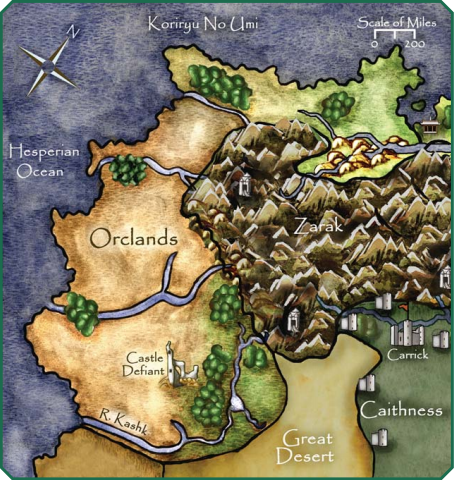
Chapter 4, Part 9: The Orclands
Geography
The Orclands are mostly steppes and desert, with some scattered forests thrown in. It's a land of antelope, bison, wolves, and yaks, little rain, and not much to really speak of. It is more or less intended to be the Wild West of Ytarria, and most individuals of all species scrape by with Iron Age technology at best.
History
Before the dark elves' Bane, the Orclands were basically a place where some orcs and gnomes hung out doing tribal shit and nobody else really cared. Then, with the first Banestorm, the region was sprinkled with nomadic tribes of centaurs, giants, minotaurs, and humans. Oh, the humans... Remember how
GURPS Banestorm posted:
Over the next few centuries, people of Mongolian and American Indian descent began filtering into the Orclands from the northeast as Sahud became more civilized. These nomads quickly came to dominate the region, following the bison and antelope on their seasonal migrations.

The Orclands didn't actually become the Orclands until the late 1700s and early 1800s, when Megalans pushed huge groups of them out of what would become Caithness. These orcs pushed other species to the northern extent of the Orclands before things generally settled down up until 1985. This was the time when Castle Defiant, a citadel of Caithnessers in the southeastern Orclands, was overrun by orcs. Not just any orcs, though – these were orcs lead by outcast dwarves, because orcs on their own were not smart enough to ever assail such a fortress. The dwarven rogue Bulgaren and his band of angry orcs now hold court in the castle and use it as a place to raid more human villages and get more loot.
The Orc Tribes
There are twelve major orc tribes and many smaller ones, ranging in size from dozens to hundreds of members. Some of the example named tribes include the Blackskulls, Bloody Fangs, Carrion Eaters, Death Birds, and Poisoned Talons, with others being similarly "violent or grotesque". These tribes spend most of their time herding yaks or hunting bison, any time in between being spent either fighting someone or planning fights with someone.
Betrayal and Honor
Orcs "breed like locusts", scattering across the plains, and are just too damn stupid to understand what things like loyalty and trust are without learning it from some other species. Without this knowledge, orc tribes instead ultimately use how much you've destroyed as a measure of prestige and honor. Taking a life is more valuable than destroying an object, for instance, and an orc that razes a whole town and massacres its citizens is going to be fair more prestigious than someone who kicked apart some wanderer's donkey cart. Tribes rarely get larger than in the hundreds because eventually someone starts backstabbing someone else for orcish honor once a threshold is broken.
Daily Life
Due to the lifestyle of "destruction = honor", orcs rarely have more possession than some basic supplies, a yurt, their weaponry, and some stock in the communical livestock herd. Orcs are strangely progressive on gender, unlike many orcs in fantasy, as they see destruction as destruction regardless of who's doing it. Orc women even go into battle while pregnant and when raising their young.
Magic
Orcs don't typically pay attention to the signs of untapped magic potential, but those that learn it typically become strong members of their tribes with Making and Breaking college spells and various combat magic.
Warfare
Orcs love war. If they aren't fighting someone else, they're fighting amongst each other, and a tribe that is an ally one day may be an enemy the next. Chieftains are known for being literally unable to have extended alliances without a common enemy to prevent infighting. While orcs respect the warriors of other cultures, they nonetheless will try to destroy them if they feel threatened or wish to display more tribal honor.
Government
Tribes are ruled by a chieftain, who is basically the most violent orc around who carved a path of blood to the top. Their underlings follow their orders out of an acknowledged respect for their brutality and power rather than out of fear or abuse, though they are expected to be treated as expendable property anyway, lest the leader is seen as soft. Some humans, dwarves, and undead have been able to work with this power structure and take over orc tribes.
Crafters
While the act of creation rather than destruction is seen as dishonorable, orcs nonetheless realize that an army without weapons and armor isn't much of an army at all. Thus the rare orcish craftsman is given some leeway in the normal power dichotomy and allowed to make rather than break, though their work is usually shoddy and in need of constant maintenance.
Other Races
Humans
As stated before, there are nomadic Native American and Mongolian humans found in the northern Orclands. While most are yurt-dwelling nomads that live basically like less violent and more technologically savvy versions of the orc tribes, there are also scattered villages near the coasts adn the forests. Regardless of which type of lifestyle they live, all are brought together through the threat of the orcs:
GURPS Banestorm posted:
Humans bear the brunt of any orc attacks, and those who live the furthest south are fierce and hardened warriors. They hold their own, despite orc breeding rates and ferocity, because they have better tacticians and more determination; a human tribe under pressure hangs together, while orcs are prone to in-fighting when they are either winning a fight or losing badly. Humans have learned to exploit orc psychology; for example, it’s usually worth the difficulty to kill an orc tribe’s leader, because his lieutenants will probably fall to fighting among themselves to succeed him, whereas a human tribe in the same circumstances might well swear revenge under an acknowledged heir. Unfortunately, orcs' near-constant breeding means they are singularly able to recover from anything less than than complete extinction.
Outcast Dwarves
The worst of dwarven criminals are usually thrown out into the Great Desert or the Orclands, and some of them end up finding their way into orcish society. Many become craftsmen, but others aim even higher, becoming powerful warriors or leaders. The situation with the Blackskulls tribe lead by Bulgaren is a prime example of what happens when orcs actually become organized under a competent leader, as they have made frightening inroads into raiding rural parts of both Zarak and Caithness.
Giants
Giants typically like to be left alone, but some have decided to live together in spite of themselves as a way to defend against potential orcish raids. Others expect their size alone to be good enough to scare away most orcs, while yet a few others still decide to fall into the orcish ranks. In spite of their discomfort at human and centaur presences, they will usually pitch in to defend the northern Orclands if a particularly large orc tribe decides to get rowdy.
Centaurs
Centaurs would rather go off and be alone, but there are too many orc incursions to allow that. Instead, their tribes are heavily interconnected, as well as connected with the human and giant settlements in the north as well.
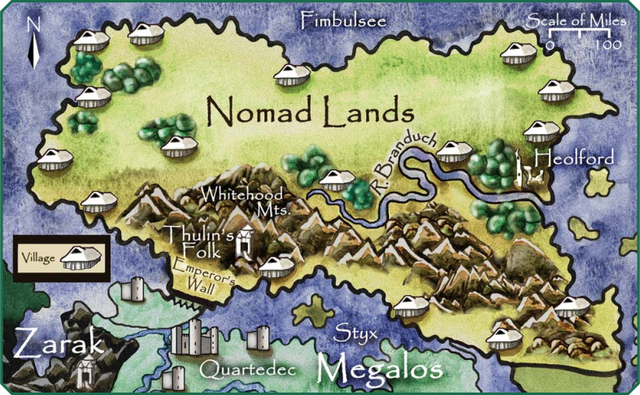
Chapter 4, Part 10: The Nomad Lands
Geography
GURPS Banestorm posted:
Megalans refer to the region north of the Whitehood Mountains as a land where huge hairy men and animals devour each other indiscriminately. As usual with civilized peoples' views of their less sophisticated neighbors, this is slightly over-simplified – but, in this case, only slightly.
Geography
Highland in the south, lowland taiga and plains in the north, all temperate or cold. It is an area where the mana frequently goes wild and there are larger prehistoric versions of animals such as beavers, bears, elk, and wolves, as well as monstrous legendary beasts such as gryphons, hippogriffs, and pegasi.
History
Very little is stated about the history of the Nomad Lands. Some Scandinavians of various sorts, Celts, and Mongols were dumped there, they were eventually attacked by Megalos and driven out of their homes, and then a warrior named Ross Gatecracker united a bunch of clans that pushed back Megalos so hard that they had to build the Emperor's Wall to keep the Northmen back. While some modern coastal Northmen have begun to trade with other nations, the vast majority are still either barbarian raiders that viciously attack Megalan settlements or mercenaries that sell their swords to the highest bidder.
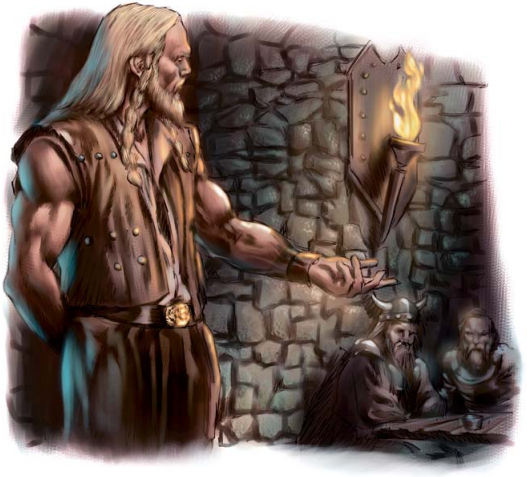
Society
Most Northmen are semi-nomadic, traveling to engage in raids or herd their livestock before returning to the village or hill fort of their clan/tribe. Some tribes and clans treat women as property, some are egalitarian and sexually equal, and some are even Amazon warrior groups. Som, but not all, tribes keep slaves, typically women taken in barbarian raids on Megalos.
Social Position
Each tribe is lead by a chieftain, sometimes instead known as a jarl. Beyond that, warriors, sailors, shamans, smiths, and skalds are all considered to be honorable professions for men, while hunters and gatherers are Status 0 losers that are considered to be necessary but dishonorable men. Women either have their husband's status in equal tribes or Social Stigma (Valuable Property) in misogynistic ones.
Nonhumans
The largest nonhuman group in the Nomad Lands are Thulin's Folk, the dwarves that dwell beneath the great Whitehood Mountains. They are lead by the venerable Thulin X, a 265 year old dwarf whose immense age rewards him veneration even by the High King. Thulin has grown to hate Megalos, and on top of refusing to trade with them in favor of sending caravans to the Northmen, Caithness, and Sahud, he even attempted to get the kings of Zarak to boycott the Empire entirely. There are also several giant clans up in the far north, which freely trade with the Northmen out of a mutual sense of understanding and respect from each group for the other's strength and straightforward no-nonsense approach to life. Thanks to the local wild magic, there are also a load of werefolk – that's werebears, wereboar, were-eagles, were-snakes, weretigers, and werewolves, which we'll learn about when we finally get to the next chapter – in the Nomad Lands, though they tend to stay far out in the wilderness due to all the superstitions that surround them.
Magic
When Northmen practice magic, it's typically in the form of rituals meant to invoke the elements, divine truth from the gods, or call on the elements. Healing magic is seen as effeminate and frowned upon, as is using magic to get the upper hand in direct melee combat. Non-shamanic local mages are referred to as "witch-folk" or "rune-carvers" and are typically seen as eccentric but ultimately honor-bound folk. Foreign wizards are almost always seen as suspicious and are sometimes directly challenged by witch-folk or shamans are "rivals" or interlopers.
Northmen Religion
The Northmen are pretty lax pagans, typically following Germanic or Norse deities. They acknowledge the God of the Abrahamic faiths, but don't see him as anything special or more powerful than their own panoply of deities or the deific spirits over in Sahud. It is believed that every man is marked with the Wyrd, an unknowable and unchangeable destiny that they all march toward with open arms, which is why so few Northmen fear death. The religious leader of a tribe or clan is known as either a shaman or a druid depending on whether or not the tribe in question is heavily Celtic. On top of having all that ritual magic knowledge, shamans engage in blessing warriors on the eve of battle, conduct marriages, perform animal sacrifices, and lay down the restless dead when they manifest.
The Law
Various tribes have varying social taboos, which aren't really mentioned in spite of the fact that you'd think that's what the section called "The Law" is here for. Matters that affect the entirety of the tribe are deliberated by the chieftain and his most trusted warriors, while interpersonal matters are solved either by a selected third party arbitrator or through a duel. Punishment for minor crimes comes in either financial compensation or public shaming, while serious offenses lead to death, slavery, or exile.
Skalds
Because of overall illiteracy beyond the use of certain symbolic runes, the Northmen have developed a strong oral tradition, emphasized most heavily by the presence of the skalds. They are not unlike the bards of the Abrahamic lands, being travelers that have expertise in music and the performing arts. A skald learns numerous ballads, folk tales, stories from foreign lands, genealogical trees, and clan histories that they augment with their own songs and poems that venerate new warriors and leaders of the present day. Skalds are considered divinely gifted, and benefit fairly strongly from it: not only do they have the Claim to Hospitality advantage in Northmen homes, it is considered a grave misdeed to kill a skald unless it is in an act of self-defense, netting the offender a hefty Reputation penalty.
There is also a page of stats for a 313 point skald named Blind Lars. A middle-aged Northman with a tall but lean frame and flowing blond hair, he is a skilled traveler in spite of his blindness and has been to almost every corner of Yrth. When Blind Lars talks, people listen, and he is very rarely without traveling company.
Next Time in GURPS Banestorm: We finally end chapter 4 with a trip to the desert kingdom of the djinn and the realms under the sea.
Chapter 4, Part 11: The Southwestern Wilderness
Original SA post
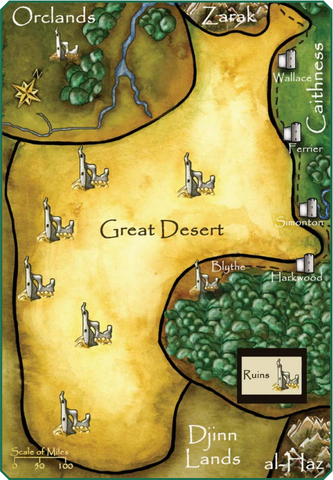
Chapter 4, Part 11: The Southwestern Wilderness
The "Other" category for land portions. We're down to the parts where we don't even get the Geography and History sections, and even the Nomad Lands got those.
The Great Desert
It sure is a desert. Probably not all that great, though. The only things that live out in its mana-void and desolate stretches of shifting sands are monsters and tribes of traveler-eating reptile men. There are also scattered elven ruins from the time before the Bane scoured the landscape, which sometimes still have arcane lore stuffed in their depths.
The Southern Plains
Technically part of al-Haz on paper, but not in any real governing capacity, the plains west of the great mountains are home to nomadic Muslim tribesmen. Their existence is technically a Hazi state secret, as is the border with the Djinn Lands in general, but some Caithnesser merchant caravans and Cardien trade ships have managed to force their way around anyway and reached these tribes to trade with them for copper, ivory, and glassware. They'll tell anyone who wants to go to the Djinn Lands that they're crazy and need to go home immediately, though, as some things just aren't worth the risk even after you've braved the Hazi border patrols.
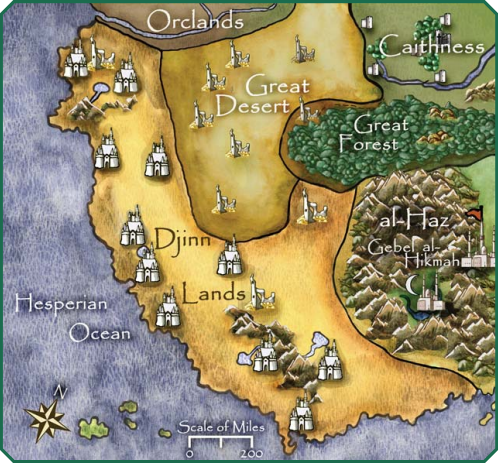
The Djinn Lands
And speaking of the Djinn Lands, here it is, at least. Those scant few who have gone into this forbidding land of open desert, craggy mountains and wadis, and salt lakes and lived to tell the tale bring back stories that say the djinn are human – ridiculously powerful in their magic, beyond almost anything else known in Ytarria, but human nonetheless. Of course, the truth is more complicated.
The Creation of the Djinn
The truth of the matter is that in the time before the Bane, there was a strange sect of elf archmages in the southwestern forests that sought to shed the shackles of the flesh and become unto as gods (only not quite, because elf religion has no concept of deities). They certainly succeeded, but not to the extent they had hoped. While these elves had become energy beings with phenomenal power and dubbed themselves "Ascended Ones", they were ultimately still tethered to their meat suits, being forced to remain close to them in order to still draw out the mana of the land to fuel themselves. For centuries, they waited and watched, trying and failing to tempt elves and dwarves that traveled their way into a pact wherein the Ascended One would ride within their body. And, even as desperate as they were, no Ascended One would dare desecrate themselves by taking on an orcish vessel.
Humans as Vessels
The Ascended Ones' big break finally came through the Bane ritual and the first Banestorm. Muslim tribesmen that encountered the phantasmal elves called them djinn, as there was nothing else that came to mind to compare the strange entities to. The Ascended Ones found humans a bit homely but ultimately servicable to their causes and a handful of the humans found the Ascended Ones' offers to live together in immortality appealing, and thus a pact was formed. The two species merged into one, each Ascended one and tribesman fusing into a gestalt consciousness capable of immense magical power and truly became what is now known as a djinni. Most djinn are still practicing Muslims thanks to the curiousity and tolerance of their elven half, though a few have had their human half pushed to follow the path of secular thought by particularly pugnacious Ascended Ones.
Effects on Mana Levels
Ultimately, however, djinn are chained by their own past. The rituals used to originally create the Ascended Ones sapped the mana around their mummified elf corpses and continue to leech it from the very air they breathe to maintain the arcane link that allows their existence. They typically build their castles in nearby high mana areas but keep extensive wards and other magical defenses and a handful of mundane traps within the ancient buried ruins that house their original body, for destroying it would dispel the ritual and kill the Ascended One.
Retinues
The area around a djinni's castle is a community unto itself, made up of the descendants of servants that they have gathered over the centuries. These retinues are made up of craftsmen, warriors, entertainers, and concubines that are well-treated but ultimately seen mainly as pawns in the djinn's greater schemes. While djinn usually use magical contraception when engaging in "the pleasures of the flesh", some djinn-human hybrids have been born. While a few have arcane markings that show their heritage, most of these individuals are indistinguishable from a normal human wizard.
Djinn Contests
Millennia of being an energy being can sometimes be boring. That, along with the consideration of the limited real estate in high mana patches, has lead to the djinn often playing games with each other. Unfortunately for their warriors, these "games" are often war games, staging two armies against each other in blood-spewing competition. While this is ultimately not all that different from any other feudal nation in Ytarria and the warriors accept their place in the scheme of things, it is nonetheless disturbing when you realize how minor they treat the affair of having a whole troop of men march to their potential deaths. Other djinn contests will actually involve two of the djinn themselves or selected champions doing some sort of test of skill or athletic competition, which fortunately doesnt' lead to anyone's violent demise.

Chapter 4, Part 12: The Oceans
The Ocean Environment
Finally, we reach the ocean at the end of our chapter-long journey. Most of the ocean on Ytarria's continental shelf is warm, shallow, and filled with life. Vibrant coral reefs are found throughout Araterre, and throughout the region there are numerous fish, shellfish, and crustaceans. Beyond is the abyssal plain, a realm of shadow and strange creatures that are sometimes so freakish it's assumed they have to be magical in origin. The waters of the continental shelf are mostly normal mana with spots of low mana, while the abyssal plain is low to no mana with strange patches of very high or even wild mana.
Adventuring Beneath the Waves
Assuming you aren't playing a sea elf/merfolk/shark man party, how the hell do you work Ytarria beneath the sea into anything? Beyond some really crude diving bells, there's not any diving technology that gets past the Ministry of Serendipity, so that's right out. The answer is magic, of course, you silly. The Breathe Water spell lets you do the whole "not drowning: thing, while Swim and Walk Through Water are spells that get you past the issue of movement. The greatest challenge lies in water pressure, the continental shelf requiring Pressure Support 1 and the abyssal plain Pressure Support 2. There are no spells as-is that do this, so GURPS Banestorm handily offers that "Generous GMs" can optionally rule that Breathe Water comes packaged with providing Pressure Support 1 as well.
The Sea Elf Tribes
GURPS Banestorm posted:
Of course, a water-breathing sibling species to an air-breathing, apparently-mammalian race makes little sense in scientific terms. The most likely explanation is that they were created by some very ancient act of magic.
Magical origin or not, sea elves have been around since long before the coming of humans to Ytarria, and once had vast cities and farming towns all around the continental shelf. Unfortunately, their cities were built around high mana zones, and when the dark elves unleashed the Bane these were ripped to shreds its arcane feedback. Tens of thousands of sea elves died, and the species as a whole has never forgotten nor forgiven the worst of their land-dwelling cousins for that incident. The survivors were slammed all the way back to the Bronze Age and forced to adopt a nomadic tribal lifestyle. It's only recently that they've been able to sustain a population large enough to begin rebuilding settlements and advancing their technology once again.
Yrth Dolphins
Also known as "your reminder that this setting was originally written in the 80s". Sapient dolphins are probably Yrthian natives, but nobody's really 100% sure. They don't use technology or magic, they don't create structures or tools, and are pretty much just dolphins that happen to be able to hold a conversation. Most are friendly, but there are individuals that succumb to the same vices that any sapient species does.
The Banestorm Underwater
Just as Banestorms appeared above the waves, so too did ones below. One was so powerful that it never dissipated, instead becoming the source of power for the Maelstrom near al-Haz. The Maelstrom is so strong, however, that anything that gets teleported through it just gets ripped to shreds, save for the very rare sea monster that is so large and durable that it can get through battered but not broken.
Merfolk
The merfolk have a tribal culture that is either nomadic or village-based, with Stone Age technology that utilizes stone, bone, and seashells for crafting. While they are respectful of their village elders, merfolk as a whole are vain and self-absorbed, only sometimes making friends with other species. Those who have magical knowledge typically select spells from the Illusion or Mind Control colleges and use them either out of self-defense or just to amuse themselves (sometimes at the expense of others).
Shark Men
The shark men have an honorable warrior culture led by individuals that the Sahudese refer to as samurai. Their tribes have Stone Age technology and little knowledge of magic, seeing it as most likely dishonorable on the field of battle but at the same time useful on practical terms and sometimes pleasing to their eldritch gods. Almost all shark men are found off the coast of Sahud; those that aren't are almost always going to be exiles, who are dishonorable and often have no qualms about killing other sapients to eat them.
Beyond the Waves?
Nobody knows what's on the other continents of Yrth beyond Ytarria. Teleportation spells are out of the question, and a combination of ferocious storms and wild mana makes conventional or magical sailing tricky as well. Of course, in a metacontextual sense, there's the far simpler explanation that the writers of the setting wanted to give the Game Master the freedom to put whatever they want on however many other continents might exist. The game gives a few ideas as well, including a nation where goblins rule over a slave caste of humans, a continent the Banestorms never touched that is still ruled by elves, and a land of wild magic overrun with demons.
Next Time in GURPS Banestorm: Chapters past 4 actually exist! Chapter 5 is all about characters, including dealing with advantages on a modern character entering a Medieval setting,
Chapter 5: Characters, Part 1
Original SA post
Chapter 5: Characters, Part 1
Welcome, finally, to the chapter meant to be directly of use to players in creating their characters. I'm still genuinely unsure why GURPS setting books seem to like having the player information be after the GM information, especially when you have to go all the way to page 182 like you do here. Wouldn't it be more sensible to have that kind of thing up front and center like you see in most Dungeons and Dragons titles? Oh well, I don't work for Steve Jackson Games, so I'm sure there's some arcane methodology to this manner of layout that I'm simply not privy to.
Starting Points
Like 3E setting books before it, GURPS Banestorm provides a sliding scale of power levels – and, subsequently, point buy cost totals – that you can utilize in the world of Yrth. Just as the idea of setting books such as GURPS Banestorm in the 4E era quickly died out with the 4E era in favor of "pre-built genre toolkit" titles such as GURPS Dungeon Fantasy, GURPS Action, GURPS Monster Hunters, and the recently released GURPS After the End, so too did the idea of sliding point buy scales, those toolkit titles instead favoring a single power level. It's one of those little vestiges of the Third Edition mentality that stuck around for only a tiny bit of a time and stands out here like a time capsule. Regardless, the starting points are as follows.
- Ordinary Folks/Heroes by Necessity (25 to 75 points): At this level you're a bunch of village nobodies who are forced into adventure to survive. While this is primarily intended to be something for what the book refers to as a "gritty one-shot" rather than a full campaign, it also considers the fact that you could have a long-term series of adventures going further and further up in points as what started out as a necessary action turns into a profession.
- Heroes in the Making (75 to 125 points): The level of hometown heroes and greenhorn adventurers. This is the starting point where you're probably not going to die horribly to a wolf or anything, but there's still a large chance for monsters to kick your teeth in on a bad day.
- Professional Adventurers (125 to 175 points): This is the point where you are capable of "cinematic" levels of combat and are respected as actual adventurers. The book recommends 150 points to be the optimal level for a campaign.
- Great Names on Yrth (175 to 250 points): Congratulations, you're now a mid-tier Dungeons and Dragons character. You're both famous across the land and have the power, skills, wealth, or some combination thereof to back it up.
- Living Legends (250+ points): This is the point where you shed your bonds and become a full-fledged high fantasy character. Living Legends are the people who go out and slay dragons, punch wizards, and generally do amazing feats of heroism. Of course, everything's relative. According to GURPS Dungeon Fantasy, this is the type of point buy a standard Dungeons and Dragons-style character should have, and GURPS Monster Hunters assumes that your gonzo high urban fantasy action heroes are going to be using packages of 400 to 450 points. Turns out that different authors have different opinions on how to define power scales, who knew.
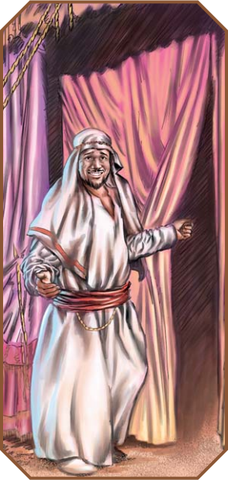
Designing Characters
This section is basically "what traits should I/shouldn't I take on Yrth?", which is one of those things that's valuable to someone actually playing but not so much to someone just reading, so let's summarize it and move on.
Advantages
The big thing here is technology. Not only are you going to be spending points on the High TL advantage because your home Tech Level is suddenly super-advanced, but going out in the open with an AK-47 or an Abrams tank (assuming you somehow got an Abrams tank through a Banestorm anyway, just work with me here) means every archmage on the continent wants you murdered, mindwiped, or mindwiped and then murdered for good measure. Due to the lack of world-hopping in the setting, the world hopper advantage Jumper is banned, or simply has a -25 penalty to rolls if you are combining GURPS Banestorm and the GURPS Infinite Worlds setting. Power Investiture (basically D&D Cleric god-magic) is also verboten, as all magic on Yrth is either of the wizardly variety or a Mysticism power regardless of whether you are faithful or not.
There are a few new advantages as well. Social Regard (Good Neighbor) is a social advantage that has people regard you as a great neighbor who they wish to be friendly with and do small favors for, while the rest are talents. A talent, if you don't know, is an advantage that grants a +1 bonus per level to a cluster of skills of a certain theme, as well as a +1 reaction bonus with a certain group of people. The talents presented here are Born War Leader (bonus to a number of soldiering and tactical skills and better reactions with soldiers and warriors), Close to Heaven (bonus to theological rituals of various sorts and exorcisms and better reactions with religious academia), and Halfling Ranged Weapon Talent (bonus to skills related to bows and all thrown weapons and better reactions with archers; can only be taken by halflings).
Disadvantages
No banned disadvantages, but a fair amount of new ones, all of which are social disadvantages in one of two categories. For new Codes of Honor that dictate certain actions you have to take, there's Arab (never ignore an insult to you, your family, or your religion, be hospitable and kind to guests in your house), Elven (don't do needless harm to nature, be beautiful and elegant in all you do), Halfling (be a stereotypical Tolkien hobbit), Northman's (be truthful and honor your promises, seek bloody vengeance in open combat for the death of someone in your family), Sahudese (always strive to preserve face, dedicatedly follow orders, respect your elders and the spirits), Stays Bought (never turn away from a job you've already taken money on), and Theatrical (the show must go on no matter what, and you can bend the truth but never outright lie when on stage). There are also new Social Stigmas, which influence what others think about you: Perceived as an Animal (you are a sapient animal but few people actually know that, so they are likely to treat you as they would a non-sapient member of your species), Barbarian (a variant of Minority Culture for someone who is "the other" somewhere else rather than a likely present minority), and Known Criminal (a variant of Criminal Record where you are actively branded with some mark or wound that says you are a criminal).
Skills
Alchemy and Chemistry are one and the same in the world of swords and sorcery that is Ytarria, Astronomy still follows the same rules as you'd expect in a non-magical solar system, and any other science skill gets rolled up into one primitive pseudo-scientifical practice skill called Expert Skill (Natural Philosophy). You also obviously won't be seeing skills for technology that isn't around on Yrth unless you decided to keep them on your high Tech Level character rather than handwave them away as being lost for whatever reason or retrained or whatever excuse you'd make. Oh, and in perhaps one of the few mechanical moments that makes me give a
 , the skill Exorcism suffers a -8 penalty, or -4 if you have the advantage True Faith. This is explicitly stated to be so that it's inferior to casting the Banish spell. So...why not just remove the Exorcism skill entirely if you are that determined you want wizards to be the best ghost busters and demon denouncers out there?
, the skill Exorcism suffers a -8 penalty, or -4 if you have the advantage True Faith. This is explicitly stated to be so that it's inferior to casting the Banish spell. So...why not just remove the Exorcism skill entirely if you are that determined you want wizards to be the best ghost busters and demon denouncers out there?
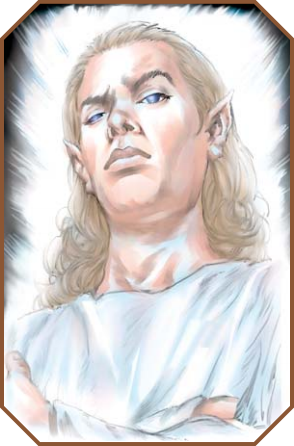
Nonhuman Races
While some of the species found on Ytarria that aren't humans were covered way back at the start of chapter 2, there are even more that apparently weren't special enough to be in the People of Ytarria exposé.
Djinni (627 Point Template)
The djinn are, as noted in the section of the Djinn Lands, actually a combination of a human vessel and a magic thought-elf called an Ascended One. The stats here specifically refer to the Ascended One, as the human part of the djinni is just a normal human wizard save for the addition of the Reprogrammable and Secret (Host to a Super-Powered Spirit) disadvantages. The Ascended One itself is a powerful being: small bonuses to Dexterity and Health combined with a big boost to IQ, Fatigue Points, and Hit Points, agelessness, no need to eat, drink, sleep, or breathe, immunity to metabolic hazards and most mind-affecting effects, incorporeality that is enhanced by still being able to affect corporeal objects with their touch, invisibility, and mind reading and possession powers. On the downside, Ascended Ones are isolationist, stubborn, and kind of dense when it comes to social interaction. While not an actual codified part of the template, all Ascended Ones are wizards and have lots of spells under their belt.
Dolphins (92 Point Template)
A sapient dolphin. They do dolphin things, but also sing long sea chanties in dolphin-speak and tell puns. Sea elves and merfolk are their friends, shark men are their enemies, and land dwellers think they're just regular dolphins. Mechanically, dolphins have a bit of a boost to Dexterity and Health and a large boost to Strength, have a great sense of direction and acute vision, can hold their breath for a decent amount of time, can use echolocation and ultrasonic hearing/speech, live somewhat shorter lives than other sapients, are impulsive and curious, have stone age technology, and have natural ranks in the Aquabatics skills.
Gargoyle (5 Point Template)
Gargoyles come from the desert world of Gabrook, just like goblins, hobgoblins, and kobolds do. Indeed, they even look like goblinoids with wings and scaly gray hides. Where goblins and gargoyles diverge even further than appearance is attitude, however: the latter are dim-witted layabouts that have eyes bigger than their stomachs, and few other species are willing to tolerate them. Some gargoyles find employment as thieves, but most are scavenging skulkers found either in the upper layers of densely packed cities or in the wild mountain ranges of Ytarria. The mechanics of the gargoyle involve a small penalty to Strength and IQ but a boost to Health, blunt claws, winged flight, damage resistance on par with an alligator or shark, excellent night vision, gluttony, ugliness, laziness, and a disdain for learning. A standard adult gargoyle is the size of a goblin, but those that survive to age 50 increase to human size, and the individuals that somehow manage to make it to a century old get to be Size Modifier +1 like giants. There are Strength and Damage Resistance increases with these size boosts, but just how much of a boost that is is left up to the Game Master rather than stated outright.
Insect Man (29 Point Template)
Remember the weirdly clever giant insects mentioned in the tour of Zarak? These are those. They actually look very human-like, face for their large bug eyes, bronze chitin, and antennae, so it's a mystery how the dwarves ever assumed they were regular insects. Another mystery is where they come from. It's believed that the insect men may have come from Gabrook, but the fact that they only appeared over the last ten years is particularly odd if that's the case. Regardless of their origins, the fact remains that the insect men are learning quickly, breeding quickly, and are coming ever closer to overrunning the dwarves on the edge of the Great Desert.
Stats-wise, the insect men have Strength and Health +1, the same damage resistance as gargoyles, silent movement, and racial telepathy through their hivemind for benefits, but have the drawbacks of being mute, shy, dedicated to their colony, unattractive, and uncomfortable when not in a group. The warriors of the hive have a 25 point template that is slightly different, with +3 Strength and +2 Health but -1 IQ, slightly more damage resistance, four arms instead of two, poor hearing on top of their muteness, a few decades shorter lifespan than most sapients, and a total lack of free will.
Intelligent Animals
Some other sapients besides the dolphins of Ytarria show up here. Oddly enough, they are in a sidebar and declared to be optional parts of the setting, ignorable by "GMs who dislike talking animals". One can only wonder why the Ecco race didn't get the same treatment. Anyway, three of these guys, so let's go over them quickly.
- Great Eagle: Giant bald eagles with bodies the size of a man and twelve foot wingspans, the great eagles are found up in the heights of the Bronze Mountains. They cannot speak any other species' language, but they have one htat involves a lot of screeching noises and body posturing. While typically not the kindest of creatures and very territorial, great eagles are strangely drawn to deeply religious individuals, and often seek to help them. A great eagle's stats aren't that surprising for a big eagle beyond an IQ score only a point less than the average human, having winged flight, sharp claws and an equally sharp beak, a loner mindset, and keen eyesight. Their main statistical anomaly is Sense of Duty (To the Pious and Very Holy), related to that whole thing they have about religious devotees.
- Noble Horse: Horses as smart as humans, found deep in the wilderness. While they can't speak, they have natural telepathy that allows them to communicate. Stats-wise, they're nothing to write home about. I mean, it's mechanically just a horse with no IQ penalty and added telepathy, what more can I really say?
- Wise Owl: These owls are big, but not giant – about the size of the real world Eurasian eagle owl. Their big gimmick (besides, again, the whole human or near-human intellect all these guys have) is that they can learn Elven and Anglish and also have the Intuition and Oracle advantages. Their ability to see signs and portents and figure out optimal choices to make has turned them into a species of feathery Mary Worths, taking delight in meddling in the affairs of humanoids that wander into their deep forest homes.
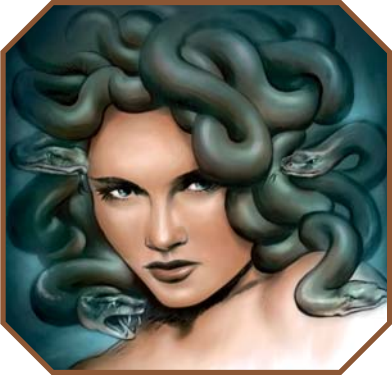
Medusa (139 Point Template)
Medusas are an always female species that may or may not be actually one of the Elder Races of Yrth that just got written out of the history books. They resemble elf, orc, or human women with snakes instead of hair, and have a 50/50 chance of either having normal skin colors for their apparent species or having the same color patterns as their snakes spread across their body. Medusas, unsurprisingly, have a petrifying gaze, and it's this gaze that has led to the medusas living deep in the wilderness most of the time. Turns out that those eye beams are actually hard to control, and accidentally turning people to stone doesn't get you many friends.
The medusa's petrifying gaze is straight up a normal "I make a Will check intentionally, you make a Health check in response, we see who wins" Affliction advantage in the standard racial template provided, which is stated to cover an experienced medusa. Medusas with less skill in handling their eye shots, however, suffer from having the Unreliable or even Uncontrollable limitations put on their petrifying gaze to reflect their lack of control. Other than her trademark ability, a medusa gets a small bonus to Dexterity, IQ, and Health attributes, an immunity to other medusas' gaze attacks, innate Magery, and a weak impaling attack with her snake hair that carries venom with it. A medusa's disadvantages are a dislike (but usually not outright intolerance of) other sapient species and the social stigma of being a monster.
Octopus Folk (239 Point Template)
A species human-sized octopus with human level intellects. Not much is known about them, as they tend to keep to themselves, but anyone trespassing near their lairs are typically warned off with sharp coral spears. They might be from Yrth, or they might have come in from Olokun, but nobody's really sure about anything with these guys.

Their mechanics are pretty much exactly what you'd expect from an octopus, with a sharp beak that carries a mild toxin, eight arms, color changing and elasticity, ink cloud production, regrowth of lost limbs, and a big streak of curiosity.
Sphinx (140 or 170 Point Template)
Sphinxes hail from Loren'dil, the same land as the halflings, centaurs, minotaurs, and giants. Sphinxes have several different breeds, but all have the same general body plan of a human head on a big cat's body. Most sphinxes are leonine sphinxes, which have lion bodies and the wings of eagles on their backs, but there are also pantherine sphinxes (extremely rare, with black panther bodies and bat wings) and tigrine sphinxes (tiger bodies and no wings at all). Sphinx forepaws have slightly opposable thumbs, allowing them to have somewhat clumsy but nonetheless present manipulative capabilities. Sphinxes are clever and love to learn new things, but also suffer from a murderous hunger and loner attitude, which often come in conflict. A potential prey item can win their survival by intellectually stimulating a sphinx, and some villages have even taken to feeding sphinxes some of their livestock in exchange for use of the sphinx's wisdom as both an adviser and a judge.
Sphinxes have a big boost to Strength and Dexterity and a small boost to IQ and Health, tough hides, sharp claws, good night vision, poor grip, curiosity (especially pronounced with intellectual pursuits), bloodlust, a solitary nature, and natural ranks in the Brawling and Running skills. Both leonine and pantherine sphinxes have winged flight for a maximum of 170 points, while the tigrine sphinx is the 140 point racial template due to a lack of that flying power.
Spirits
AKA the guys the Sahudese pray to. Spirits are found all over Sahud, manifesting as the genii loci of various things large and small. Spirits aren't so much a species as they are a state of being. All of them have the Spirit meta-trait, which means they don't eat, drink, sleep, or breathe, are ageless, and are invisible and incorporeal. Other mechanical traits are all "mosts" or "almost alls" rather than certainties: most spirits have a lower IQ attribute than humans but high Perception and Will attributes, a lot of them have Selfish and Proud disadvantages, and a vast majority of them have Dependency to whatever they are a spirit of. A sample template is given for a spirit of local springs, which has features such as water-only telekinesis (because this was printed before GURPS Powers, which would add the Control [Element] advantage to the game), the ability to heal blood and bladder disorders, and temperature control that only affects water.
Troll (171 Point Template)
Trolls resemble goblins brought up to the size of a giant, and are yet another species from the desert world of Gabrook. Strangely enough for being denizens of Fantasy Tatooine, trolls actively seek out wet, humid areas and are great swimmers. Those on Ytarria tend to live in semi-submerged caverns, deep and wet forests, under bridges, or in sewers, though the latter two locations tend to lead to them being hunted down by monster slayers pretty fast. Trolls are horribly violent misanthropes with everyone but their blood relatives, who they instead treat with care and will quickly avenge any harm done to them.
Trolls have a lot going for them mechanically. On the plus side, they've got a big ol' Strength attribute boost, decent HP and Perception attribute boosts, small boosts to the Dexterity and Health attributes, extra land and water movement speed, a great sense of smell, the ability to hold their breath even longer than dolphins, clawed hands and sharp teeth, leathery hides for damage resistance, a high tolerance for pain, D&D-style darkvision, particularly long arms, wound regeneration that is bypassed by acid and fire (but not limb regrowth, as those are considered two different things unlike in D&D), immunity to disease and fear effects, the ability to eat almost anything, and natural ranks in the Brawling and Swimming skills. On the downside, though, they've got -1 IQ and are bloodthirsty, callous to the feelings of others, isolationist, gluttonous, curious, vulnerable to fire and dehydration. Oh, and they eat other sapients, which is kind of a big social faux pas if you hadn't heard.
Next Time in GURPS Banestorm: The other half of chapter 5, as I actually ended up nearly coming close to the post length limit. Cursed souls and templates for occupations are coming up.
Chapter 5: Characters, Part 2
Original SA post
Chapter 5: Characters, Part 2
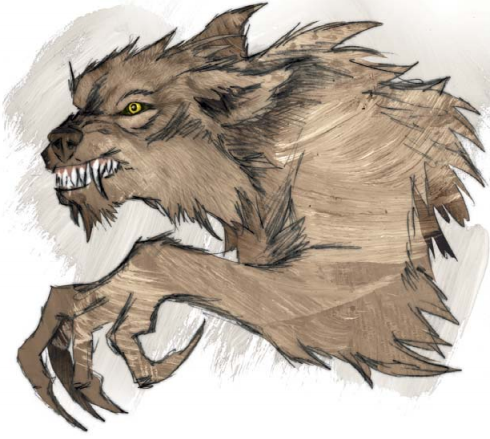
The Accursed
Sure, the Church may have ruled that medusas, sphinxes, and trolls don't have souls, but that's probably still better than being classed as one of the Accursed. These are the sapients that are seen as wretched souls wracked by a terrible curse at best and sinful, godless abominations at worst.
Ghoul (15 Point Template)
Ghouls are pale, toothy, hairless, and filth-covered humanoids sometimes incorrectly assumed to be undead. They aren't, and are in fact just a sapient race that happens to have a need to eat raw sapient flesh. While most ghouls haunt caves or the undergrounds of cities and prey on the dead, there are a few that have given the whole species a worse reputation by actively hunting and preying on travelers or the urban poor. There's an old myth that says ghoulism is contagious, but it's probably just a way to keep people from associating with them rather than actual fact. A ghoul's racial template provides +2 to Strength nad Health but -1 to IQ, are slower movers than most humanoids, have slightly thick and tough skin, dark vision, an immunity to disease combined with the ability to eat subpar meat, sharp teeth and claws, slightly quiet movement, natural ranks in Brawling and Stealth, a disturbing-sounding voice, ugliness, a reputation for being a filth-ridden people eater, and a diet limited to the raw flesh of sapients.
Lycanthropes
Not a species unto themselves, lycanthropes are instead members of any sapient species that suffers from a congenital magical disease that causes them to transform fully into an animal, both mind and body, every full moon. In spite of the picture the book provides, they don't have some beast-man form like werewolves in the World of Darkness or what have you: it's either all human or all animal, no in between; there are some that can learn to control their disease so well that they can remove the IQ score reduction and gaining of animal mental disadvantages, thus keeping their minds intact even in beast form, but even they can't take a hybrid form. Pretty much everyone sees lycanthropy as a curse for obvious reasons. The most common lycanthropes are werebears (turn into black bears), wereboars (turn into wild boars), were-eagles (turn into non-sapient and non-magical versions of the great eagle), weresnakes (turn into pythons), weretigers (turn into the bloody obvious), and werewolves (turn into timber wolves), but theoretically any animal can have a lycanthrope form.
Mechanically, a lycanthrope is just a member of any other sapient species that buys the Alternate Form advantage with the Uncontrollable, Trigger (Full Moon), and Duration (One Night) limitations. Each one points to the GURPS Basic Set's short section on animal entries and states that your alternate form is that "animal template"...which would be fine, if it wasn't for the fact that the animal entries in the GURPS Basic Set are actually shortform stat blocks and don't actually have point costs, advantage adjustments, or other things that make up a useful template. Alternatively, the book says, you can look at the animal templates from GURPS Bestiary, which is a Third Edition book and thus you'd need to do a little legwork to convert it to 4E. Either way, you have a bit of extra homework to do, so good luck.

Vampire (100 Point Template)
Vampires are an undead monster that can arise from any of the sapient species on Ytarria, resembling a particularly pale member of their species with long pointed canine teeth.. Vampires aren't necessarily evil, but they are always hunger-driven and more often than not rather amoral about their actions – the predator must hunt, after all, and sapients just happen to be the prey they're forced to take. A vampire can transmit vampirism through its bodily fluids, specifically forcing a Health roll to avoid contracting their curse with either a bite, a kiss, having unprotected sex, or having the victim drink their blood. Vampires with weak wills typically break down and feed indiscriminately, quickly drawing the attention of those that would kill them, which has the unintended side-effect of leaving only the strongest-willed and most clever vampires as the survivors. The smart vampire minimizes their chance of creating spawn, has a will of iron to press back the gnawing hunger until it is absolutely necessary to feed, and plots out the best routes in their home territory for stealth and evasion.
The vampire template provides a big boost to Strength and HP and a decent boost to Perception, a lack of a need to breathe and immunity to any metabolic hazards, less damage taken from Piercing and impaling type damage, good night vision, agelessness, body fluids that deal 3d6 Toxic damage in the aforementioned circumstances (and can also be reduced to 1d6 damage to make the chance of the victim becoming a vampire extremely low, because the Health save for that is tied to how much damage dice were applied), sharp fangs that siphon blood, an inability to ever be truly killed unless specifically killed with damage dealt by fire or wood, a need to feed on a sapient being's blood at least once a week, a gnawing hunger for said blood as well, a lack of HP recovery unless it's either regenerating from a pseudo-death or taken by sucking blood, a fear of running water, and the suffering of 1d6 damage a minute if in sunlight.
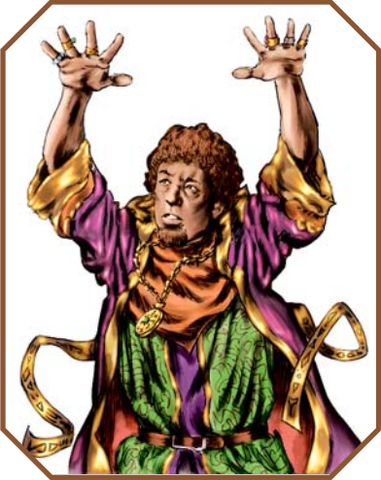
Adventuring Character Templates
Here come the occupational templates, ready and prebuilt for the player to peruse. Not gonna go into huge depth about them mechanically, as these things are meant to be somewhat modular pseudo-classes and all, but I'm at least going to give a basic description of each.
Assassin (125 Point Template)
You kill people for money or ideology. Lots of advantages and skills related to stealth, social interaction, and things that kill people swiftly and (usually) silently like poison, garrotes, and knives.
Bard (150 Point Template)
The traveling entertainers. The main Bard template is your non-magical "Face" archetype with a lot of social graces and various entertainment skills, but there's also a special 170 point variant called the Bard-Wizard for those who wanted a Bard closer to Dungeons and Dragons. They have Magery that is limited to requiring either singing or dancing to activate spells, and comes with basic knowledge of spells such as Haste, Itch, Lend Energy, Pain, and Spasm.
 Never anger the song mage, lest he dance up a seizure on you.
Never anger the song mage, lest he dance up a seizure on you.
Battle Wizard (150 Point Template)
More battle than wizard, these guys actually have a lot of options you'd associate with a knight, like horse riding, fitness, and swordsmanship. Of course, they do actually have a handful of spells to use as well, including Create Fire, Haste, Lend Energy, Minor Healing, and Shield, but they are more for a support position than the main brunt of their combat knowledge. While al-Wazif and Megalos are the nations most famous for their battle wizards, pretty much any nation that isn't actively thaumatophobic is likely to have at least a few. There are also wandering battle wizard mercenaries for those who aren't concerned about spending a little extra coin to help direct the flow of a battle.
Bounty Hunter (150 Point Template)
Those other guys who kill for money, only more in the open and somewhat more legitimately. The template's got a combination of advantages and skills that are focused on tracking, aggressive social interactions, stealth, and both lethal and non-lethal combat.
Charlatan (125 Point Template)
Basically a Medieval stage magician, the Charlatan occupational template can be used both for entertainers that play at being wizards or con artists that do so to prey on those who desire the aid of a magical individual. These guys are really good at both entertaining others, engaging in constant bullshitting, and being able to make a quick escape when things go sour.
Courtier (115 Point Template)
Some active servant of a noble court, such as a diplomat or a herald. Social skills out the wazoo, as well as some entertainment skills and even a bit of knowledge in combat with weapons associated more with the nobility such as sabers.
Entertainer (50 Point Template)
Like a bard, but less talented.
Freelance Wizard (150 Point Template)
Wizards that go around wizarding for cash. They have a fairly good number of spells, but only in one or two colleges, reflecting their nature as specialists who do a specific profession with their arcane arts. The specific types of freelance wizard specializations given in the template are Air and Earth with spells such as Earth to Air, Lightning, Purify Air, and Shape Earth, Body with spells including Clumsiness, Death Touch, Lend Vitality, Paralyze Limb, Spasm, and Wither Limb, Empathy and Mind with spells like Command, Forgetfulness, Hide Thoughts, Mind-Reading, and Sleep, Healing with spells that include Minor Healing, Major Healing, Purify Air, and Purify Water, Knowledge with spells such as Continual Light, Darkness, Mind-Reading, Sense Emotion, and Trace, and Water with spells like Breathe Water, Create Water, Destroy Water, Fog, and Shape Water.
Healer (150 Point Template)
Also known as hedge witches and physickers, healers are herbal remedy experts who also have some magic talents. This means that they have actual medical skills and knowledge of herbal pharmaceuticals, but also healing spells such as Lend Vitality, Minor Healing, Major Healing, and Sense Emotion.
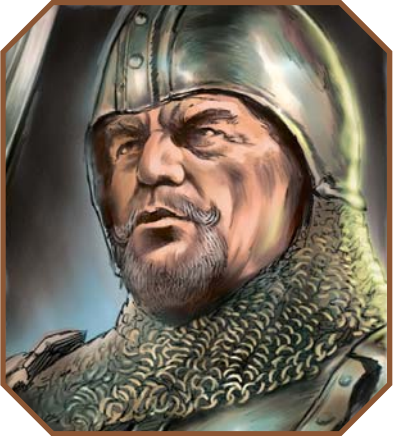
Knight Errant (150 Point Template)
A template shared by Christian knights, Muslim ghazis, and Sahudese samurai alike. This template makes you really good at both killing and not being killed, but also has a smattering of skills for the social graces.
Martial Artist (150 Point Template)
You are the one who is Kung Fu fighting. Or Judo fighting, as you can take ranks in either. There's also a few skills for weapons as well, and various martial arts techniques and feats of dexterity. There is a special lens, the Exotic Martial Artist, that is presented as well. This boosts the template cost to 250 and adds a bunch of wuxia stuff like extremely fast movement, extra long jumps, long lifespans, a sixth sense for danger, a chi blast attack, and various cinematic martial arts techniques.
Mercenary (150 Point Template)
The other other guy who kills for money. Mercenaries are soldiers for hire, and their stats reflect it, being more or less a knight with broader weapons training and the social skills replaced with survival ones.
Merchant (110 Points)
The folks who buy and sell goods. Lots of social skills, especially economically profitable ones.
Michaelite (150 Point Template)
As the occupational template name implies, this is usually for characters who are members of the Michaelites, though there are other unaffiliated proto-detective organizations out there as well. Michaelites are good at being sneaky, finding clues and sniffing out leads, interrogating perps, and getting into fistfights.
Mystic (110 Point Template)
Sufis, esoteric scholars, and weird desert hermits all fall into this category. They're good at religion and philosophy, reading others, wilderness survival, and sometimes a bit of combat skill in martial arts and/or staff-type weapons.
Northman Barbarian
Vikings. A template that's good for wilderness survival, water survival, and killing people.
Peasant Hero (75 Point)
Some farmer who got whisked way to adventure. Most of the class's skills and abilities focus on physical labor, farmwork, and animal handling, but there's also some upfront knowledge about common weapons of war to avoid having peasant heroes be useless at combat.
Priest-Wizard (130 Point Template)
A wizard from a Christian or Muslim priestly caste. On top of their people skills and religious training, the spells a priest-wizard can call upon include Apportation, Banish, Continual Light, Dispel Magic, Ignite Fire, and both Minor and Major Healing.
Swashbuckler (150 Point Template)
The dashing rogue who is good at fencing, seamanship, social interaction, and sexual encounters. Almost all swashbucklers are men at arms, romantic sailors, and light-hearted pirates from the Araterre region, though there are at least a few here and there elsewhere in the world.
Underground Engineer (150 Point Template)
These are the hidden cabals of people trying to bring about the Industrial Revolution in spite of the extreme dangers that involves. This template grants you Victorian era technological prowess, both in creation and utilization, but also means that there are a lot of angry wizards and the Ministry of Serendipity that want to either wipe your brain or just outright murder you and then break your fancy toys if you get found out, so it's definitely a case of walking the razor's edge if it's a player rather than an NPC using this template.
Urban Rogue (150 Point Template)
A template for any city-working criminal from a "gentleman thief" or spy down to the most gruff and uncouth of rabblerousing thugs. A lot of stuff for stealth, athletics, espionage, social manipulation, and killing here.
Watchman (150 Point Template)
Part of the town guard. This is a template that mostly focuses on combat and the more rough and tumble social interaction skills like Intimidation and Interrogation.
Woodsman (150 Point Template)
An occupational template that covers pretty much any wilderness-heavy occupation, from rangers patrolling a noble's forest and scouts to poachers and guerrillas. This one's got a ton of survival-related advantages and skills, obviously, as well as a bit of skills in utilizing various sorts of weaponry.
Next Time in GURPS Banestorm: Dragons and krakens and reeks, oh my! We cover the bestiary chapter of GURPS Banestorm, the second to last in the book.
Chapter 6: Creatures
Original SA post
Chapter 6: Creatures
As we near the end of our trip through GURPS Banestorm, we've got a brief trip through the bestiary chapter at last. Most of the creature entries are brief – a paragraph at best, assuming they don't have some special mechanics to have described – and there aren't a ton of them, but still, some monsters are better than none in my book.
Ordinary Wildlife
A brief section on a few Earthly animals that are now found on Yrth, on top of all the mentions of them back in the geography chapter.
- Bears: It says that most bears found in the forests of Ytarria are "European-descended black bears", which I assume is a typo and they meant European brown bears as there are not any black bears in Europe. There are also stories that might indicate grizzly bears and Pleistocene cave bears live in certain places as well.
- Big Cats: Pretty much just lions, and even those have been hunted to near extinction.
- Deer: Deer, mostly the European red deer, are found in the thick forests of Ytarria in abundance and are usually declared the property of local nobles.
- Wild Boar: These vicious pigs are found in large numbers in central and northern Ytarria, and are often favored targets of noble hunters.
- Wild Cattle: Feral cattle are rare, but nonetheless sometimes present.
- Wolves: Unlike on Earth, the wolves of Ytarria are still very widespread and sometimes bold enough to be dangerous to humanoids.
Vermin
Several species of animals considered to be pests followed humans to Yrth as well. Most notably, there are lots of rats, midges and mosquitos in wetlands, and plague locusts in the far west of al-Haz. There are also two fantastical vermin mentioned in this brief segment: the Yrth-native swamp thrimminy, a newt-like amphibian that is infamous for spoiling food stocks, and a rapid-breeding and aggressive swarming desert primate from Gabrook called the d'baajori.
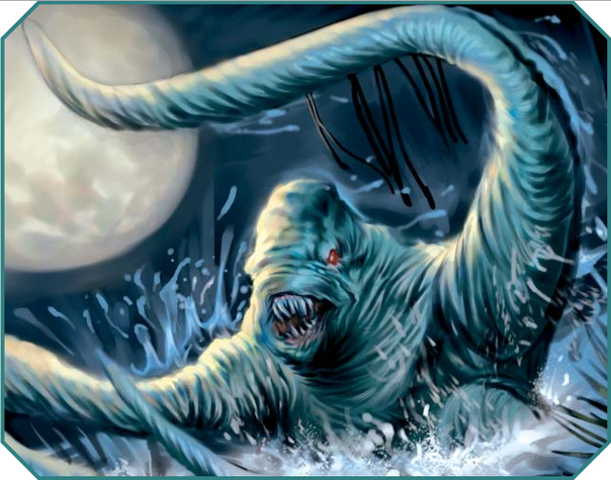
Fantastical Creatures
In spite of the name here, not all the entities in this segment are actually fantastical. Some are fantasy monsters, but there are also a few that are simply animals that the Europeans had never encountered by the time of the first Banestorm, either due to being extinct already or found in far-flung corners of the world.
Basilisk
A freakish chicken-headed snake found deep in the Great Desert, though even there it is exceedingly rare. The basilisk is capable of creating a psychokinetic assault that deals 3d6 toxic damage with a gaze, meaning that a number of precautions against it have been created. It is known that this gaze attack doesn't work through mirrors, that it doesn't work against weasels, and that the basilisk suffers psychological terror at the crow of a rooster or the scent of a herb known as rue. There are also unconfirmed stories of basilisks with wings and poisonous blood.
Bushwolf
Described as a marsupial with a wolf-like head, kangaroo-like back legs and tail, and tiger striping, it is pretty clear that the bushwolf is actually the thylacine, also known as the Tasmanian tiger or Tasmanian wolf. As the Europeans and Muslims of the Banestorm era had never even heard of Australia, these things were considered pretty weird when they were encountered in the arid badlands in al-Haz and al-Wazif. Bushwolves typically hunt small prey and are only rarely known to attack lone human wanderers.
Caustigus
The Acid Swamps of Solfor are thick bayous with acidic water found in the southern Orclands, which seems like something that would have been very interesting to discuss during the whole entry on the Orclands in chapter 4 rather than giving it so little attention. One of the very few things that live in this freaky wetland are the equally freaky monstrosities known as caustiguses. These amphibious and vaguely humanoid monsters lurk beneath the acid's surface, waiting to grab unsuspecting prey with their extremely long four arms and drag it down into the boiling depths. The caustigus has extremely powerful regeneration for everything except for its head, but cannot actively regrow body parts, which means hacking up its arms is typically the best way to win a fight with one. Caustiguses are also startled by bright lights and will quickly retreat from torches or spells such as Flash and Fireball.
Demons
From Hell they came...or at least from some plane very much like it. For reasons unknown, the demon plane is not entangled in the "quantum sargassum" that surrounds Yrth, allowing them to be easily summoned from or banished back to their nightmarish realm. While their appearance, powerset, and statistics can wildly vary, all demons are linked through their sadistic love of violence and destruction, being one of the only truly born evil things in the multiverse. It's generally a horrible idea to deal with demons, but some people do it anyway.
Giant Spider
Rarely seen and typically treated as something to scare kids with in bedtime stories, these man-sized trapdoor spiders are only found in the depths of the Great Forest and Blackwoods. They tend to rest in a near catatonic state for months or years on end until something big and potentially tasty makes a racket on top of their burrows. When that happens, the giant spider pops out in a surprise attack, grappling and attempting to sink its massive fangs into the prey item in order to deliver an exceedingly potent paralytic venom.
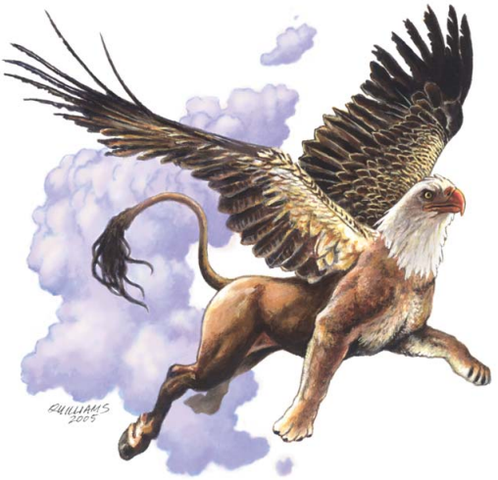
Gryphon
Part eagle, part lion, and all attitude, grypohons are found in the forests and mountains of the Fence of God, Great Forest, and Emperor's Forest. Gryphons can be tamed, but it's a dangerous task given that they will quickly turn their strong beak and wicked claws on anyone who doesn't show enough discipline.
Harpy
Harpies are large eagles with the heads and breasts of human women. In spite of their features, however, harpies are non-sapient beasts that are actually particularly crude, having a foul temper and compulsive need to spread their waste all over food, drink, and living things. Flocks of five or more of them are found flying around the badlands of al-Haz and al-Wazif, as well as in the mountains that dot the Great Forest and Emperor's Forest.
Hellshark
A giant shark, meant to be the giant extinct shark Charcharodon megalodon. Not much is stated about them beyond that they're big, voracious, fearless, and even boats and krakens aren't truly safe from them.
Hippogriff
Horse-gryphons from the Whitehood Mountains, hippogriffs are prized due to their rarity. Their feathers are used in alchemical elixirs and magic spells of unstated types.
Hydra
These rare cow-sized reptiles with one to sixteen heads are only found in the salt marshes of Cardiel, where they threaten any humans who come close to their lairs. It is unknown whether hydras are a natural or magically created species, or what they do when they aren't actively menacing travelers, and most people generally don't care as long as some monster slayer deals with them if they get too close to civilization. The greatest threat hydras pose is the fact that cutting off one of their heads leads to two growing back after ten seconds unless the neck stump is cauterized, meaning that a swift kill is difficult.
Kraken
Immense squid that range from 90 to 300 feet long. It is extremely rare to see a kraken surface, and even rarer for one to actually attack a ship, though it has happened enough times to give these deep sea cephalopods a terrifying reputation. It is unknown what the life cycle or daily activities of a kraken are.
Nightstalker
Nightstalkers are weird 15 foot long nocturnal bears that live in some of the forests of Megalos and Caithness. While they usually hunt large herbivorous mammals found in the same forests, nightstalkers love the taste of human flesh for whatever reason, and are willing to even knock down trees to get at people who attempt to climb away from them. An interview with Janet Naylor in 1990 listed the nightstalker alongside the bushwolf, hellshark, paladin, strider, and treetipper as being based on real world prehistoric creatures, but I'm genuinely not sure what one it would be. It's larger than even Arctodus simus, the legendary short-faced bear, so who knows.
Paladin
Like Pathfinder Bestiary 2, GURPS Banestorm has a glyptodont. Unlike PB2, Banestorm hasn't gone with the namesake of the clade and has instead given us what seems to be almost certainly the mace-tailed Doedicurus, called the paladin by residents of Ytarria. Paladins are dim-witted and simplistic creatures that trundle slowly across the plains of al-Haz with little regard for those around them. They know that few things will attempt to harass them, and those that do can usually be told off with a wave of their intimidating weaponry, so they take life in stride.
Pegasus
Shy winged horses from the Whitehood and Bronze Mountains, pegasi are actually slightly smarter than chimpanzees and particularly headstrong and evasive. It is impossible to train or break them like actual horses, and anyone with a pegasus mount has been allowed willingly to ride it and must never forget its willfulness, lest their steed turn on them.
Reek
Your standard fantasy ooze monster, these brown jelly blobs squish around in the dark and damp corners of Yrth. Touch one and it slithers to envelop you and drip digestive acid all over your tasty flesh.
Strider
Giant omnivorous birds with wedge-shaped beaks, most likely meant to be some manner of phorusrhacid. Striders are fast, skittish, and extremely dangerous if you force one to fight for its life, with both its powerful beak and huge toe claws being capable of making short work of a human's abdominal cavity. Most of the time, though, they use their arsenal to dig up underground plants and rodents in the badlands and plains of al-Haz, al-Wazif, and southern Cardiel. While you can technically domesticate striders, they're too dumb and easily startled for most tasks, and refuse to be ridden unless under magical coercion.
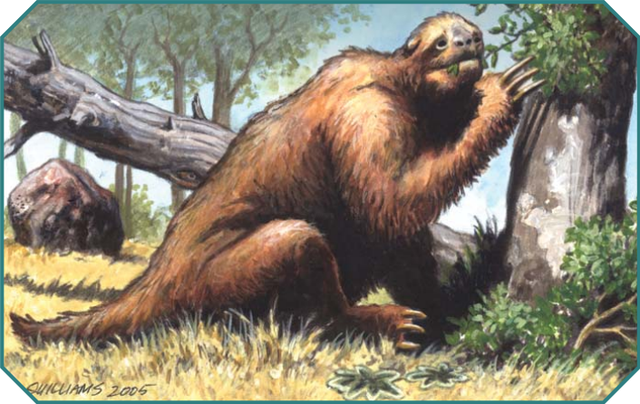
Treetipper
Giant ground sloths. Oddly enough, rather than the classic Charles R. Knight imagery of giant ground sloths, the treetipper art here has a two-toed sloth's head sort of awkwardly plopped onto a ground sloth body, which must have been an RPG art meme at some point as the same thing showed up in Wizards of the Coast's Dark*Matter: Xenoforms. While these huge, slow-moving browsers were once far more widespread and even popular game animals in Caithness, loss of habitat and human population growth have caused them to become extinct in most of their former range and hang on only in the Nomad Lands.
Unicorn
Legends say that unicorns are wondrous magical beings that have a weakness for virgins, refuse to be tamed, and may even be agents of the divine. In truth, though, they're just clever horned horses found only in the depths of the Great Forest. The only supernatural thing a unicorn can do is heal any poison through its horn, known as an alicorn. Alicorns are worth $100,000 of gold, but rarely sought or traded as elves love the unicorn and many pagans consider them sacred, with both groups often seeking to murder unicorn hunters.
Wyvern
A pseudo-dragon with two legs, wings, and a venomous barb on its tail. Wyverns are common in mountain forests such as those of Firuz in al-Haz but rarely get close to habitated areas. If human and wyvern do meet, though, these winged serpents make formidable foes: not only does their tail barb deal 1d6 toxic damage and a very long-lasting -4 to Dexterity, they have vicious claws and teeth and are fond of doing body slams to knock foes off their feet.
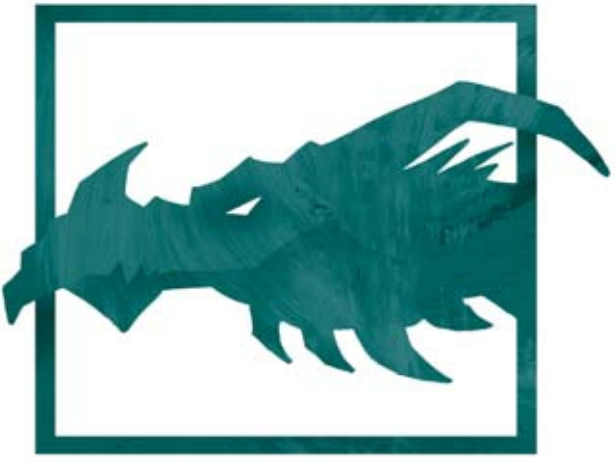
Dragons
Massive, mighty, and mysterious, the dragons have been around longer than even the elves and the dwarves – a Yrth without dragons is a Yrth none have experienced. They are born out of the egg already as large and as smart as a human, and they only get larger and smarter with age. And how old can one get? It's theoretically infinite, as they don't die of old age, but most dragons succumb to violence from either powerful warriors of other species or betrayal by one of their own in a vie for power. Also limiting the spread of dragons is that they almost never mate for pleasure or love and instead typically only create clutches of eggs as a way of sealing a political alliance. Oh, and they need to eat at least two cattle-sized animals a week unless they force their bodies into long periods of torpor, which most hesitate to do out of fear someone will take advantage of their vulnerability in such a state. That tends to limit sustainability as well.
Dragon society is one of great selfishness, wherein other dragons and the reptile men are seen as slightly inferior to one's self and all other species as lesser lifeforms that are either food, tools, or sometimes both. Dragons understand livestock rearing and other facets of agriculture but are too prideful to engage in it, meaning that they are either actively hunting food or plundering it from others. Most dragons hoard treasure for some reason or another, be it fascination, fear of scarcity, or simple greed, and dragons that gather together to usurp another of their kind will engage in decades of deliberation concerning the divvying of spoils from these hoards. Two dragons meeting peacefully are usually either scheming or sharing information for future schemes, though a scant few genuinely enjoy each other's company.
Dealing With Dragons
Pretty much everyone has a reason to hate dragons: they steal forests from the elves, gold from the dwarves, and cattle from the humans, and when things get too heated for them they just wing it to pillage from someone else or disappear into the wilderness and wait for the next opportunity to strike. It's no big surprise, then, that most people are skeptical when a dragon comes with its claws open in supposed peace, but some earnestly engage in bargaining or cooperation, albeit typically out of a desire for food or treasure in exchange rather than altruism. Even more surprising is the fact that some people will even approach a dragon rather than vice versa, typically attempting to persuade it to help in some war or grand scheme. If you're polite and have a big cart of gold with you, this might even actually work, and a dragon that is actually willing to pledge one of their fleetingly rare oaths never breaks it.
Templates
All dragons share a single meta-trait that grants them a powerful tail, winged flight, a penchant for isolationism, innate Magery at its highest normal level, agelessness, -2 Reputation with dwarves but +2 with reptile men, and a social stigma with non-reptile men as being horrible monsters. All dragons also have fire breath, claws, teeth, and damage resistance, but these traits get constantly upgraded to better versions as they grow. Racial templates are specifically provided for a man-sized hatchling at 29 points, 20 year old or so and 12 foot long young dragon at 133 points, 21 foot long and century-old abolescent dragon at 234 points, two century old and 30 foot long adult dragon at 338 points, and the extremely rare 444 point firedrake at half a millennium or more in age and 42+ feet of total length. The book also states that dragons as individuals can vary from this standard, pointing to the lenses for various dragon attitudes in GURPS Dragons as an easy way to reflect these. While not relevant at all to Banestorm here, GURPS Dragons is interesting in that it was the only dual-edition GURPS book, being both the last Third Edition book and the first Fourth Edition one – even before the GURPS 4E Basic Set! – due to having stats for both editions.
Dragons as Pcs
Since they have a racial template, you can technically play dragons, so the book cuts the question of "but what if my players want to be a dragon?" off at the pass. It notes that a hatchling is usually murdered by anyone from a band of orcs of a human warrior and adult dragons are treated with suspicion and fear, which makes an obvious problem for most campaigns. It is suggested that if you have a player that absolutely, positively wants to play a dragon, the best ways are either having an all-dragon game that focuses entirely on the constant political intrigue and treachery within dragon society or a "traditional sword and sorcery" (read: D&D) adventure out in the boonies where none of the party members care what species the other is because they care far more about getting fame and loot.
Domestic Animals
I'm not sure why this section isn't up there with the mundane animals rather than after the dragons, but whatever, here it is.
- Camel: With the original Arab nomads came their trusty dromedaries, and they are still found in the southern lands to this day.
- Cattle: Beef as a dish is pretty rare, but cattle themselves aren't. Bulls are typically used as beasts of burden and cows as providers of milk.
- Harding: A Yrthian native animal that looks like a tusked goat. These tusks are used to dig out food in the inhospitable wastelands they tend to dwell in, and they have been domesticated for their milk and wool.
- Horse: They exist. Mules and donkeys also exist. Both regular and heavy horse breeds are widespread, while some groups of tribesmen breed ponies.
- Milkfish: The Ytarrian name for manatees and dugongs. They're apparently easy to domesticate, which may very well be true but we'll never know because who the fuck wants to farm manatees in real life. Farmers keep and breed them for their fatty milk, oily fat, and rich meat.
- Woolen: Another Yrth native, this one being basically a sheep that always has black fur. How...exciting? They're somewhat hardier than Earth sheep, but neither species is kept more than the other and they share a general coexistence on the Ytarrian ranching scene.
- Small Domesticated Animals: Chickens, cats, doves, pigs, and pigeons of both the food and carrier variety are all around in Ytarria. Dogs are also quite common in most lands, though they are loathed as filthy scavenging beasts in al-Haz and al-Wazif. Two breeds called out are hunting hounds bred for knights in the Christian lands and one developed as a rare foodstuff in Sahud. Finally, various birds of prey from both Yrth and Earth are used for falconry and sometimes as anti-carrier pigeon weapons during war. Megalos restricts falconry to the nobility only but it's widespread everywhere else.
Next Time in GURPS Banestorm: It is the end, my friend. The GURPS Banestorm book ends with chapter 7, Campaigns of Yrth. Are you excited? This guy sure is:
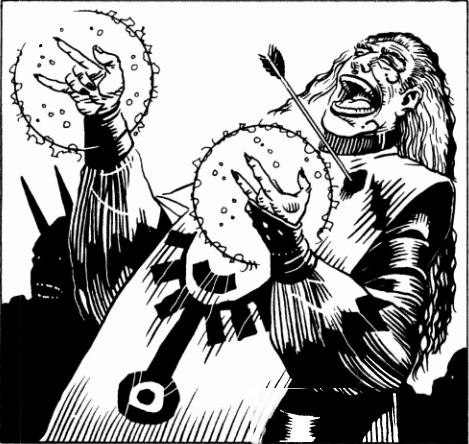
This is from the Campaigns of Yrth chapter of GURPS Fantasy 3E, not 4E's GURPS Banestorm, but I felt it would be a shame to not have it not appear anywhere.
Break Time 2: GURPS Fantasy Adventures
Original SA post
Break Time 2: GURPS Fantasy Adventures
Written in 1991 as a supplement for GURPS Third Edition, GURPS Fantasy Adventures is a set of four adventures that take place on the world of Yrth. Rather than delve deeply into each adventure piece-by-piece, I'm going to break down each adventure into its tagline from the book description and a brief summary of its events, what it adds to Yrth as a setting, some quotes for flavor, and my own personal opinions on it.
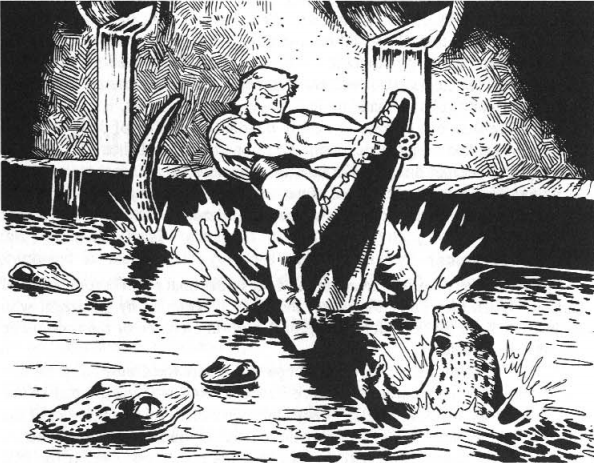
Adventure 1: Fighters of the Purple Rage
Tagline: "A hard-hitting bounty hunt that pits the characters against battle-hardened escaped gladiators. It's a dangerous chase through the Megalos underground . . . who will survive?"
Written by Chris W. McCubbin, who also wrote GURPS Aliens, GURPS Fantasy Folk, and GURPS Space Bestiary amongst other things, Fighters of the Purple Rage is meant for characters of 150 to 200 points. Eight gladiators have escaped from the Grand Elimination, a biannual massive gladiatorial fight to the death in the grand colosseum of Megalos City. These gladiators are an anti-imperialist guerrilla named Marlon, a fat but hardy eunuch named Cee who got thrown in the arena after he acted as a confidant for his noble mistress's affair with a young lover, a rather generic man named Floyd who went from professional gladiator to slave gladiator after killing a nobleman in a barroom brawl, a half-ogre named Groby who was imprisoned because his father was an orc and this counted as close enough for the Megalan Empire's "all captive orcs must be slaves or slain" law, a Nord raider in a horned helmet named Skuli, a young swashbuckling burglar named Jaim, a half-elf wizard named Nurrien who became a slave after a Megalan noble murdered her elf family and demolished their ancestral home to build a hunting lodge, and a bard named Reńe who was enslaved because he pissed off the Emperor with a drunken comment about his "recreational habits". Their escape was facilitated by a dedicated abolitionist named Simeon, who has led his band of fugitives into the labyrinthine and poorly-mapped underbelly that is the sewers of Megalos City – the Below. The players are assumed to be either spectators at the event or passersby that are drawn in by the emperor's decree that anyone bringing in some or all of the fugitives alive or dead will be given five gold marks ($1,000) a head.
All alleyways of information lead to the Limping Lion, a waterfront tavern where the heroes either get into a huge brawl with mercenaries and the tavern's ogre and minotaur bouncers (and the minotaur half of the duo has a glorious mullet!) or buy everyone in the tavern drinks on the house as a weird underworld initiation rite in order to gain information. From there, it's into the sewers where there are a series of altercations with alligators, angry swarms of homeless people, and eventually the face off with the gladiators and Simeon. The outcome of this is either they win the fight and get their pay, win the fight and then get backstabbed by the criminals who got them the information, lose the fight and get jack shit beyond a few hours of unconsciousness, or join with Simeon and attempt to sneak the gladiators past both the criminal syndicate that runs the Below and the Imperial Guard above.
New Things for Yrth
The biggest addition to Yrth's lore in this adventure is the Syndic, the syndicate that runs operations out of the Megalos City sewers. They are on a level beyond any of the thieves' guilds or groups like the Assassins and Hashashin, having been around for centuries and spread across every inch of Megalos City through its vast underworld, and are capable of being friend or foe because they literally don't care what you do as long as you're giving them money. The Syndic even allows simultaneous slaver rings and abolitionist underground railroads to pass through the same sewer tunnels as long as they pay their monthly fees. Even more unique is that the Syndic regularly hires necromancers, said by some to evidence that they are raising an undead army to protect their interests on top of the thousands of mortal laborers and agents they already have.
Oh, and the sewer alligators. Those are new.
A Quotable Selection
quote:
Harlots try to solicit the party. If refused, they follow the party for several blocks, decrying their cheapness.
quote:
The dregs are no threat to the party. These pathetic rejects of society can be treated as having 8 in all stats, with no advantages, but each with his personal assortment of strange diseases and stranger addictions.
quote:
If the party and the gladiators join forces, she's the most suspicious and unpleasant of the gladiators, and will likely react violently to any would-be human Romeos. On the other hand, if the party contains an elf, Nurrien will attach herself to the elf with near-canine devotion.
Is it a Good Adventure?
It's good enough, a simple standard fantasy adventure. It's kind of weird that it's assumed that the players will always be after the bounty rather than permitting some secret abolitionist fun from the very start, but there's very little about it you'd need to rewrite to facilitate that sort of quest.
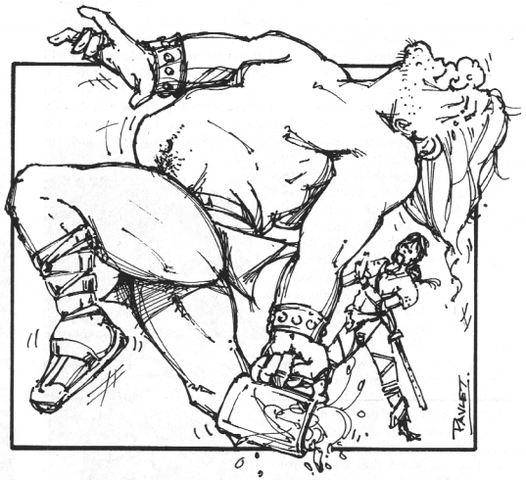
Adventure 2: Lost Inheritance
Tagline: "A magical trip into the Darkland -- a place of strange creatures and untold dangers. Will the PCs find the inheritance and collect the reward? Or will they fall to darkhounds or the obsessed apprentice mage?"
This adventure for 125 to 150 point characters (at least one of whom is recommended to be magic-aware, if not necessarily a wizard) is created by David Dunham, whose only other GURPS credit I can find offhand is a playtester credit for GURPS Aztecs. The adventure starts out in Cardiel's capital city, but quickly moves on after the heroes learn of a fairly hefty reward being offered to adventurers willing to undertake a quest in the nearby town of Tin Hill. A thunderstorm and flash flood, fight with an illusionist-lead group of bandits, and river fording later and the heroes get to meet the surly Tin Hill craftsman by the name of Oinet. Oinet's hiring adventurers to find his inheritance, hidden by his mysterious eccentric uncle Riyan before he died, and the reward is a fourth of the inheritance and any magic items that might be in it. Before they know it, one thing leads to another and it turns out that Riyan's kitchen closet is actually a portal to a dimension called the Darkland.
The dimension is a circular land drenched in perpetual night that is made up of consecutive perfectly circular rings of habitat: a ring of barren plains, then a ring of mountains, then a ring of barren wasteland, then a ring-shaped river, then a ring of hills, and finally a central circle where an ominous glow hangs in the air. The outer layers are trial after trial of battling both the forces of nature and the dimension's hostile wildlife, as well as an encounter with a giant who the players either negotiate with through song and dance or attempt to fight (the latter being specifically intended as the wrong option, surprisingly). The final encounter is with Quiann, a black-skinned and red-haired sorceress from a dimension of darkness. It turns out that old Uncle Riyan was a wizard who found out about the Darkland, a realm where there are constant dimensional leaks that throw detritus from all over the multiverse and the normal dimension restraints of Yrth are broken, and simultaneously summoned and bound Quiann there in an attempt to forcefully create company for himself out of loneliness. By using clues they had attained throughout the adventure, the heroes can release Quiann from her bondage and allow her to return home, a kindness that she repays by revealing Oinet's inheritance: $25,000 in gems, six magic circlets that ward off all of the monsters of the Darkland, and a waistband that allows up to seven people in close proximity to transport themselves to the Darkland at will at the cost of one permanent point of their Health attribute per transport.
New Things for Yrth
The Darkland, of course. It's a place where the biggest rule of Yrth is broken entirely, which makes it an immediate draw for anyone who wants to travel to other worlds or brng something to Yrth. The only problem is that any portal other than the closet connector requires a special cosmic password, though that just means you have an adventure in and of itself getting the arcane knowledge needed to operate the Darkland in the first place. The Darkland also introduces its native creatures, created by the same magic fuckery that forged the plane itself:
- Shadowcat: That name's a literal one, as these as lions made out of shadow. They feed on heat, and humanoid body heat happens to suit them just fine. Shadowcats take half damage from heat-based spells but double damage from cold-based ones.
- Giant Black Scorpion: Elephant-sized black scorpions straight out of a B-movie. It probably won't come as a surprise that being stung by one of these guys hurts a boatload: 2d6 impaling damage, and then a venom that renders a victim that can't fight it off comatose for 2d6 hours.
- Crazy: The crazies are weird white apemen with wild-eyed stares and drooling mouths. Their favored method of "attack" is suddenly ambushing in numbers, grappling opponents, and then screaming into their opponents' faces over and over again until the crazies are inevitably killed. They aren't out for blood, they're just...crazy, I guess.

- Nightwing: Vaguely bat-like flying shadows. Like shadowcats, these guys seek heat to eat.
- Black Eel: Technically black lampreys, but whatever. These guys swim throughout the river of the Darkland and will latch on en masse to suck your blood if you wade in.
- Darkwolf: A murderous blcak hound with red eyes and acidic saliva. These guys are said to be some of the most dangerous predators in the Darkland, attacking in packs and dripping right through damage resistance as they attack for no reason other than because they like to attack things.
- Brillet: Weird six-legged rat things. They can mimic speech, and specifically parrot one sentence they hear over and over again. Brillets are meant to be used as an extra way to convey random information to the players and have a list of pre-made statements to that end.
- Black Guardian: One of these guys stands at each of the bridges that cross the chasm around the inner circle of the Darkland. They're obsidian giants with four arms, two of which end in giant broadswords, and are only interested in guarding the inner circle and its portal. If you kill a black guardian, the other five immediately teleport to your position in an attempt to kick your ass.
- The Spider: The only way across the chasm other than the bridges of the black guardians is going across the titanic web of this black spider, which is just as immense as the black scorpions found in the wastelands. It's statisticaly probably easier to kill this guy than even one black guardian, but it has the advantages of lots of sticky webbing that heroes can get trapped in if they aren't careful and a venom that knocks you out for 1d6 hours while it wraps you up and prepares to suck your innards out like a Slurpee.
A Quotable Selection
quote:
Riyan's will made no provisions for Nringa, who, to be honest, is something of a shrew.
quote:
Grundge will not relate any useful information until someone in the party sings for him. Grundge likes to dance, and he asks the PCs to sing something. He gyrates clumsily to whatever tune the group can come up with (devious GMs will require their players to actually sing the song).
Is it a Good Adventure?
While it's not meant to be so character points-wise, this is a really good end game adventure for a Yrth campaign with people who were taken by a Banestorm in living memory. What greater accomplishment would there be than to find the fabled way back home? Of course, even if they aren't people who want to go back again, the Darkland nonetheless provides a different setting than most Yrth adventures, and can allow all sorts of crossover potential. It is a portal to all multiverses, after all.
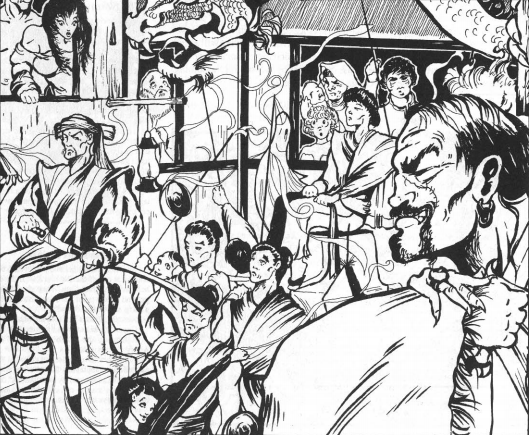
Adventure 3: Sahudese Fire Drill
Tagline: "Tired of the same old adventures? Here's a change of pace. Babysit a hundred screaming Sahudese while their clan leader visits Megalos. All you have to do is keep them safe and happy – while they tear the city apart . . ."
This
The plot of the adventure is that the heroes are hired by a Megalan merchant named Marcus Aurifactus to escort the Sahudese silk merchants of Clan Yarohito through Megalos City. This involves hilarious antics and dialogue such as "Wourd be gleat honol to meet today, but must pelfolm Lituar of Gakimaju filst," "excuse prease. Must stand on one foot, ol offend spilits," and "Herro. You all Malcus peeper? Humber serf is Yarohito Shimota. My peeper unship now".
...Jesus Christ, how was this written in 1991 and not, like, 1943?
Anyway, this clusterfuck eventually congeals into a three-way event with a summoned fire elemental conjured by an asshole Sahudese child mage, ninjas with smoke bombs that turn people into animals as a prank, and an attempted poisoning by a rival merchant house that doesn't want the deal between Marcus and Clan Yarohito go through. Things all smooth out in the end and the heroes can hopefully move on and pretend this never happened.
New Things for Yrth
No.
Quotable Selections
I was really tempted to just fill this one with all the gratuitous swapping of Ls and Rs, but I decided it would be better to highlight some of the other dumb shit.
quote:
A success locates someone who's actually met a Sahudese before. Make a reaction roll at -4. If the reaction is Poor or worse, the person merely shudders and walks away. A Neutral or Good reaction elicits the comment, "No. You don't want to know. Really, you don't."
quote:
There are lots of Sahudese retainers with the Yarohitos. And Megalans aren't familiar with their facial features, so the PCs will have trouble tellin various of the foreigners apart.
quote:
Because of their difficulties in telling apart the "round eyes", the Sahudese are fooled by the simplest of disguises, even accidental ones like ladies' cosmetics.
quote:
Naturally, when Sahudese speak Anglish, they do it with a horrible accent. Study 1940s and 1950s movies with Oriental characters as a model. Several Monty Python episodes also feature extremely phony-sounding Japanese accents. Try to emulate them.
quote:
After the characters have seen some of the Sahudese customs in action, they may feel that they understand them. Not likely! Every custom is hedged around with conditions and modifiers. The time of day, the phase of the moon, and the number of people present in the room are all good reasons to change the way a custom is applied. An honor in the morning may be an insult in the afternoon.
quote:
No Oriental character is complete without a few phrases of Oriental wisdom. Except the Sahudese - they have plenty of sayings, but it's very hard to extract wisdom from them.
Is it a Good Adventure?
Sahud was a mistake.
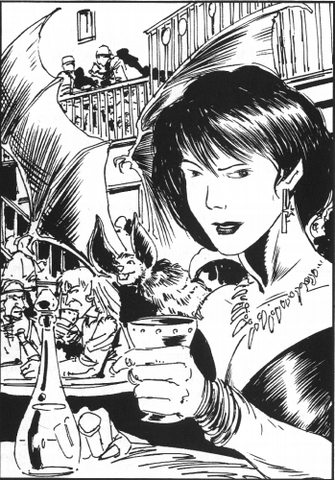
Adventure 4: Mordag's Little Finger
Tagline: "It's time to visit the Bad Side of Town. In this adventure, the party attempts to track down a clever master thief through the back alleys of the worst neighborhood in the city – Northside, where a meeting could get you choice information . . . or land you in the morgue."
David Pulver! Buddy! Good to see you. This adventure is meant for 100 to 125 point characters, and involves them engaging in questing at the behest of the Sorceress in Silver. A beautiful raven-haired woman from an unstated foreign region (and master of the Dreamworks Face if we go by the artwork), the Sorceress has made a name for herself in the Christian lands as an honest and God-fearing woman. The job? Find a thief and master of disguise by the name of Saragrave and take back the little finger of Mordag. Mordag was an evil giant mage slain by a legendary wizard, who took one of Mordag's finger bones and enchanted it into a staff. The staff was eventually acquired by the Sorceress and lent to her apprentice Maewen, but was stolen after Saragrave murdered her in cold blood. The trail begins with the tale of Mordag himself. It turns out that legend says that the slayer of Mordag was a legendary necromancer from the realm of Hordag Loi, who was rewarded with a Pale Tower in the rogue town of Northside by the local duke after saving his son from Mordag. The necromancer herself would eventually fall to the equally legendary blue dragon of Wye, while the duke's son would become a great warrior and father whose grandson now leads the duchy that Northside is located in.
Various adventures and misadventures with local ruffians, toughs, and even a bone golem lead to the Pale Tower, where it turns out that Saragrave is the thrall of none other than Mordag himself. It turns out that not only is he a giant mage, he's a giant vampire mage, and one with the lich-like ability to resurface again and again due to his finger bone secretly being a Soul Gem phylactery. In the end, the Sorceress is understanding if the heroes destroy the staff to end the menace of Mordag forever, but she will pay them far more for their efforts if they think outside of the box and figure out a way to both keep the staff intact and destroy Mordag's soul, such as using another casting of Soul Jar to pop him into some far less valuable object and then destroy that.
New Things for Yrth
Northside is an Anytown, Ytarria, specifically unstated in location beyond being somewhere in the Christian lands. As such, it can be retooled for any number of future adventures – hell, there even are some suggestions for using Northside past Mordag's Little Finger in the adventure notes. The Sorceress in Silver is also a powerful and potentially wonderful patron to have after you've avenged the death of her apprentice and gained her gratitude.
A Quotable Selection
None, really. It's a good adventure, but also kind of a straightforward and dry one.
Is it a Good Adventure?
Well, I just said it was, and I doubt I changed my mind in the course of putting in another paragraph. I'd definitely caution against throwing 100 point characters at this problem, though, in spite of the recommended character cost. Mordag's a very powerful foe even without his magic, and has the aid of a fairly durable thief and summoned demon if he wishes.
Campaigns on Yrth
Original SA post
Chapter 7: Campaigns on Yrth
Welcome to the final chapter of GURPS Banestorm! It's been a climb, but here we are, finally at the summit. The only way to go now is sliding down the final stretch that is this, the GM's advice chapter.
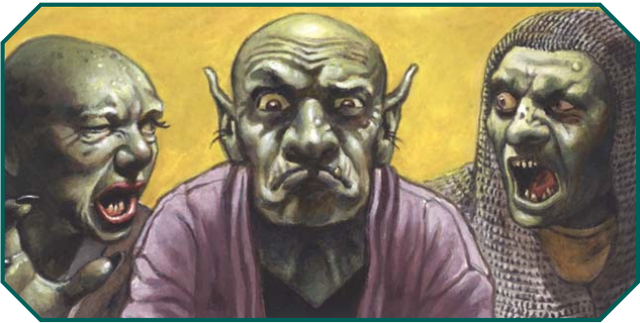
Game Styles
A bit more discussion on just what kind of play you want to do is put through a few more paces here. And in our brief list of styles, we have...
- High Fantasy: Large point costs, big adventures, and generally grand quests out in the rural and wild places where the world is your oyster or whatever. The Ring Islands and wild parts of Cardiel are marked out as two places particularly good for high fantasy adventures, as is Caithness if you don't mind removing the wizard equation.
- Low Fantasy: Very little magic, homogeneous cultures, and lower point cost. Want a character who breaks the mold? Go to something else, the book says, as your players should all be from the same area they are adventuring in if it is to be low fantasy. Caithness is recommended since it enforces the lack of wizards, but almost anywhere in Ytarria can be used for low fantasy.
- Swords and Sorcery: Muscular barbarian warriors duke it out with savage beasts and evil wizards in wild lands. Unsurprisingly, the Nomad Lands and Bilit Island are pegged as big places for these kinds of adventure.
- Dark Fantasy: Like low fantasy, but darker and edgier. The sins and flaws of the various nations are played further upfront and heroism is considered foolish if not done carefully and methodically.
- Epic Fantasy: Big things, but not necessarily big people. Grand voyages, legendary quests, and nation-spanning events but without the huge points and pointless slaying and looting of high fantasy.
- Comic Fantasy: Remember Sahudese Fire Drill? Now stretch that out into a whole campaign, maybe have it be French stereotypes in Araterre or Arab ones in one of the Muslim lands instead. Comic fantasy can also include campaigns of political satire or slapstick if you hate yourself slightly less.
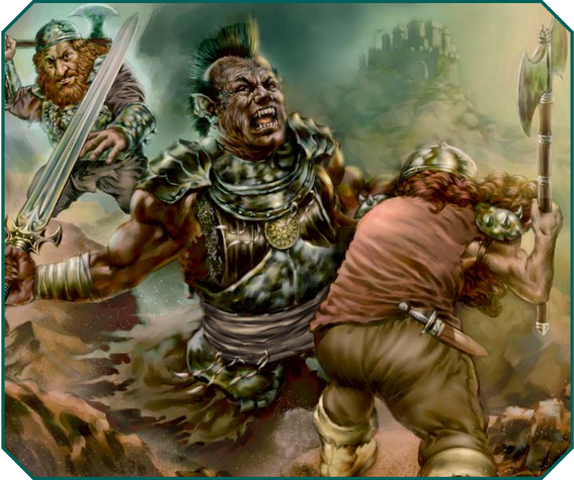
The PCs
On top of how you play, there's who you play, a question whose answers are meant to be aided by yet another series of vignettes.
- Professional Adventurers: Warriors, wizards, and thieves for hire. They adventure because adventuring's good business.
- Accidental Heroes: Your Luke Skywalkers and Bilbo Bagginses, people brought of their element and into tense and/or dangerous situations. Accidental heroes are usually low point buy but get more powerful over the course of their journey.
- Noblesse Oblige: High class individuals that adventure for the sake of their people.
- Banestorm Victims: Some 21st Century dopes that got pulled in. This has the benefits of a fish out of water story, but the drawback of having to deal with technology. The book also warns that "hip, pop culture-laden dialogue" may break suspension of disbelief for the players.
- Playing Yourselves: Banestorm Victims, but with the element of self-insertion added on top. This is very much a low point game where everyone has barely above-average stats at best, a smattering of skills, and maybe unlocked innate Magery if they are lucky. This segment gives some amazing quotes such as "remember, three evening classes at the dojo does not make a martial arts master, 'I never catch colds' doesn't justify HT 15, and having the good taste to play GURPS doesn't prove that anyone is IQ 16".
Magical Inter-World Games
GURPS Infinite Earths happens to be one of the only big hardcover-length setting books put out for GURPS Fourth Edition (with GURPS Mars Attacks and Discworld: the Roleplaying Game having finally gone to print, I can't say it's the only other one anymore) and the de facto setting for GURPS 4E as a whole, so it's not really surprising that there is a segment on crossovers between it and GURPS Banestorm. This breaks the normal rules of "no dimensional magic on Yrth. Ever. Ever ever ever", and instead makes it so interdimensional travel has a -25 penalty to the spell skill check. If you need to know more, buy GURPS Infinite Earths, available from Steve Jackson Games today!
Changing the World
In case you needed permission for some reason, this is the part where it says to the GM that it's okay to allow sweeping changes to Yrth through the actions of your players. Guns become commonplace in one or more nations? Sure! Find a new continent? Okay! Dark Elves do another genocide attempt? Why not, go for it, the world is your oyster!
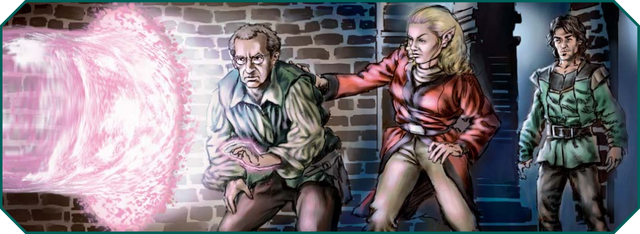
Epilogue: the Future of Yrth
GURPS Banestorm posted:
This book’s “present day” corresponds to our own world’s present at the time of publication. But time must move forward, on Yrth as on Earth. So history will continue, and things will change.
Next Time in GURPS Banestorm: ...There will probably be another interval mini-book look. But after that, we delve into dark places. Places that start out with content warnings about necrophilia. We may have left the main meat of GURPS Banestorm behind, but there's a decent-sized supplemental left as we enter the kingdom of the undead-loving (in more ways than one) Lazarite cult in GURPS Banestorm: Abydos.